PRESERVING HUMANNESS
WHERE BODIES & TECHNOLOGY MEET
 BY ERIKA CHOE
Copyright 2023 by Erika Choe
BY ERIKA CHOE
Copyright 2023 by Erika Choe
All rights reserved. No part of this publication may be reproduced, stored in a retrival system, or transmitted, in any form or by any means, electronic, mechanical, photocopying, recording, or otherwise, without the prior permission in writing from the author.
For inquires, contact erikachoe.com

Master of Fine Arts Thesis 2023

School of Visual Arts
Author, Designer: Erika Choe
Editor: Olivia Howard
As our bodies entangle with technology, how do we preserve our humanness?

“It might be a familiar progression, transpiring on many worlds – a planet, newly formed, placidly revolves around its star; life slowly forms; a kaleidoscopic procession of creatures evolves; intelligence emerges which, at least up to a point, confers enormous survival value; and then technology is invented. It dawns on them that there are such things as laws of Nature, that these laws can be revealed by experiment, and that knowledge of these laws can be made both to save and to take lives, both on unprecedented scales. Science, they recognize, grants immense powers. In a flash, they create world-altering contrivances. Some planetary civilizations see their way through, place limits on what may or what must not be done, and safely pass through the time of perils. Others, not so lucky or so prudent, perish.
Carl Sagan, Pale Blue Dot, 1994

”
THERE IS WHERE HUMAN WITHOUT


NO WORLD ARE WE NOW. TECHNOLOGY


HOW WE OUR IS CRUCIAL TO HOW

PRESERVE HUMANNESS UNFOLDS. OUR FUTURE

CONTENTS
12
There is no world where we are human without technology now.
Welcome to the Augmented Age
Navigating the Ethics of Human Enhancement
How we preserve our humanness is crucial to how our future unfolds.
What is at stake for the Individual
Preserving our Humanness for the Individual
What is at stake for the Collective
Preserving our Humanness for the Collective
Closing Thoughts
Afterward by Olivia Howard
References
Acknowledgments
13 Introduction
p15 p315
p28 p72 p35 p85 p177 p53 p125 p243
p329 p333 p343

PRESERVING HUMANNESS
INTRODUCTION
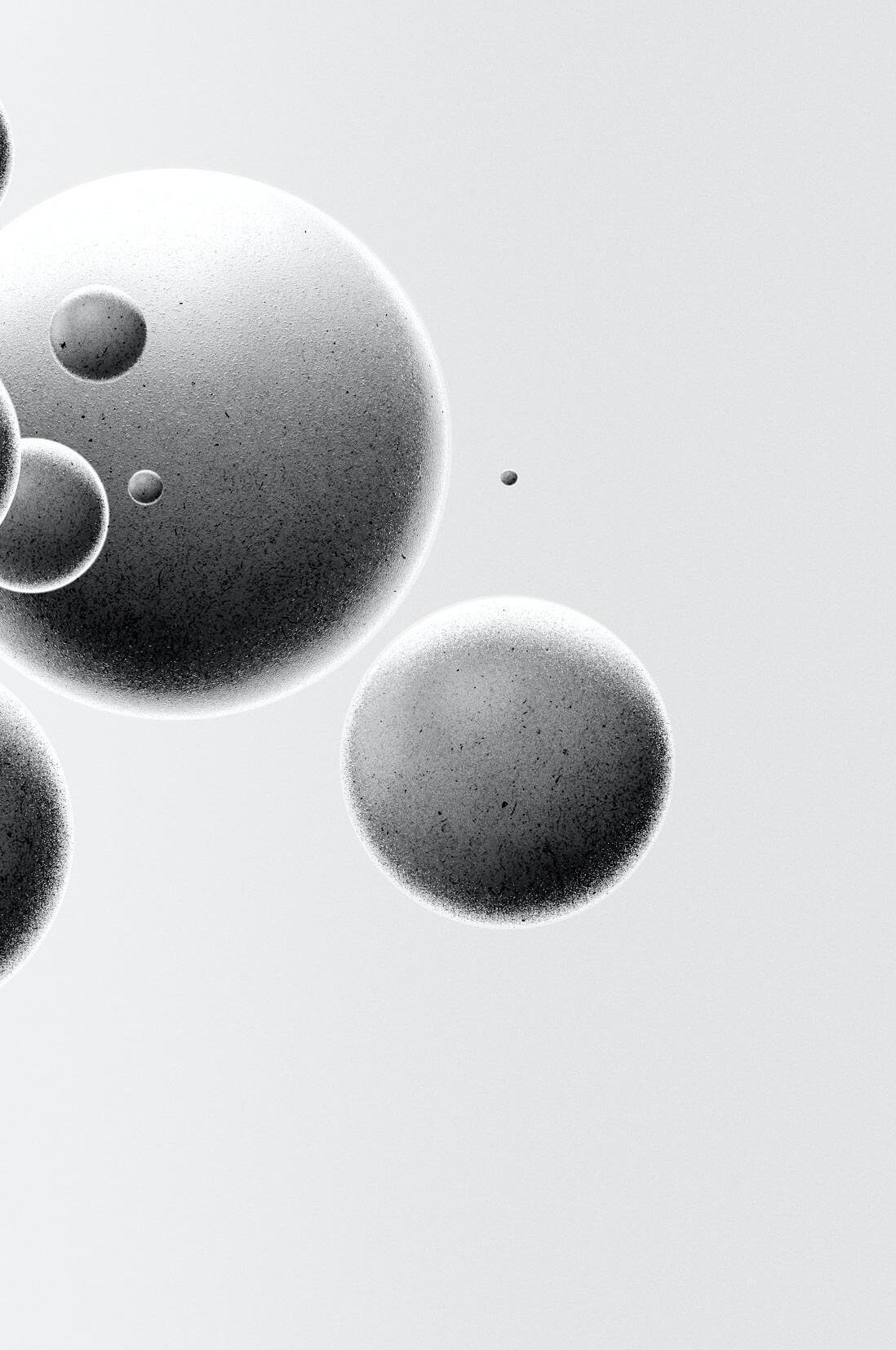
INTRODUCTION
What is at stake when our bodies and technology meet?
How do we localize and safeguard our humanness?
As a designer and movement artist, my work sits at the intersection of technology and bodies. Technology is at the center of my design career, it’s how I create and execute design and is also the focus of my research. The body is at the center of my artistry. I work with, and think about the body constantly – questioning why we feel the way we feel – muscle, bone, skin, sensation, emotions, motivations, passions, and triggers. These two areas of focus have guided my research and led me to explore what happens when our bodies and technology meet. And beyond that, to contemplate how we localize and safeguard our humanness in a time of rapid technological innovation.
Humans have always been deeply entangled with technology. From the first stone tools to modern phones and computers, technologies that surpass our physiological capabilities and enhance our experience of the world have shaped human history.
Technology makes what was impossible, possible. And while this can often be positive, it also holds its dangers. Carl Sagan’s 1996 book The Demon Haunted World, shares haunting fears of a technological monopoly that strips us of our agency, and consequently ourselves.
16
PRESERVING HUMANNESS
“I have a foreboding of an America in my children’s or grandchildren’s time -- when the United States is a service and information economy; when nearly all the manufacturing industries have slipped away to other countries; when awesome technological powers are in the hands of a very few, and no one representing the public interest can even grasp the issues; when the people have lost the ability to set their own agendas or knowledgeably question those in authority; when, clutching our crystals and nervously consulting our horoscopes, our critical
As technologies have advanced, the lines between the digital and physical realms have blurred. Big tech companies have created monopolies over information, the medical community has developed technological enhancements to help improve patient’s quality of life, and humanity has become obsessed with removing barriers between bodies and technology. While technological advancements can serve the collective, it can also pose a direct threat to the state and quality of being human.
Throughout the course of this thesis, I will be exploring how we can preserve humanness amidst our entanglement with technology.
17
Technology can make us forget about our humanness.
◆
faculties in decline, unable to distinguish between what feels good and what’s true, we slide, almost without noticing, back into superstition and darkness…”
– SAGAN, THE DEMON HAUNTED WORLD, 1996
INTRODUCTION
◆ Sagan, Carl, and Ann Druyan. The Demon-Haunted World: Science as a Candle in the Dark. Ballantine Books, 1996.
18 PRESERVING HUMANNESS
HUMANNESS
WHAT IS HUMANNESS?
Humanness is the state or quality of being human. It’s a term I’ve adopted during the course of my research to support the critique of humanity in the current Anthropocene. ● Humanness is a proposal for a postanthropocentric term that focuses on the feeling of being human, while safeguarding what it means to be human with empathy and humility.
Humanness is distinct from the term “humanity” in several ways. First, where humanness is focused on the feeling and experience of being human, humanity refers to the human race as a whole. Humanity often alludes to extractive and hierarchical methods to prioritize the survival of the human species. A brief look at history shows a story where the
concept of a “shared humanity” has been weaponized to oppress who or whatever was deemed ‘nonhuman’, lending itself to Western supremacy, patriarchy and oppression. Enslaved people, native populations, and women were historically stripped of their humanity and considered ‘nonhuman’.
Additionally, we are living through the age of the Anthropocene, also known as the time when humans substantially impact our planet. ■ Humanity is largely responsible for planetary-scale changes we are locked into, and focusing only on how humanity can survive does not solve the larger issue.
19
● Christophe Bonneuil and Jean-Baptiste Fressoz, The Shock of the Anthropocene: The Earth, History and Us, trans. David Fernbach (London New York: Verso, 2017), chap. 1.
■ “Anthropocene,” n.d. https://education.nationalgeographic.org/resource/ anthropocene/.
INTRODUCTION
Through the process of developing this term “humanness”, I’ve been influenced by the work of Donna Haraway, a prominent figure in posthumanist philosophy. Haraway challenges the traditional notions of human exceptionalism and emphasizes the need to decenter human perspectives. She proposes a vision of a posthuman future where humans are interconnected with various entities in complex ways, such as animals, ecosystems, and technologies – blurring the boundaries between human and nonhuman entities. Haraway’s book, Cyborg Manifesto ●, envisions a technologized future layered with feminist principles and collectivist thought. She encourages us to rethink our relationship with the natural world and recognize our interconnectedness, beyond the limited human-centric perspective.

Haraway resists the term Anthropocene because she does not believe that the multiple crises and destructions were an act of our human species or by virtue of being human. She believes it comes from being situated in historical processes rooted in systems of capitalism ■. It is the creation of wealth through these systems that nurture the conditions for extraction and extermination. Therefore, as I continue to make
the center of my thesis research and experimentation, I make the argument for preserving it through an anti-capitalist lens – decentralizing capitalism to preserve what makes us human.
20
“humanness”
PRESERVING HUMANNESS
Donna Haraway, Simians, Cyborgs, and Women
Haraway’s work around the notion of a cyborg also steered my research towards examining the current Augmented Age. Are we considered cyborgs? Maurice Conti, designer, futurist, and innovator, shared in his 2017 Ted Talk ▲ that we have transcended past the Informational Age. We are already augmented beings. Computational systems now enhance our cognition, robotic systems help us create and refine, and digital nervous systems connect us to the world far beyond our natural senses.
So my thesis centers humanness, the state or quality of being human, rather than the term humanity. In centering humanness, I argue design should no longer be advocating for solely humancentered practices. Instead, design should look more holistically, to break past the narrowness of designing for only human-use, and instead consider more than just humans if we want to create a post-anthropocene ☀ worth living in.
The Hunter-Gatherer Age lasted a couple million years, the Agricultural Age lasted several thousand years and the Industrial Age lasted a couple of centuries. Then the Information Age came along and dramatically accelerated the speed at which we evolve, at least technologically. Now humanity is on the cusp of the next great era: the Augmented Age.
In this age, our natural capabilities will be augmented by computational systems that help humans think, robotic systems that help them make and a digital nervous system that connects them to the world. ▲
● Donna Haraway, Simians, Cyborgs, and Women, 0th ed. (Routledge, 2013), accessed May 11, 2023, https://doi.org/10.4324/9780203873106.
■ Donna Haraway, “Making Kin: An Interview with Donna Haraway,” Los Angeles Review of Books, accessed May 11, 2023, https:// lareviewofbooks.org/article/making-kin-an-interview-with-donna-haraway/.
▲ Maurice Conti, “The Incredible Inventions of Intuitive AI,” TED, recorded November 2017, accessed May 11, 2023, https://www.ted.com/talks/ maurice_conti_the_incredible_inventions_of_intuitive_ai?language=en.
☀ Turpin, Etienne. Architecture in the Anthropocene: Encounters Among Design, Deep Time, Science and Philosophy. Open Humanities Press EBooks, 2013. https://doi.org/10.3998/ohp.12527215.0001.001.
21
INTRODUCTION
MAURICE CONTI’S DEFINTION OF THE AUGMENTED AGE
Through the course of my thesis research, I had the opportunity to speak to a biomedical engineer with a neuroengineering focus, Dr Banu Onaral, H.H. Sun Professor of Biomedical Engineering and Electrical Engineering at Drexel University. She reiterates in our interview ● that the meeting of the minds from a variety of disciplines is crucial to the formulation of the right questions for every facet of brain-tech convergence research. The task is not to find one-stop solutions that provide the answer to everything. The task is to engage more people from varying fields to participate in designing research around the human body and brain. It is to make space for diverse sets of thought, democratic discussion, and interdisciplinary investigation of these fields.
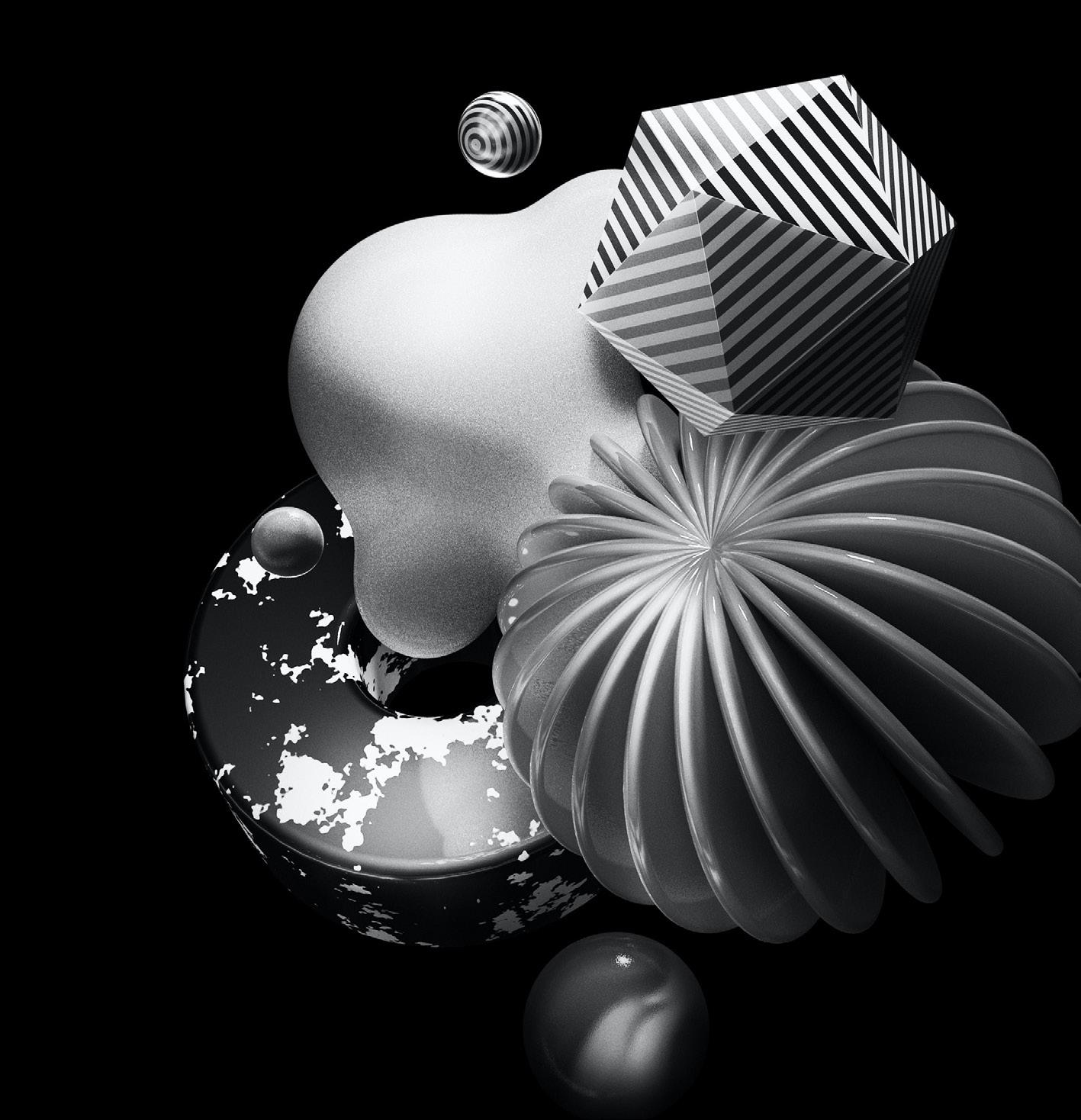
22
PRESERVING HUMANNESS
Designers have the ability to make complex concepts digestible and relatable to those unfamiliar, this is where the work is.
Early on in my process, I draw parallels between this Augmented Age and the climate crisis we are living in. I use Timothy Morton’s terminology – a hyper object – to explain this parallel. A Hyperobject is a phenomenon so vast that we, as humans, have a hard time comprehending its scale. ■

With global warming as an example of a hyperobject, we see how difficult it was for us as a society to comprehend its impact and urgency decades ago. Now, we are faced with a climate crisis we are locked into. I believe the same can be said about how we create and use technology in the Augmented Age. If we don’t examine this technological hyperobject, then there is a chance we might fall into a crisis of our humanness.
The speed of technological innovation needs to be met with considerations for how we redefine and evolve what it means to be human. How do we ensure that we are building the future that we want, not the future that those in power want for the rest of the world? While these are challenging considerations, a conscious effort to understand the questions at hand and to make solutions accessible is key.
● Dr Banu Onaral, interview by author, February 4th, 2023
23
■ Meis, Morgan. “Timothy Morton’s Hyper-Pandemic.” The New Yorker, June 8, 2021. https:// www.newyorker.com/culture/persons-of-interest/timothy-mortons-hyper-pandemic.
INTRODUCTION
A Hyperobject is a phenomenon so vast that we, as humans, have a hard time comprehending its scale.
The nature of my thesis work is exploratory and conversational. Some aspects are action-oriented microinterventions and proposals; while other aspects are exhibitory, with the goal of bringing awareness and conversation to complex and abstract topics. This work is not a science project, nor is it a traditional design sprint that follows a brief. Rather, the intent is to be purposeful in how I approach any proposals for solutions to avoid “silver bullet thinking.” This work is about opening access to socratic conversation, and to activate participation in as many people as possible. This pulls the work away from hierarchy and anchors the work in collective responsibility.
In short, the work itself is an exercise in maintaining the integrity of our humanness.
24
PRESERVING HUMANNESS
With this in mind, I made a conscientious effort to structure this thesis book in two parts. Section One, there is no world where we are human without technology now, is a theoretical exploration of how we got to this Augmented Age, with real world examples of how technology impacts our world. Themes of posthuman politics, McLuhuan’s medium theory, human enhancement and modern day eugenics are brought in to closely examine the wide range of technology’s impact.
Section Two, how we preserve our humanness is crucial to how our future unfolds, is an analysis and report on how I, as a researcher and designer, took these larger themes and explored them through design experiments. I structure this in two scales, the individual and the societal level, isolating scenarios within these scales to examine technology’s impact on us. Through this section, we discover how our nervous system is impacted by technology, how our physiology is changing by technology, and how we can move forward with compassion and care.
In the midst of exciting new discoveries and innovations, are citizens equipped with the tools and knowledge to think about how they envision their futures? Are they given the opportunity to have a say in what they want for their futures?
The unmet needs my thesis explores are awareness and agency. How do we maintain awareness and agency in this age of anthropocene? How can we utilize conversation and action to empower the collective and the individual to stay connected to their humanness? Section One fulfills the role of creating awareness around this thesis topic, while Section Two uses the tool of design and art to empower agency. We conclude with the personal standards I set for myself as an artist and researcher moving forward and an afterword from my dear editor, Olivia Howard.
25
p28 p72 INTRODUCTION
26 26
27
SECTION ONE

28
THERE IS NO WORLD WHERE WE ARE HUMAN WITHOUT TECHNOLOGY NOW.

30
THERE IS NO WORLD WHERE WE ARE HUMAN WITHOUT TECHNOLOGY NOW. 30
There is no world where we are human without technology now. This section outlines how we got to where we are today, the implications of our integration with technology and how we can navigate the complex ethics of these issues.
WELCOME TO THE AUGMENTED AGE
We’ll start with an exploration of how human civilization has entered the Augmented Age through our intimate integration with technology. This technological hyperobject demands attention and extensive workshopping in order to understand its larger implications, which we’ll explore in this section. Using Marshall McLuhan’s work in medium theory ● and referencing prominent current-day philosophers like Byung Chul Han ■ and Michael Sacasas ▲ , this section investigates how we shape technology and how technology, in turn, shapes us. I give real world examples of how technology has augmented our bodies and lives, and has even made us a version of a cyborg.
PART ONE PART TWO
NAVIGATING THE ETHICS OF HUMAN ENHANCEMENT
Then, in an exploration of Posthumanism, we’ll venture into an analysis on how the quest for human enhancement is an inherent behavioral predisposition of humanity. Breaking down the two opposing philosophies within Posthumanism (Posthumanism and transhumanism), we’ll identify dangers of transhumanist philosophies, in particular how transhumanist thought lends itself to modern day eugenics.
This section concludes with an exploration of disability theory and Donna Haraway’s version of Posthuman Politics. Utilizing Haraway’s lens, I argue what needs to be changed with this technological hyperobject and conclude with a proposal for how we can preserve our humanness.
● Medium theorists argue that media are not simply channels for transmitting information between environments, but are themselves distinct social-psychological settings or environments that encourage certain types of interaction and discourage others. Marshall McLuhan best known for his phrase “the medium is the message,” shares that each medium is a unique type of environment whose widespread use reshapes people and culture.
■ Korean-born German philosopher Byung-Chul Han teaches philosophy and cultural studies at Berlin’s University of the Arts (UdK). In the past few years, his provocative essays have been translated into numerous languages, and he has become one of the most widely read philosophers in Europe and beyond.
▲ “For more than ten years, Michael Sacasas has been one of the most penetrating and stimulating critics of digital technology, probing its social, personal, and moral consequences.” — Nicholas Carr, author of The Shallows and The Glass Cage
31
SECTION ONE OVERVIEW p35 p53
With every new technology introduced, what was previously impossible becomes possible – dismantling, reshaping, and expanding our reality. We have been augmenting our capabilities with technology for millions of years. From the first stone tools to computers today, the technology we create serves to enhance our physiological capabilities, and by extension our experience of the world.
The quest for clearer vision led to the technology of eyeglasses. The first steam-powered engine in the late 19th century altered our concept of place; travel was no longer bound by human or animal limitations. The first handheld phone extended means of communication past geographical limitations. Today, eighty percent of the world’s population owns a smartphone. ● Technology has become intertwined with our day-to-day existence, serving as extensions of not just our sensory perception and communication, but our human expression, identity, and purpose.
With technology, augmentation occurs. Where augments are pursued, technology innovates further.
32
● Pew Research Center: Internet, Science & Tech. “Mobile Fact Sheet,” May 11, 2023. https://www.pewresearch.org/ internet/fact-sheet/mobile/. THERE IS NO WORLD WHERE WE ARE HUMAN WITHOUT TECHNOLOGY NOW. 32
Technology arrives in our world with a point of view, and a new proposal for behavior.
While technology makes our lives better, richer and more fulfilling, it also makes us increasingly dependent on it. The technology that we readily integrate into our lives has redefined what it means to be human. We have developed such close ties with technologies that the issue now is not whether these technologies threaten or improve the “human”, but rather how human bodies materialize with and in them. What is at stake is how people understand their bodies in relation to technologies, and consequently how that impacts their understanding of what it means to be human.
Technology has the power to both support the greater good and/ or inflict harm upon society. It can foster empathy, bring joy, and amplify voices previously marginalized. Technology can also be manipulated to exploit vulnerabilities, spread misinformation, and perpetuate harm. It is crucial to recognize the immense influence of technology and harness its potential for positive change while also addressing its vulnerabilities.

33
SECTION ONE OVERVIEW
THE ISSUE NOW IS NOT WHETHER THESE TECHNOLOGIES THREATEN OR IMPROVE THE “HUMAN”, BUT RATHER HOW HUMAN BODIES MATERIALIZE WITH AND IN THEM.
WELCOME TO THE AUGMENTED AGE

PART ONE
WELCOME TO THE AUGMENTED AGE
We have transcended through the information age and the digital age, and found ourselves in the Augmented Age. ● The Augmented Age is a significant technological hyperobject ■ that, by nature, is challenging to fully understand and potentially even more challenging to navigate. Most humans are committed to making our bodies better and our lives happier. This pursuit of improvement, when interwoven with technological advancement, has led to the Augmented Age. How do we navigate the Augmented Age while preserving our humanness?
The answer is complex. With every new technological innovation, our bodies and experiences are augmented, changing the way we understand and define our humanity. Computational systems now enhance our cognition, robotic systems help us create and refine, and digital nervous systems connect us to the world far beyond our natural senses.
35
PART ONE WELCOME TO THE AUGMENTED AGE
To put it simply, we are already augmented beings. We are cyborgs.
● Conti, “The Incredible Inventions of Intuitive AI,” ■ A Hyperobject is a phenomenon so vast that we, as humans, have a hard time comprehending its scale.
We often think of cyborgs as a sci-fi rendition of a nonhuman futuristic species that is part robot, part humanoid. Donna Haraway considers cyborgs as a strange assemblage of human and machine, or cybernetic organisms.
In Haraway’s Cyborg Manifesto, the cyborg imagery is used to “suggest a way out of the maze of dualisms in which we have explained in our bodies and our tools to ourselves.” ◆ She uses the cyborg imagery to present hope and confidence that cybernetics is indeed our society’s way out of patriarchal differences. Because a cyborg is a hybrid of the machine and the organism, it blurs the lines between nature and culture, ultimately rejecting the essentialist understandings of human nature (for example, specific social roles meant for each of the sexes that are based on biological differences; or even differences like age or race).
Embracing Haraway’s notion of the cyborg means that we reject binaries that represent the epistemology of the patriarchy (such as body/psyche in descartes dualism, natural/artificial, male/female, human/ animal). In short, technology is the answer to transcending boundaries between binary identities and binary thinking that would reduce us to either bodies or machines. This means we can approach our existences with openness and pluralism. This also creates space for complexity and abstract unknowns.
Haraway’s influence on me as a researcher and artist is important to address as I want to clarify that through the entirety of my thesis, I embrace technology’s existence and work with it, rather than reject or counter technology as disruptive to our humankind. My critique of technology is intended to tighten our scrutiny on how we are impacted by this limitless entity (tech), so that we can live in a future where technology is a productive component in our lives.
36
◆ Cyberfeminism Index, Mindy Seu AUTHOR’S NOTE THERE IS NO WORLD WHERE WE ARE HUMAN WITHOUT TECHNOLOGY NOW.
To extend Haraway’s views on the cyborg to us, humans of today, we can in fact see how technology’s, or more specifically the cybernet’s, entanglement in our lives have made us cyborgs. When we have a question about something or are curious about an unknown, we have immediate access to search engines and all the information, factual or opinion-based, about said topic. When we get lost, a touch of a button tells us where we are on a map and how we need to navigate to where we want to go. When we experience a moment we want to fossilize, we can record that memory immediately.
As Marshall McLuhan believed, technology’s way of shaping how we think has had much greater effect on us and our lives than did the information or content flowing through the medium.

37
“The inherent tendency to focus on the messages within the media makes us blind to the limits and structures imposed by the mediums themselves.”
We are often so taken by the power of what technology can do for us that we forget, and sometimes ignore, what technology actually does to us.
PART ONE WELCOME TO THE AUGMENTED AGE
– MARSHALL MCLUHAN
38 THERE IS NO WORLD WHERE WE ARE HUMAN WITHOUT TECHNOLOGY NOW.
Technology’s integration into our lives has reshaped human’s bodies, emotions and behaviors. We see this in how social media has reconstructed how we view and perform identity. We also see this in AI and robots who mimic human-like behaviors and personalities.
Both of these shifts in ➀ identity expression and ➁ emotional ties have contributed to the distortion of real-life events and could potentially lead to the loss of our humanness if we are not careful.
39
PART ONE WELCOME TO THE AUGMENTED AGE
➀ identity expression
➁ emotional ties
◆ “Cogito, Ergo Sum.” Wikipedia, February 27, 2023. https://en.wikipedia.org/wiki/Cogito,_ergo_sum#:~:text=The%20 Latin%20cogito%2C%20ergo%20sum,of%20Ren%C3%A9%20Descartes's%20philosophy.
◉ Murakami, Haruki. 1Q84. Turtleback, 2013.
▶ “Damasio’s Theory of Consciousness.” Wikipedia, April 16, 2023. https:// en.wikipedia.org/wiki/Damasio%27s_theory_of_consciousness.
■ “Huff, Cynthia, and Margaretta Jolly. Engaging Donna Haraway: Lives in the Natureculture Web. Taylor & Francis, 2022.
40
THERE IS NO WORLD WHERE WE ARE HUMAN WITHOUT TECHNOLOGY NOW.
Every aspect of how entangled we are with technology has led to the redefinition of what makes “me”, me. Our desire to record and share every moment of our lives has been shaped by the advent of networked communities. Every thought or opinion can now be vocalized into the ethernet, every moment can be observed through our social media communities. This ability has shaped what was initially an option to share, to necessity to share.
Our identities have become reactionary – we shift who or how we are based on how we are being perceived by those who can see, follow, and even mimic us. We now have an audience for every thing we do.
WE HAVE GONE FROM:
“I think, therefore I am.” (Descartes) - 1637 ◆
“I move, therefore I am.” (Haruki Murakami) - 1Q84 book 2009 ◉
“I feel, therefore I am.” (Antonio Damasio) - 1999 ▶
TO
“I am being watched, therefore I am.” (Dr. Francesca Ferrando) ■
41
PART ONE WELCOME TO THE AUGMENTED AGE
➀ identity expression
● Darling, Kate. The New Breed: What Our History with Animals Reveals about Our Future with Robots. Henry Holt and Company, 2021.
■ Lopez, Kat. “Can We Compare Robots to Animals and Build Diverse Relationships With Them? — LDV Capital.” LDV Capital, June 7, 2022. https://www.ldv.co/blog/kate-darling-can-we-compare-robots-to-animals-and-builddiverse-relationships-with-them.
42
THERE IS NO WORLD WHERE WE ARE HUMAN WITHOUT TECHNOLOGY NOW.
➁ emotional ties
Technology is also redefining our emotional literacy. Kate Darling, author of the book The New Breed: What Our History with Animals Reveals about Our Future with Robots ●, analyzes how our treatment and empathy towards machines can reveal a new understanding of our own history, systems, community connection, and how we relate to nonhumans.
She explains how human brains are hardwired to separate things into objects and agents in our environment, “when we start to make objects move like agents, we subconsciously treat them like they have emotions. We start to develop an emotional attachment to them.” ■ Like Roomba that moves around an apartment to clean the floors or Alexa who has quickly become a household name, these robots are meant to function as a tool. But when people start to relate to them on an emotional level, it holds implications that can range anywhere from being innocent to potentially dangerous. People start to assume these machines can behave like humans and expect interactions from them that aren’t possible.
When an inanimate object is given agent-like behavior, our direct response is to think it can see, feel, sense, and respond to us like another human or animal does. Because robots or objects that have been given agentlike behaviors are still learning to do so (through their algorithms and auto-regressive modeling systems), they don’t meet our expectations. This in turn causes us to get annoyed, frustrated or even fearful of the object.
These are the growing pains of innovative technology. And while it takes time to see the full impact it’s having on our bodies, psyches, and futures, there is no question it’s shifting our understanding of what it means to be human.
43
PART ONE WELCOME TO THE AUGMENTED AGE

44 Osama Hajjij | Copyright 2017 Cagle Cartoons
THERE IS NO WORLD WHERE WE ARE HUMAN WITHOUT TECHNOLOGY NOW.
Both the reconstruction of our identities and the redefinition of our emotional ties serve as realworld examples of how our humanness is at stake. Carl Sagan foreshadows a harrowing time for our society in his 1996 novel, that rings true today:
“The dumbing down of America is most evident in the slow decay of substantive content in the enormously influential media, the 30 second sound bites (now down to 10 seconds or less), lowest common denominator programming, credulous presentations on pseudoscience and superstition, but especially a kind of celebration of ignorance.” ◆
– SAGAN, THE DEMON HAUNTED WORLD, 1996
45
PART ONE WELCOME TO THE AUGMENTED AGE
◆ Sagan, Carl, and Ann Druyan. The Demon-Haunted World: Science as a Candle in the Dark. Ballantine Books, 1996.
Byung Chul Han, Korean-born German philosopher who teaches philosophy and cultural studies at Berlin’s University of the Arts (UdK), also talks about how the smartphone has amplified human’s ego.
● Chul Han argues this has led to a narcissistic society that would rather isolate from each other than empathize with one another. He ruminates on how open access to information has made the world appear to be in complete availability to us. Everything now seems consumable and attainable. Constant engagement with information robs us of being present in reality.
Digitization dematerializes and disembodies.

46
THERE IS NO WORLD WHERE WE ARE HUMAN WITHOUT TECHNOLOGY NOW.
Information and media distorts real-life events. The way we engage with technology causes us to lose awareness in everything else around us. Information now drives the world we live in, not objects, people and connection. As information hunters, we become blind to silent and unobtrusive things around us – things that don’t stimulate us, but instead anchor us in reality, and in being. ■
Michael Sacasas, author of “The Convivial Society” – a newsletter exploring the relationship between technology and society –shares that it is important to see what each technology promises, whether it meets its goals or not, and whether it crosses certain thresholds beyond which it becomes counterproductive.
▲ Under the pen name L.M. Sacasas, he develops a list of 41 questions to “ask” of our technology. The questions prompt the readers to engage critically with the technology they use and how it impacts every facet of their lives. ☀
The idea is that technology is not good or bad, because technology to a certain point achieves something meaningful (therefore positive), but if it reaches a certain scale (such as dominance or monopolizes), it flips into being counterproductive and potentially even destructive. However, to say technology is neutral, and that our intentions of its usage is what makes it positive or negative is to not acknowledge that technology itself has shaped how we perceive the world. It changes how the world appears to us.
◆ Sagan, and Druyan. The Demon-Haunted World: Science as a Candle in the Dark.
● Fanjul, Sergio C., and El País. “Byung-Chul Han: ‘The Smartphone Is a Tool of Domination. It Acts like a Rosary.’” EL PAÍS English, October 15, 2021. https://english.elpais.com/usa/2021-10-15/byung-chul-han-the-smartphone-is-a-tool-of-domination-it-actslike-a-rosary.html.
■ ArtReview. “Byung-Chul Han: ‘I Practise Philosophy as Art,’” n.d. https://artreview.com/byung-chul-han-i-practise-philosophyas-art/.
▲ Times, New York. “Transcript: Ezra Klein Interviews L.M. Sacasas.” The New York Times, August 3, 2021. https://www.nytimes. com/2021/08/03/podcasts/transcript-ezra-klein-interviews-lm-sacasas.html.
☀ Sacasas, L. M. “The Questions Concerning Technology.” By L. M. Sacasas, June 5, 2021. https://theconvivialsociety.substack. com/p/the-questions-concerning-technology#details.

47
PART ONE WELCOME TO THE AUGMENTED AGE
We have to find technology’s place in its spectrum of use. This is the projection we need to incorporate into any technological innovations introduced to the world.
Billions are poured into the research, development and testing of new technological augments. AI and robotics aim at creating a problem-solving machine modeled after our human brains and bodies, while genetic engineering and pharmaceuticals obsess over removing any human biological weaknesses. Our human futures no longer unfold organically, but instead can be controlled and cultivated. If we take a step back, we realize that the way we choose to operate no longer rests in our own hands – we’ve lost agency.

Instead, our decisions and actions are observed, analyzed and utilized for profit. Big tech companies are now actively recording data about us through our smart products, sometimes authorized and other times not. In 2019, it was reported that Amazon employees were listening to and transcribing voice recordings captured by Amazon Echo devices powered by the virtual assistant, Alexa. ● These recordings, which were intended to improve the voice recognition technology, were being reviewed without explicit consent from the users, raising concerns about unauthorized surveillance and the privacy of personal conversations.
● Hern, Alex. “Amazon Staff Listen to Customers’ Alexa Recordings, Report Says.” The Guardian, April 11, 2019. https://www. theguardian.com/technology/2019/apr/11/amazon-staff-listen-to-customers-alexa-recordings-report-says.
■ SPACE10. “The Augmented Human: How Technology Began to Merge With the Body | SPACE10,” January 26, 2023. https:// space10.com/project/the-augmented-human/.
▲ Malyk, Maria. “Facebook Data Privacy Scandal: Here’s What You Need To Know.” Www.Easyllama.Com, February 22, 2023. https://www.easyllama.com/blog/facebook-data-privacy-scandal/.
☀ Morris, Chris. “Massive Data Leak Exposes 700 Million LinkedIn Users’ Information.” Fortune, June 30, 2021. https://fortune. com/2021/06/30/linkedin-data-theft-700-million-users-personal-information-cybersecurity/.
48
Capitalism has directed human pathways towards a mission for perfection, and with it, the economic, political and social systems that govern the world have followed suit.
Ownership of data and powerful technology is concentrated in the hands of only a few individuals or entities, widening the gap between the controlled and the one in control.
THERE IS NO WORLD WHERE WE ARE HUMAN WITHOUT TECHNOLOGY NOW.
Smart watches and rings that detect our biological statuses have a constant measure of how our bodies regulate. Quantifying biological states creates an avenue for capitalism to own that part of our data. Smartphones have the capacity to surveil our lives through nested cameras and microphones. During our day to day, we sometimes disregard the intrusiveness of this surveillance and exchange it for bespoke ■ experiences that are hyper-curated, like Netflix’s watch recommendations and social media’s targeted advertisements. On top of that, average encryption capabilities do not hold up to protecting personal data from profit-mongers and hackers, as demonstrated in the Facebook-Cambridge Analytica data privacy scandal ▲ and LinkedIn’s massive data leak. ☀





We have even unlocked biological doors and invited new entities to analyze, alter and make decisions about what happens internally. Embedding technology into our bodies and brains to interface with machines unleashes new ways to communicate, stimulate muscular actions, influence bio-chemicals, and alter sensory perception. In these cases, the integration of tech in the body begs the question of who or what is really making decisions for the body. Biotech advancements like bio-printing and CRISPR gene editing signal a new-found ability to take human evolution into our own hands, and determine the types of genetic pools that continue to survive our human species.

49
Natural selection becomes a thing of the past and directed evolution takes over.
Data collected about our bodies and behavior give decision-makers an intrusive lens into our lives to capitalize on.
PART ONE WELCOME TO THE AUGMENTED AGE
Apple iPhone 14, Oura Ring, Apple Watch, Oculus VR Headset
How can we understand the potential impact of technological implications entering the commercial markets at an exponential speed?
What guideposts need to be created to ensure these new developments don’t rob us of our humanness?
To help contextualize this research, I developed a framework to project a technology’s spectrum of use, looking at the different ways in which one may use a specific type of technology and plotting its intended use on this matrix. Its location on the matrix serves as a siren to help consider when limits are needed to ebb negative impacts of that technology.
While this framework is a relatively new development, it was key in contextualizing the larger themes explored in Section Two. For example, when investigating augments that enhance human function, I plotted the different forms of augments on the matrix to single out which scenario I wanted to situate my experiments in to explore further.
50
AUTHOR’S FRAMEWORK THERE IS NO WORLD WHERE WE ARE HUMAN WITHOUT TECHNOLOGY NOW.
A FRAMEWORK TO PROJECT A TECHNOLOGY’S SPECTRUM OF USE
feeling of control over actions and their consequences
HIGH AGENCY
(couldleadtoourdemise)
intended for intended for COLLECTIVE ENGAGEMENT
INDIVIDUAL ACTION
(couldleadtodisparity)
(couldleadtoenforcement)
LOW AGENCY
disengaged, inactive, loss of control, powerless bystander, feeling beholden to
HOW TO USE:
PLOT POSSIBLE SCENARIOS FOR HOW A PIECE OF TECHNOLOGY CAN BE USED.
51
PART ONE WELCOME TO THE AUGMENTED AGE
NAVIGATING THE ETHICS OF HUMAN ENHANCEMENT

THERE IS NO WORLD WHERE WE ARE HUMAN WITHOUT TECHNOLOGY NOW.
PART TWO NAVIGATING THE ETHICS OF HUMAN ENHANCEMENT
Every new advancement in tech has the potential for abuse, the same can be said for new augments. Augments intended for therapeutic and supportive purposes can be manipulated to facilitate harm – it all depends on the ethics of those who use and distribute that tech. Concepts of Posthuman philosophies offer key insights for navigating the ethics of human enhancements. Understanding the differences in transhumanism and Posthumanism philosophies is crucial in observing how society has veered towards a transhumanist path that is a threat to our humanness.
We’ll explore these concepts in depth later in this section, but first, we need to understand the real world technological developments that are changing our understanding of what it means to be human.
53 PART TWO ETHICS OF HUMAN ENHANCEMENT
Brain-Computer-Interfaces (or BCI) offer a real world example of a therapeutic augment that can be utilized to heal or harm the collective. BCIs are computer-based systems that track, analyze, and translate brain signals into commands that are relayed to an output device that executes those commands. ●
Neural prostheses were some of the earliest BCI and this technology has developed rapidly ever since. ■ Deep brain stimulation to treat Parkinson’s disease utilizes high-frequency stimulation to cause an inhibition of the subthalamic nucleus, the part of the brain responsible for movement regulation, or in the case of Parkinsons’ disease, motor fluctuations. ▲ Cochlear implants have been provided to thousands of patients, especially children, restoring sensory pathways and making speech development possible to deaf and hard of hearing individuals. ☀
These technologies have supported medical advancement for people with disabilities or degenerative diseases.
● Shih, Jerry J., Dean J. Krusienski, and Johnathan R. Wolpaw. “Brain-Computer Interfaces in Medicine.” Mayo Clinic Proceedings 87, no. 3 (March 1, 2012): 268–79. https://doi.org/10.1016/j. mayocp.2011.12.008.
■ Jerry J, Krusienski, and Wolpaw. “Brain-Computer Interfaces in Medicine.”, 268–79.
▲ Groiss, Stefan Jun, Lars Wojtecki, Martin Südmeyer, and Alfons Schnitzler. “Review: Deep Brain Stimulation in Parkinson’s Disease.” Therapeutic Advances in Neurological Disorders 2, no. 6 (September 18, 2009): 379–91. https://doi.org/10.1177/1756285609339382.
☀ Rosahl, Steffen K. “Neuroprosthetics and Neuroenhancement: Can We Draw a Line?” AMA Journal of Ethics 9, no. 2 (February 1, 2007): 132–39. https://doi.org/10.1001/ virtualmentor.2007.9.2.msoc2-0702.
◆ Bess, Michael D. “Icarus 2.0: A Historian’s Perspective on Human Biological Enhancement.” Technology and Culture 49, no. 1 (2008): 114–26. http://www.jstor.org/stable/40061380.
54
THERE IS NO WORLD WHERE WE ARE HUMAN WITHOUT TECHNOLOGY NOW.
According to Michael Bess, Chancellor’s Professor at Vanderbilt University, we are now refashioning ourselves by redesigning our physical and mental capabilities. Bess shares that technologies of human enhancement are the most rapidly developing innovations today:
“Some of the most important watersheds in human history have been associated with new applications of technology in everyday life: the shift from stone to metal tools, the transition from hunting and gathering to settled agriculture, the substitution of steam power for human and animal energy. Today we are in the early stages of an epochal shift that will prove as momentous as those other great transformations. This time around, however, the new techniques and technologies are not being applied to reinventing our tools, our methods of food production, our means of manufacturing. Rather, it is ourselves who are being refashioned. We are applying our ingenuity to the challenge of redesigning our own physical and mental capabilities. Technologies of human enhancement are developing ever more rapidly
–
55
◆
”
PART TWO ETHICS OF HUMAN ENHANCEMENT
MICHAEL BESS, ‘ICARUS 2.0’, 2008
THERE IS NO WORLD WHERE WE ARE HUMAN WITHOUT TECHNOLOGY NOW.



56
Synchron Stentrode
Inner Cosmos
Neuralink
What happens when new waves of BCI technology shifts from medical advancement and research to the private sector?
Stentrode ● , an implantable brain-computer interface (BCI), collects and wirelessly transmits information directly from the brain to a computer, without the need for open surgery. Neuralink ■ similarly solves important brain and spine problems with a seamlessly implanted device automated by a surgical robot. Inner Cosmos,a private neurotechnology startup, is pioneering a “digital pill for the mind” ▲ utilizing a similar BCI technology to rebalance brain networks. According to their pitch and website, the company is on a mission to heal depression, the largest chronic disorder in the world.
Brain implants are not the only biomedical technologies that are heavily researched and invested in today. Meta, one of the most powerful social media monopolies in the world, has acquired CTRL labs ❖, a company developing a wristband that reads neural signals and translates them into computer actions. This removes the need for a mouse and keyboard, or touch screen and can support individuals with wrist injuries or other physical disabilities. Neurotechnologist Chad Bouton, director of the Feinstein Institute for Medical Research’s bioelectronic medicine program, says that if CTRL-kit works as advertised, it could actually offer some people with incomplete paralysis an alternative to implants.
● Synchron. “The Technology,” June 10, 2022. https://synchron.com/technology.

■ Play Studio. “Neuralink.” Neuralink, n.d. https://neuralink.com/.
▲ “Inner Cosmos – The Evolution of Depression Treatment,” n.d. https://innercosmos.io/.
☀ “Inner Cosmos – The Evolution of Depression Treatment”
❖ Rodriguez, Salvador. “Facebook Agrees to Acquire Brain-Computing Start-up CTRL-Labs.” CNBC, September 24, 2019. https://www.cnbc.com/2019/09/23/ facebook-announces-acquisition-of-brain-computing-start-up-ctrl-labs.html.
★ Robertson, Adi. “Testing the CTRL-Labs Wristband That Lets You Control Computers with Your Mind.” The Verge, June 6, 2018. https://www.theverge.com/2018/6/6/17433516/ ctrl-labs-brain-computer-interface-armband-hands-on-preview.
57
☀
★
PART TWO ETHICS OF HUMAN ENHANCEMENT
While these technologies have been developed to support the advancement of medicine, their potential to hit the commercial market shifts their implications.
In light of these developments, the question becomes where do we draw the line between treatment and enhancement? How do we differentiate between devices that have both a therapeutic benefit and an enhancement aspect to them?
ENHANCEMENT COMES THROUGH THE BACK
It is probable that linking our bodies to computing power will become commonplace. Therapeutic devices function to correct or compensate for some diseases restoring one to “normality” or the standard species-typical form. ● However, these devices might also enhance the person beyond the limits of what would be considered “normal.” Using a technological intervention to improve the physical, cognitive or psychological parts of a person beyond what is considered “normal” is subjective and depends on how the individual defines what is considered human and what is not.
In 2012, Oscar Pistorius made history by being the first runner to compete in the Olympic Games with two prosthetic legs. ■ These racing blades stirred up a controversy of whether the bionic cheetah legs gave him an unfair advantage, or somehow made him “more than” his fellow competitors. ▲

58
THERE IS NO WORLD WHERE WE ARE HUMAN WITHOUT TECHNOLOGY NOW.
Oscar Pistorius, 2012 Summer Olympics. (Anja Niedringhaus/AP)
Which leads us to the question – should there be limits placed on technological enhancement to preserve our humanness?
A deeper understanding of posthuman philosophies offers a framework to navigate these complexities.
DOOR OF TREATMENT AND PREVENTION.
As a society, we have a predisposition to want to enhance what we have and what we can do. Why is this so? There is a near universal desire to improve the functioning of our bodies and brains. This is a result of our natural survival mechanisms and societal programing:
“We are being trained to be capitalists – to compete, in a system of scarcity, to be better than each other to access resources to meet our basic human needs.”
Concepts of Posthumanism can help us better understand what is at stake when we lean into our tendencies to enhance the human.
● Binkley, Charles E., Michael S. Politz, and Brian D. Green. “Who, If Not the FDA, Should Regulate Implantable Brain-Computer Interface Devices?” AMA Journal of Ethics 23, no. 9 (September 1, 2021): E745-749. https://doi.org/10.1001/amajethics.2021.745.
■ HISTORY. “Oscar Pistorius Becomes the First Amputee Runner to Compete at the Olympics,” August 3, 2021. https:// www.history.com/this-day-in-history/oscar-pistorius-becomes-the-first-amputee-runner-to-compete-at-the-olympics.
▲ Mullins, Aimee. “Changing My Legs - and My Mindset,” n.d. https://www.ted. com/talks/aimee_mullins_changing_my_legs_and_my_mindset.
◆ Adrienne Maree Brown - Awe. Liberation. Pleasure. “Distinguished and Singing – Adrienne Maree Brown,” March 26, 2021. https://adriennemareebrown.net/2021/03/26/distinguished-and-singing/.
59
– ADRIENNE MAREE BROWN ◆
PART TWO ETHICS OF HUMAN ENHANCEMENT
The term “posthuman” is used to describe modes of being that result from potential enhancements to human nature, created through applied science and technological developments. ● Transhumanist philosophers are technoprogressive, while Posthumanists are critical of technological determinism. Transhumanism is focused on the perfecting of humanity, while Posthumanism argues for the preservation of our humanness.
POSTHUMAN
● Rugo, Daniele. “Posthuman.” Oxford Research Encyclopedia of Literature, July 30, 2020. https://doi.org/10.1093/acrefore/9780190201098.013.1136.
■ O’Gieblyn, Meghan. “God in the Machine: My Strange Journey into Transhumanism.” The Guardian, November 28, 2017. https://www.theguardian.com/technology/2017/apr/18/god-in-the-machine-my-strange-journey-into-transhumanism.
▲ Khatchadourian, Raffi. “The Philosopher of Doomsday.” The New Yorker, November 16, 2015. https:// www.newyorker.com/magazine/2015/11/23/doomsday-invention-artificial-intelligence-nick-bostrom.
❖ Futter, Michael. “Variety.” Variety, June 15, 2018. https://variety.com/2018/ gaming/features/state-of-mind-philosophy-1202847303/.
☀ Centre, Ethics. “Ethics Explainer: Post-Humanism.” THE ETHICS CENTRE, April 2, 2023. https://ethics.org.au/ethics-explainer-post-humanism/.
60
The Augmented Age, this technologized hyperobject we are now in, ushers in the possibility of a posthuman – or beyond human – being.
TRANSHUMANISM
POSTHUMANISM THERE IS NO WORLD WHERE WE ARE HUMAN WITHOUT TECHNOLOGY NOW.
The technoprogressive advocates, or transhumanists, prefer a technological future with enhanced humanity. Transhumanists advocate to slow, reverse, or eliminate the human aging process altogether, to enhance the human condition through cognitive and sensory capacities. Well-known transhumanists include Ray Kurzweil ■, computer scientist and former chief engineer of Google, Nick Bostrom ▲, philosopher of computational neuroscience artificial intelligence and human enhancement ethic, and Elon Musk ❖, notorious business magnate and entrepreneur. Transhumanists often lead the field in brain implants, biohacking, cognitive enhancement and other biomedical technologies, some of which can be misused or abused. Transhumanism’s goals to eliminate flaws and strive for human perfection lends itself to the contribution of modern day eugenics, which will be explored later in this section.
Alternatively, the concept of Posthumanism offers a perspective that decenters humanity to break down binaries of gender, race, and species. These Poshumanists see the protection of all creatures and species to be a moral imperative. Posthumanist pioneer Donna Haraway, prominent scholar in the field of science and technology studies, rejects the masculine and hierarchical approach. Instead she argues that fusing of humans and technology will help us see ourselves as interconnected with non-human beings. ☀ This helps us navigate and deconstruct the polarized categories we set up between human and non-human, natural and artificial, self and other, organic and inorganic.
61
PART TWO ETHICS OF HUMAN ENHANCEMENT
We see real world evidence where billions of capital is invested in technological enhancements mentioned above (i.e. BCI and other bio-tech products).
Transhumanists are leading the charge toward technological enhancements. Elon Musk’s heavy investment in AI technologies and BCI demonstrates how transhumanistic visions for our future are already put in place. Ray Kurzweil, who used to direct the engineering efforts at Google, had immediate say and control over society’s mode of learning and communication. In Ray Kurzweil’s work, he posits that the human will eventually become a super intelligent AI, in which their biological reality can be transcended into a virtual reality by “uploading” their consciousness. ● In this line of thought, a person’s essence is just a specific neural pattern, and copying that onto a computer can enable humans to live as machines forever.
● https://kurzweilai.net/. “We’ll Be Uploading Our Entire Minds to Computers by 2045 and Our Bodies Will Be Replaced by Machines within 90 Years, Google Expert Claims « Kurzweil,” n.d. https:// www.kurzweilai.net/daily-mail-well-be-uploading-our-entire-minds-to-computers-by-2045-andour-bodies-will-be-replaced-by-machines-within-90-years-google-expert-claims.
◆ Damasio, Antonio R., Thomas J. Grabowski, Antoine Bechara, Hanna Damasio, Laura L. Boles Ponto, Josef Parvizi, and Richard D. Hichwa. “Subcortical and Cortical Brain Activity during the Feeling of Self-Generated Emotions.” Nature Neuroscience 3, no. 10 (October 1, 2000): 1049–56. https://doi.org/10.1038/79871.
62
Whether consciously or not, society has started down a path of transhumanism.
THERE IS NO WORLD WHERE WE ARE HUMAN WITHOUT TECHNOLOGY NOW.
I want to take a moment to address this concept of “uploading” your consciousness and living as machines sans body. Descartes’ Dualism is one of the most popular philosophies around this topic. It separates the physical workings of the brain and body from the supposed non-physical human mind. Many still believe, today, that you can exist without your physical being. Modern science, however, has challenged this. Through research and advancements in the neuroscience field, it has been found that damaged or impaired areas of the brain can lead to significant changes in an individual’s cognitive abilities, emotions, and personality. ◆ If the mind were completely separate from the body, as Descartes proposed, we would not expect to see such direct correlations.
I believe that our mind and our consciousness is far from a separate entity outside of our physical body. I believe it is deeply intertwined, correlational and embedded. Every thought, movement or feeling that arises is the intricate interplay between sensory perception, internal chemical responses, physiological response, and mental phenomena. This belief drove my motivation for this thesis, to find ways to further demonstrate this in an era of excitement and buzz around synthetic bodies and disembodied immortality.
Leaders of the transhumanist philosophy have set a trajectory for the development of the human mind, proposing significant upgrades to the human through cognitive and physical enhancements that ultimately lead to longevity.
63
As we continue down this path of transhumanist priorities, we become more focused on the advancement of humanity, instead of preserving our humanness.
PART TWO ETHICS OF HUMAN ENHANCEMENT
AUTHOR’S NOTE
How do we maintain our humanness in a society so insistent on “advancing” humanity, that it doesn’t truly factor in the ultimate cost? When considering access to human enhancement, it’s imperative to acknowledge the uneven access to resources throughout the world. Not all augments will be distributed equally. So what could it mean to live in a world where what it means to be human changes according to those who have access to enhancement and those who don’t? How do we navigate the potential repercussions of a stratified society?
Does this way of working with technology lend itself to eugenics?
Genetic engineering offers a useful framework to consider these questions.
Pregnant parents now have the ability to use prenatal screening to identify neurodiversity, and as a result make pre-life decisions to eradicate or prevent such neurodiversities. But when does parental choice become eugenics? ● Is the act of making pre-life decisions to remove neurodiversities an attempt at getting rid of disabilities? Rosemarie Garland-Thomson, a noted disability studies scholar, has been studied by the AMA Journal of Ethics in these complex questions around modern day eugenics and its relation to disability studies.
64
THERE IS NO WORLD WHERE WE ARE HUMAN WITHOUT TECHNOLOGY NOW.
“Consider how often and how carefully you have made a plan for the future, whether it is simply for what you will do with your time tomorrow or years from now. Imagine not being able to do that—not being able to have an idea of what your tomorrow or future might look like (or what Garland-Thomson calls not having “predictable narratives”).
If the thought makes you uneasy—feel vulnerable even—then Garland-Thomson has accurately described your relationship with the future and how disability challenges it. She eloquently concludes that ‘disability’s contribution, its work, is to sever the present from the future’.
Rather, Garland-Thomson explains, the existence of disability is not only ‘an antidote to modernity’s overreaching’ focus on curing and fixing, but also the source of a narrative of a genuinely open future…not controlled by the objectives, expectations, and understandings of the present.” ◆
– JASMINE ZAHID
● Hutson, Matthew. “Prenatal Screening for Autism Is an Ethical Dilemma - Proto.Life.” Proto.Life, April 10, 2023. https://proto. life/2023/04/prenatal-screening-for-autism-is-an-ethical-dilemma/?utm_source=proto.life&utm_campaign=42647359a9EMAIL_CAMPAIGN_2023_04_05_09_39&utm_medium=email&utm_term=0_-42647359a9-%5BLIST_EMAIL_ID%5D.
◆ Zahid, Jasmine. “A Defense of ‘The Case for Conserving Disability.’” AMA Journal of Ethics, April 1, 2016. https://doi. org/10.1001/journalofethics.2016.18.4.nlit2-1604.
65
PART TWO ETHICS OF HUMAN ENHANCEMENT
Nick Bostrom, co-founder of the World Transhumanist Association, has outrightly expressed that his work seeks to “eliminate aging and to greatly enhance human intellectual, physical, and psychological capacities” through the use of technology. ● His current work argues that “dysgenic pressures,” caused by people with “lower IQs” outbreeding “intelligent” people, ■ could threaten the viability of the human race. Bostrom hopes to increase “eugenic pressures” to produce an “intellectually superior” race of humans. ▲
(SHE/THEY) – philosopher who works on intersectionality, feminist philosophy, critical disability theory, and justice studies.
● Ciurria, Mich. “Transhumanism Is Eugenics for Educated White Liberals.” BIOPOLITICAL PHILOSOPHY, January 19, 2023. https://biopoliticalphilosophy.com/2023/01/19/transhumanism-is-eugenics-for-educated-white-liberals/.
■ Torres, Émile P. “Understanding “Longtermism”: Why This Suddenly Influential Philosophy Is so Toxic.” Salon, August 20, 2022. https://www.salon.com/2022/08/20/understanding-longtermism-why-this-suddenly-influential-philosophy-is-so/.
▲ Ciurria, “Transhumanism Is Eugenics for Educated White Liberals.”
◆ Ciurria, “Transhumanism Is Eugenics for Educated White Liberals.”
▶ Banja, John D. “The Disability Movement’s Critique of Rehabilitation’s Medical Model: A Rebuttal.” AMA Journal of Ethics, June 1, 2015. https://doi.org/10.1001/journalofethics.2015.17.6.msoc1-1506.
☀ Zahid, “A Defense of ‘The Case for Conserving Disability'."
❖ Zahid, “A Defense of ‘The Case for Conserving Disability'."
66
With transhumanists’ efforts pioneering the innovations in biotechnology, there have been active efforts in eradicating human flaws and slowing aging altogether.
◆
“Transhumanism is a form of ableist eugenics that perpetuates the logic of the Nazi regime, albeit through “gentler” means, i.e., by scientifically engineering disability out of existence. Eugenics, as such, has moved from the dark ghettos of Nazi Germany to well-lit science labs, but retains the same aims. Transhumanists want to reduce and eliminate disabilities and to engineer nondisabled bodies.”
– MICH CIURRIAL
THERE IS NO WORLD WHERE WE ARE HUMAN WITHOUT TECHNOLOGY NOW.
It is worth noting eugenic logic here when we look at technological advancements aimed to “normalize” certain disabilities and consequently, enhance our bodies and abilities to reach a certain vision of “perfection”. Rosemarie Garland-Thomson, noted disability studies scholar, defines eugenic logic as the following:
“Eugenic logic tells us that our world would be a better place if disability could be eliminated. Enacted worldwide in policies and practices that range from segregation to extermination, the aim of eugenics is to eliminate disability and, by extension, disabled people from the world… This understanding of disability as somehow detachable from human life rather than essential to it fosters the idea that disability does not have much to do with us unless we have the misfortune of having it descend upon us. ▶
– GARLAND-THOMSON
Garland-Thomson continues on to remind us that disability is in fact inherent in our being. Sooner or later, we, as humans, will age into disability.
Therefore making disability “inherent in our being: what we call disability is perhaps the essential characteristic of being human”. ☀ According to Garland-Thomson, “disability [is] a way of being in an environment” produced by the “discrepancy between body and world, between that which is expected and that which is”. ❖
People with disabilities and their advocates often share a discomfort for anything that devalues the experience of the phenomenon of disability – including the rehabilitation of “normal” function. Portraying “disabilities as deficits” is criticized and folds into the opposition of “eugenic logic.”
67
PART TWO ETHICS OF HUMAN ENHANCEMENT
“Cyborg theory, then, emerged from a desire for resistance, and contains the potential for disability activism and justice. This is in stark contrast to transhumanism’s past and present politics of enhancement, sameness, eugenic world-building, and compulsory able-bodiedness.”
– MICH CIURRIAL
Ciurrial aptly distinguishes how Donna Haraway’s Posthumanist theories through her Cyborg Manifesto shines a different light on the Posthuman, one that is inclusive, and one that, ultimately seeks to preserve our humanness.

68
◆
Is
for Educated
THERE IS NO WORLD WHERE WE ARE HUMAN WITHOUT TECHNOLOGY NOW.
◆ Ciurria, “Transhumanism
Eugenics
White Liberals.”
Refer to page 36 Author's note on Haraway's cyborg to get a refresher on this "Cyborg theory" that Mich is referring to
So, we are left with these questions:
Are citizens given the opportunity to have a say in what they want for their future?
When new technological advancements enter the consumer market, are users able to make autonomous decisions on whether or not to adopt these new technologies, or are they bound by the systemic pressures that govern our ability to survive and thrive in this world?
All too often, the exploration of these questions is left out of the purview of the public. Theoretical exploration is left to academic circles, and decisions on what is developed are left in the hands of the wealthy.
In an effort to decentralize these conversations, I created a series of experiments to inspire conversations, bring awareness, and support individual and collective agency as we navigate continual technological advancements.
This is what we’ll explore in Section Two.
69
PART TWO ETHICS OF HUMAN ENHANCEMENT
The need to consider a distinction between enhancement and therapy is therefore imperative if we want to detangle ourselves from capitalist systems and reconsider how we want to preserve our humanness.
70 70
71
SECTION TWO

72
HOW WE PRESERVE OUR HUMANNESS IS CRUCIAL TO HOW OUR FUTURE UNFOLDS.

How are we going to maintain our
... as technology continues to develop?
... as we turn into cyborgs?
... as we get more entangled with technology?
74 HOW WE PRESERVE OUR HUMANNESS IS CRUCIAL TO HOW OUR FUTURE UNFOLDS.
74
Where Section One explores the inescapable interweaving of humanity and technology and the collective consequences of these innovations, Section Two is where I use the tools of design and art to empower agency.
This section demonstrates where my research made the theoretical, tangible. Our humanness is at stake as revealed in Section One. But in this second half of the book, we’ll explore more specific scenarios of how our humanness is at stake. I isolate key examples to explore what is at stake where our bodies and technology meet. These scenarios were curated to be relatable to the average person, in an effort to create dialogue and connection. I then designed experiments for these scenarios that made room for awareness or agency, and proposed ways we might preserve our humanness as a result.
Section two demonstrates how exploratory and conversational work is deeply powerful. Often, technological innovations are developed to integrate humans with machines. But we are not machines. We are complex beings. So while we navigate technological innovation, we need to prioritize understanding the language our bodies speak.
75 SECTION TWO OVERVIEW
While some of my experiments offer concrete and tangible designs to support human physiology, other projects offer experiential opportunities to deepen the state/quality of our complex humanness. In doing so, I approached the research with a deep appreciation for the intricacies of the human experience, and an understanding that complex problems require complex solutions. As mentioned in my introduction, designers have the ability to make complex concepts that live in academic circles digestible and relatable to the public. This is the standard I hold myself to as I experimented and designed around this thesis.
I do this by focusing on the two major questions:
➁ How do we localize and safeguard our humanness?
With these two questions in mind, my brainstorming took multiple shapes and spectrums. I finally landed on a layered expanding visual that best expressed the impact of preserving our humanness. This is direct on both an individual and a collective level, hence a cone shape spiral that expands downwards to signify a grounding in our collective.
In this graphic, the y-axis defines the direction of experiments meant for the individual and experiments meant for the collective. The x-axis defines experiments I designed that revealed how our humanness might be at stake as we become more dependent on technology, and the experiments I propose to preserve it.
76
➀ What is at stake where our bodies and technology meet?
HOW WE PRESERVE OUR HUMANNESS IS CRUCIAL TO HOW OUR FUTURE UNFOLDS.
76
77 OVERVIEW SECTION TWO PROPOSAL
WHAT IS AT STAKE INDIVIDUAL SOCIETAL
INDIVIDUAL
SOCIETAL
2 4
78 HOW WE PRESERVE OUR HUMANNESS IS CRUCIAL TO HOW OUR FUTURE UNFOLDS.
PROPOSAL
WHAT IS AT STAKE
The x and y axes allowed me to structure these experiments into four quadrants: 1 3 78
WHAT IS AT STAKE
Revealing what is at stake for the individual where our bodies & tech meet
Proposing an intervention on how to preserve our humanness for the individual
Revealing what is at stake for the societal scale in the future where our bodies & tech meet
Proposing an alternative future that would preserve our humanness for our society
(A future lens was crucial in uncovering human behavior & perspectives - using the tools of “Retrospection” & “Storytelling”)
79 OVERVIEW SECTION TWO
SOCIETAL PROPOSAL
INDIVIDUAL
1 3 2 4
HOW WE PRESERVE OUR HUMANNESS IS CRUCIAL TO HOW OUR FUTURE UNFOLDS.
80
80
1
Revealing what is at stake for the individual where our bodies & tech meet
3
PART ONE PART THREE
Revealing what is at stake for the societal scale in the future where our bodies & tech meet
PART TWO PART FOUR
2
Proposing an intervention on how to preserve our humanness for the individual
4
Proposing an alternative future that would preserve our humanness for our society
81 OVERVIEW SECTION TWO
Each part is broken up into 3 subsections:
In subsection Ⓐ I will share the specific problem I’m addressing. In subsection Ⓑ I’ll share how its corresponding experiment was created and experienced.
In subsection Ⓒ I conclude with my learnings from that experiment, how it informed the next experiment, and musings on further explorations outside of the scope of this project.
82 HOW WE PRESERVE OUR HUMANNESS IS CRUCIAL TO HOW OUR FUTURE UNFOLDS.
82
1
SUBSECTION Ⓐ
SUBSECTION Ⓑ
SUBSECTION Ⓒ
3
PART ONE PART THREE
SUBSECTION Ⓐ
SUBSECTION Ⓑ
SUBSECTION Ⓒ
SUBSECTION Ⓐ
SUBSECTION Ⓑ
SUBSECTION Ⓒ
PART TWO PART FOUR
SUBSECTION Ⓐ
SUBSECTION Ⓑ
SUBSECTION Ⓒ
2
4
83 OVERVIEW SECTION TWO
THE PROBLEM THE
THE PROBLEM
THE PROBLEM
PROBLEM
EXPERIMENT EXPERIMENT EXPERIMENT EXPERIMENT LEARNINGS LEARNINGS LEARNINGS LEARNINGS
HOW WE PRESERVE OUR HUMANNESS IS CRUCIAL TO HOW OUR FUTURE UNFOLDS.

84
PART ONE
WHAT IS AT STAKE FOR THE INDIVIDUAL

WHAT IS AT STAKE FOR THE INDIVIDUAL PART ONE
HOW WE PRESERVE OUR HUMANNESS IS CRUCIAL TO HOW OUR FUTURE UNFOLDS.
86
87 INDIVIDUAL SOCIETAL PROPOSAL WHAT
STAKE
IS AT
WHAT IS AT STAKE FOR THE INDIVIDUAL PART ONE
Revealing what is at stake for the individual where our bodies & tech meet
1
HOW WE PRESERVE OUR HUMANNESS IS CRUCIAL TO HOW OUR FUTURE UNFOLDS.
88
SUBSECTION Ⓐ THE PROBLEM EXPERIMENT LEARNINGS
89
PART ONE: WHAT IS AT STAKE FOR THE INDIVIDUAL PROBLEM
Smartphones have contributed to a culture of constant availability – whether speaking on the phone or finding someone’s location, we are now accessible to anyone and everyone 24/7, we can see where people are on the map, we can get in touch with strangers, we can also receive information and opinions outside of our typical circles.
We spend our time glued to our phone screens, distractedly scrolling through social media feeds and completely missing the world around us. Being constantly plugged into this virtual dimension presents real challenges for navigating the “real world”. With broadened networks and more access to people, information, culture and opinions than ever before, our ability to regulate our nervous systems has suffered.
While originally intended to enhance human connection, technology has left deep seated psychological and physiological impacts. It has fueled an epidemic of anxiety and depression. ● Research demonstrates the direct core-relation between high hours spent in front of screens and high anxiety and depression rates in adolescents. ■



● Vora, Ellen, MD. “Some Causes of Anxiety Are Physical. Here’s How to Recognize Them.” Washington Post, December 21, 2022. https://www.washingtonpost.com/wellness/2022/12/21/anxietybody-responses/.
■ Twenge, Jean M., and W. Keith Campbell. “Associations between Screen Time and Lower Psychological Well-Being among Children and Adolescents: Evidence from a Population-Based Study.” Preventive Medicine Reports 12 (December 1, 2018): 271–83. https://doi.org/10.1016/j.pmedr.2018.10.003.
90
Technology is responsible for the majority of overwhelming stimuli in our world today.
HOW WE PRESERVE OUR HUMANNESS IS CRUCIAL TO HOW OUR FUTURE UNFOLDS.
Technology also impacts our physiology. Our bodily systems fall into feedback loops that often lead to dysregulation. This means more frequent and heightened activation of fight, flight, freeze and fawn responses, also known as our autonomic nervous system.
When in sympathetic mode, heart rates skyrocket, blood rushes through the body, and involuntary responses like sweating or goosebumps start to take over. In these states, we do not have access to learning, digestion, and creativity, the body is in survival mode. ☀ This response blocks out any ability to feel or experience the present moment fully.
When in parasympathetic nervous system response, we enter freeze or fawn modes. ❖ This does not necessarily produce higher levels of cortisol, it can result in feeling stuck, numb.
The products and tools meant to optimize our human experience have inadvertently sent us into those states quicker and more frequently.
▲ Porges, Stephen W., and Senta A. Furman. “The Early Development of the Autonomic Nervous System Provides a Neural Platform for Social Behaviour: A Polyvagal Perspective.” Infant and Child Development 20, no. 1 (January 1, 2011): 106–18. https://doi.org/10.1002/icd.688.

☀ In an interview with Zoe Galle, Somatic coach.
❖ Malchiodi, Cathy, PhD. “Understanding Fight, Flight, Freeze, and the Feign Response.” Psychology Today, June 15, 2021. https://www.psychologytoday.com/us/blog/arts-and-health/202106/understanding-fight-flight-freeze-and-the-feign-response.
◆ “Experiment: Activate Your Sympathetic Nervous System,” n.d. https:// backyardbrains.com/experiments/Sympathetic_Nervous_System.
91
▲
BRAINS | AUTONOMIC NERVOUS SYSTEM ◆ PART ONE: WHAT IS AT STAKE FOR THE INDIVIDUAL PROBLEM
BACKYARD
Feedback loops refer to the mechanism or flow that allows a change in a stock to affect a flow into or out of that same stock. There are two types of feedback loops, balancing and reinforcing. Balancing feedback loops are equilibrating structures in systems that aim for stability or “stasis.” Reinforcing feedback loops are self-enhancing and amplifying, they lead to exponential growth, sometimes known as vicious cycles.
She writes, “The second type of feedback loop is amplifying, reinforcing, self-multiplying, snowballing – a vicious circle that can cause healthy growth or runaway destruction.” We see that an action leads to another action, which reinforces the first action and so on.
◆ LaBarre, Suzanne. “From Blind Optimism to Sober Responsibility: How Design Has Changed since the First Innovation by Design Awards.” Fast Company, March 12, 2021. https://www.fastcompany.com/90612231/from-blindoptimism-to-sober-responsibility-how-design-has-changed-since-the-first-innovation-by-design-awards.
● Meadows, Donella H. Thinking in Systems: A Primer. Chelsea Green Publishing, 2008.
▶ The Academy for Systems Change. “Leverage Points: Places to Intervene in a System - The Donella Meadows Project,” April 5, 2012. https://donellameadows.org/archives/leverage-points-places-to-intervene-in-a-system/.
92
“The spread of misinformation on Facebook was the first intimation that designers aren’t just designing buttons, they’re actually designing systems to incentivize certain behaviors, and that creates certain behaviors simply because of the fact that they exist. This realization, Oh, shit, we’re not designing products, we’re actually designing feedback loops for society, capital S” ◆
– CLIFF KUANG
To understand the type of feedback loops technology contributes to, we can draw from Donella Meadows’ book Thinking in Systems. ●
HOW WE PRESERVE OUR HUMANNESS IS CRUCIAL TO HOW OUR FUTURE UNFOLDS.
“Positive reinforcing feedback loops are sources of growth, explosion, erosion, and collapse in systems. A system with an unchecked positive loop ultimately will destroy itself. That’s why there are so few of them. Usually a negative loop will kick in. The epidemic will run out of infectable people — or people will take increasingly strong steps to avoid being infected. The death rate will rise to equal the birth rate — or people will see the consequences of unchecked population growth and have fewer babies. The soil will erode away to bedrock, and after a million years the bedrock will crumble into new soil — or people will stop overgrazing, put up check dams, plant trees, and stop the erosion.”

93
▶
THE
REVIEW SERVICE PART ONE: WHAT IS AT STAKE FOR THE INDIVIDUAL PROBLEM
– DONELLA MEADOWS
JOLLY CONTRARIAN’S BOOK
Often, reinforcing feedback loops are countered by balancing feedback loops. An intuitive response to controlling a reinforcing feedback loop is to strengthen the balancing feedback loop. But it’s often easier to simply reduce the growth rate of the reinforcing feedback loop, to keep it more manageable.
These feedback loops are self reinforcing, which means they compound change in one direction with even more change. Unstopped, they continue to reinforce a particular behavior. At its threshold, it collapses.

It is all about how we respond.
Do we continuously make decisions that amplify negative feedback loops, or do we continuously make decisions that amplify positive feedback loops?
Do we act as soon as possible so we can attack the pattern before it amplifies and gets more powerful?
The key is to know the crucial leverage points in the system to introduce a balance so it no longer snowballs.
94
Vagal tone is our body’s natural response system that turns a self-amplifying feedback loop into a balanced one. It naturally stops our body’s systems from snowballing into dysregulation.
HOW WE PRESERVE OUR HUMANNESS IS CRUCIAL TO HOW OUR FUTURE UNFOLDS.
In an interview I held with Zoe Galle, a somatic coach, ● on November 3rd 2022, she shared that vagal tone, the activity of the vagus nerve, aims to widen sensorial spaces for witnessing and resolving dissonance within the body. ■ It strengthens the nervous system’s resilience for any felt danger, keeping the body in regulated control and calm.
Strong vagal tone means a widened level of tolerance for sensation and stimuli, so we can sustain more under pressure without becoming deregulated. Vagal tone can be trained through breath work, vocal cord stimulation, ▲ and even cold water immersion. ☀ Physical world vibrations bring us a grounding that anchors and strengthens our vagal tone. Those with high vagal tone are able to witness deregulation happening and bring themselves back into a regulated system.
Our body has a natural way of arriving at that threshold and intervening any amplifying feedback loops to bring balance back. However, our absorption into technology has dulled this natural ability as it pulls us deeper into disembodiment and dematerialization.
● Zoe Galle is a somatic coach based in NYC (http://www.zoegalle.com)
■ Interview with Zoe Galle, Nov 2022
▲ Chwb. “Vagus Nerve: Its Function and the Benefits of Stimulating It.” The Center for Health and Wellbeing, May 27, 2022. https:// chwbonline.com/vagus-nerve-function-benefits-stimulating/.
☀ Jungmann, Manuela, Shervin Vencatachellum, Dimitri M.L. Van Ryckeghem, and Claus Vögele. “Effects of Cold Stimulation on Cardiac-Vagal Activation in Healthy Participants: Randomized Controlled Trial.” JMIR Formative Research 2, no. 2 (October 9, 2018): e10257. https://doi.org/10.2196/10257.
95
PART ONE: WHAT IS AT STAKE FOR THE INDIVIDUAL PROBLEM
When we think about social media and its impact on our psyche as a generation, we can identify its role as reinforcing a behavior and our physiological response.
This is how they pull in and maintain attention and activity on their platforms. Billions of dollars have been invested in the design of these digital products to reinforce its usage, and since its usage has inadvertently led to such a rise in anxiety and depression, it has reinforced that very physiological behavior in our bodies and nervous systems.
Outside of the health wearables developed by emerging startups like the Fitbit and the Oura Ring, big tech companies have jumped on the bandwagon to provide health metric tracking in their wearable tech like Apple Watches and Apple Fitness.
Now, we have a device to monitor almost everything trackable, from the steps we take, and our minuteto-minute heart rate, to our blood glucose levels, metabolic rates and blood oxygen levels. This has changed the way we assess our bodies’ health and wellbeing and may be impacting our agency.
96
It is no secret that creators of these influential tech products employ tactics of dopamine hits to generate an addiction response to their products.
HOW WE PRESERVE OUR HUMANNESS IS CRUCIAL TO HOW OUR FUTURE UNFOLDS.
On top of that, the movement of the “Quantified Self” ● has led to a flood of bio-tech wearables in the commercial market, each and every wone promising a measured tracking of the body for the user to reach optimal health.
These technologies shift the focus from internal interoception, or the “lesser known sense that helps you know what’s happening in your body” and self attunement, and more on external monitors to understand that may override our internal cues.
The pro is that we are provided with the tools to use biometric tracking to quantify our optimal health. The con, however, is that we are so dependent on this, we no longer train our interoception ability to internally sense our bodies dysregulation. Getting rid of technology isn’t necessarily the answer to solve this dysregulation.

What if, instead, we heighten our ability to witness how technology is reinforcing certain behaviors, or when technology is balancing certain systems?
What could it mean to create a technology that supports the functioning of our regulatory nervous system + vagal tone regulation, rather than disrupt it?
97
● The Economist. “Wearable Devices Are Connecting Health Care to Daily Life.” The Economist, May 11, 2022. https://www. economist.com/technology-quarterly/2022/05/02/wearable-devices-are-connecting-health-care-to-daily-life.
PART ONE: WHAT IS AT STAKE FOR THE INDIVIDUAL PROBLEM
NPR BRIGHTSPOTCDN, SELF-TRACKING
HOW WE PRESERVE OUR HUMANNESS IS CRUCIAL TO HOW OUR FUTURE UNFOLDS.
98
SUBSECTION Ⓑ
THE PROBLEM EXPERIMENT LEARNINGS
99
PART ONE: WHAT IS AT STAKE FOR THE INDIVIDUAL EXPERIMENT
To demonstrate this dysregulating phenomena, I employed psychoacoustics, the perception of sound and its psychological effects, to create a speaker that plays music to the speed of a heartbeat.

Taking the parallel concepts of beats per minute literally, I translated the measure of a heart rate from a pulse sensor into a mathematical equation that altered the playback speed of mp3 files. This physical computing experiment was my exploration into creating a tangible expression of the reinforcing feedback loop that technology triggers.
I soldered an Arduino Wave Shield and its intricate parts together, and used “Processing” software to develop a code that warped the speeds of audio files according to how fast or slow my heart rate was. Then, I tested this made-fromscratch speaker in a networked performance published on twitch, where I raised my heart rate with jumping jacks to quicken the tempo and heighten the pitch of the song played.
100
REDBULLMUSICACADEMY | PSYCHOACOUSTICS HOW WE PRESERVE OUR HUMANNESS IS CRUCIAL TO HOW OUR FUTURE UNFOLDS.














PART ONE: WHAT IS AT STAKE FOR THE INDIVIDUAL EXPERIMENT
The success of the experiment prompted me to design an external form factor to encase this technology. I did so to produce an art piece I could exhibit, allowing my audience to interact and experience this.
Soon, I arrived at a two-part form factor, a detachable pulse sensor that measures heart rate when one touches the divet in the center; and a speaker base that is connected through bluetooth.

102
HOW WE PRESERVE OUR HUMANNESS IS CRUCIAL TO HOW OUR FUTURE UNFOLDS.
The form studies I engaged in to explore this technology’s function drew inspiration from organic amorphous shapes and the drooping of flesh and skin on bone.
Both parts click together in the center with a magnetic charger. The design of these two parts intentionally mimic-ed the look of white and red blood cells, to allude towards the internal dysregulation it was expressing.

103
PART ONE: WHAT IS AT STAKE FOR THE INDIVIDUAL EXPERIMENT
HOW WE PRESERVE OUR HUMANNESS IS CRUCIAL TO HOW OUR FUTURE UNFOLDS.


PART ONE: WHAT IS AT STAKE FOR THE INDIVIDUAL EXPERIMENT
HOW WE PRESERVE OUR HUMANNESS IS CRUCIAL TO HOW OUR FUTURE UNFOLDS.




PART ONE: WHAT IS AT STAKE FOR THE INDIVIDUAL EXPERIMENT
Touching the divet in the center measures the user's pulse.
A speaker base playing tempo-altered music, connected through bluetooth.

108
HOW WE PRESERVE OUR HUMANNESS IS CRUCIAL TO HOW OUR FUTURE UNFOLDS.




109 PART ONE: WHAT IS AT STAKE FOR THE INDIVIDUAL EXPERIMENT
HOW WE PRESERVE OUR HUMANNESS IS CRUCIAL TO HOW OUR FUTURE UNFOLDS.






111 PART ONE: WHAT IS AT STAKE FOR THE INDIVIDUAL EXPERIMENT
HOW WE PRESERVE OUR HUMANNESS IS CRUCIAL TO HOW OUR FUTURE UNFOLDS.


PART
WHAT
AT STAKE
THE INDIVIDUAL EXPERIMENT
ONE:
IS
FOR
HOW WE PRESERVE OUR HUMANNESS IS CRUCIAL TO HOW OUR FUTURE UNFOLDS.


PART ONE: WHAT IS AT STAKE FOR THE INDIVIDUAL EXPERIMENT
HOW WE PRESERVE OUR HUMANNESS IS CRUCIAL TO HOW OUR FUTURE UNFOLDS.


PART ONE: WHAT IS AT STAKE FOR THE INDIVIDUAL EXPERIMENT
HOW WE PRESERVE OUR HUMANNESS IS CRUCIAL TO HOW OUR FUTURE UNFOLDS.
118
SUBSECTION Ⓒ
THE PROBLEM EXPERIMENT LEARNINGS
119
PART ONE: WHAT IS AT STAKE FOR THE INDIVIDUAL LEARNINGS
I used this product to test a number of scenarios on different people. With someone who only paid attention to the audio from the speaker, their heart rate continued to increase as the speed of the music played increased. Both input and output were interacting in a reinforcing feedback loop.
However, when I provided another person with an external observational tool to redirect their focus away from the speaker’s warped audio, they were able to lower their heart rate despite the quickened pace of the audio played.
If the user was able to lower their heart rate despite the quickened pace of the audio played, it showed the user’s ability to tap into their vagal tone and calm the dysregulation instead of following its amplification.

120
HOW WE PRESERVE OUR HUMANNESS IS CRUCIAL TO HOW OUR FUTURE UNFOLDS.
The speaker’s utilization of the bio-feedback loop demonstrated the strength of a person’s vagal tone.
This experiment turned into a design provocation piece that showed both sides of the feedback loop, as well as prompted the audience to consider what technology is doing to our bodies and how we might engage our self-regulatory capacities to fortify our bodies against potential harm.
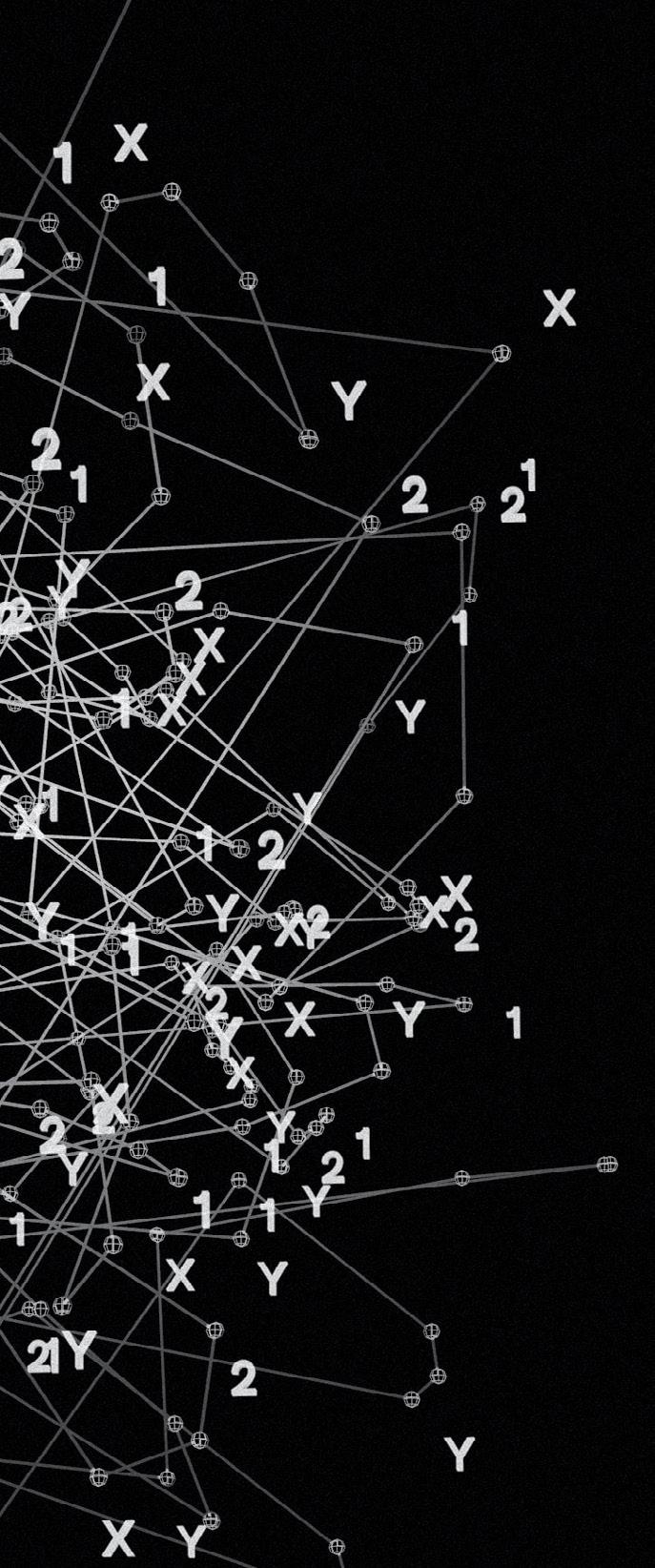
121
PART ONE: WHAT IS AT STAKE FOR THE INDIVIDUAL LEARNINGS
In the case of the speaker, by using an observational tool to redirect fixation on the audio trains the recipient to witness any deregulation or reinforcing stimulation, and tap into their vagal tone to balance out the feedback loop.
In other words, when witnessing an increased pulse in the quickened audio’s bpm, the user can train themselves to calm their heart rate internally to lower their pulse and find balance.

122
Instead of creating and adopting products that optimize our human experience, we need to engage with products that immerse us deeper into our bodies and our mindfulness.
HOW WE PRESERVE OUR HUMANNESS IS CRUCIAL TO HOW OUR FUTURE UNFOLDS.
We need products and experiences that increase our capacity to experience nervous system dysregulation without sending us into those panicked or frozen states.
And the way we train our vagal tone, is to rediscover and prioritize our embodied lives.

123
PART ONE: WHAT IS AT STAKE FOR THE INDIVIDUAL LEARNINGS
Our humanness depends on our vagal tone to create balance.
HOW WE PRESERVE OUR HUMANNESS IS CRUCIAL TO HOW OUR FUTURE UNFOLDS.

124
PART TWO

PRESERVING HUMANNESS FOR THE INDIVIDUAL
125 PRESERVING HUMANNESS FOR THE INDIVIDUAL PART TWO
HOW WE PRESERVE OUR HUMANNESS IS CRUCIAL TO HOW OUR FUTURE UNFOLDS.
126
2
127
SOCIETAL PROPOSAL
INDIVIDUAL
WHAT IS AT STAKE
Proposing an intervention on how to preserve our humanness for the individual PRESERVING HUMANNESS FOR THE INDIVIDUAL PART TWO
HOW WE PRESERVE OUR HUMANNESS IS CRUCIAL TO HOW OUR FUTURE UNFOLDS.
128
SUBSECTION Ⓐ THE PROBLEM EXPERIMENT LEARNINGS
129
PART TWO: PRESERVING HUMANNESS FOR THE INDIVIDUAL PROBLEM
Where in the previous section we were focused on technology’s impact on the nervous system, in this section explores technology's impact on our physical bodies.


Many of our jobs require the use of a computer, and often we get so absorbed we neglect our body’s needs. As we explored in the previous section, these technologies have interrupted the ordinary rhythms of our body. Linda Stone, a researcher with Microsoft, coined the term “email apnea” ☀ to describe this phenomenon.


Technology has taken a serious toll on our physical bodies. It disconnects us from our physicality, our humanness.
NY TIMES | KIM MURTON HOW WE PRESERVE OUR HUMANNESS IS CRUCIAL TO HOW OUR FUTURE UNFOLDS.
☀ Stone, Linda. “Just Breathe: Building the Case for Email Apnea.” HuffPost (blog), November 17, 2011. https://www.huffpost.com/entry/just-breathe-building-the_b_85651.
Seventy-Five percent ● of the world is hunched over their smartphones daily. Forty percent ■ of an average person’s waking hours are spent on a screen. More than two hours ▲ of an average person’s time is spent on social media daily. Our upper body and neck posture has slowly but surely arc-ed forward in a concave and cowering position as our muscles habituate to this chronic forward position.

The medical field has dubbed this posture as “Tech Neck Syndrome” ❖ or “Text Neck Syndrome.” This musculoskeletal pain has become increasingly prevalent, specifically in adolescents and young adults who spend significant time on their smartphones. This clinical symptom has led to cervical degeneration, and developmental, psychological and social complications.
● Hestbæk, Lise, Charlotte Leboeuf-Yde, Kirsten Ohm Kyvik, and Claus Manniche. “The Course of Low Back Pain From Adolescence to Adulthood.” Spine 31, no. 4 (February 15, 2006): 468–72. https://doi.org/10.1097/01.brs.0000199958.04073.d9.
■ Howarth, Josh. “Alarming Average Screen Time Statistics (2023).” Exploding Topics (blog), January 13, 2023. https://explodingtopics.com/blog/screen-timestats#:~:text=The%20latest%20figures%20suggest%20the,on%20an%20internet%2Dconnected%20screen.
▲ Moody, Rebecca, and Rebecca Moody. “Screen Time Statistics: Average Screen Time in US vs. the Rest of the World.” Comparitech, March 15, 2023. https://www. comparitech.com/tv-streaming/screen-time-statistics/.
❖ David, Daniela Leite, Cosimo Giannini, Francesco Chiarelli, and Angelika Mohn. “Text Neck Syndrome in Children and Adolescents.” International Journal of Environmental Research and Public Health 18, no. 4 (February 7, 2021): 1565. https://doi.org/10.3390/ijerph18041565.
131
NY TIMES | MIGUEL PORLAN PART TWO: PRESERVING HUMANNESS FOR THE INDIVIDUAL PROBLEM
A typical adult head weighs 10-12 pounds, and bending it forward at a 45 degree angle puts it at nearly 50 pounds of exertion. ●
do to the rest of your body?
A 2019 New York Times article shared shocking X-ray images of a 28 year old who started to grow horns on the base of their skull from spending too much time hunched over on cell phones. ■
● Flayton, Leigh, and Leigh Flayton. “How to Prevent ‘Tech Neck’” NewYorkPresbyterian, February 9, 2023. https://healthmatters.nyp.org/how-to-preventtech-neck/.
■ Grady, Denise. “About the Idea That You’re Growing Horns From Looking Down at Your Phone ….” The New York Times, June 24, 2019. https://www.nytimes. com/2019/06/20/health/horns-cellphones-bones.html.

132
Just imagine constantly holding a 50 pound dumbbell on your neck. What would that
OCH SPINE AT NEW YORK PRESBYTERIAN
HOW WE PRESERVE OUR HUMANNESS IS CRUCIAL TO HOW OUR FUTURE UNFOLDS.

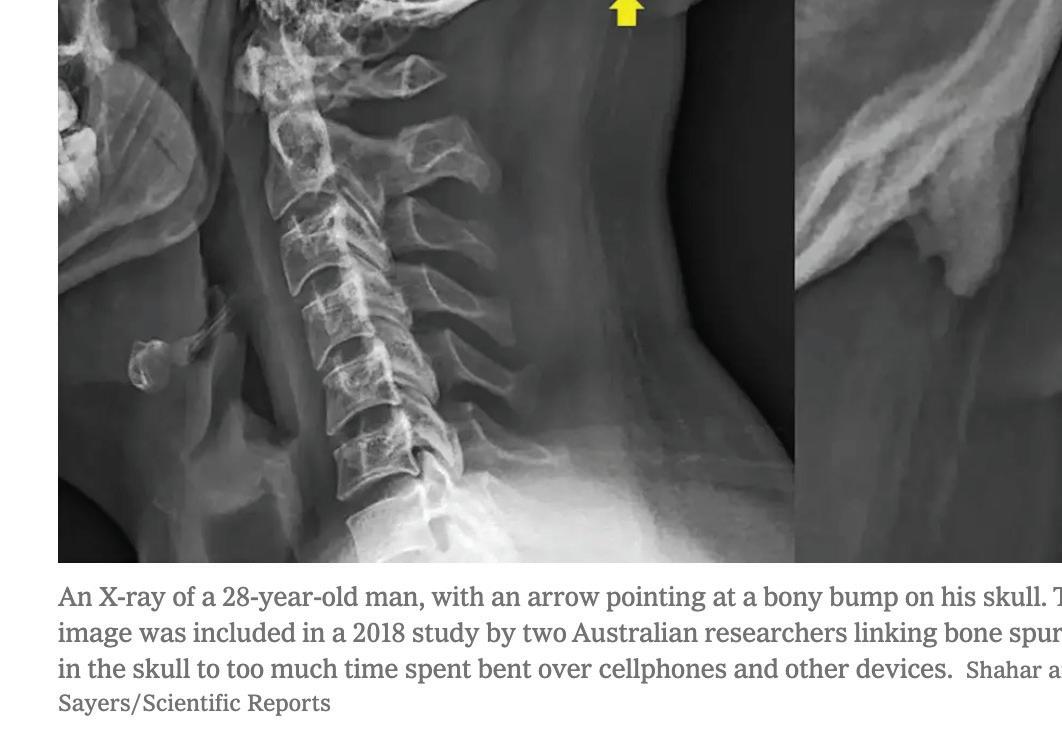
133 PART TWO: PRESERVING
THE INDIVIDUAL PROBLEM
HUMANNESS FOR
Futurists have even projected that our bodies will grow hunched over in the year 3000 because of it. ●
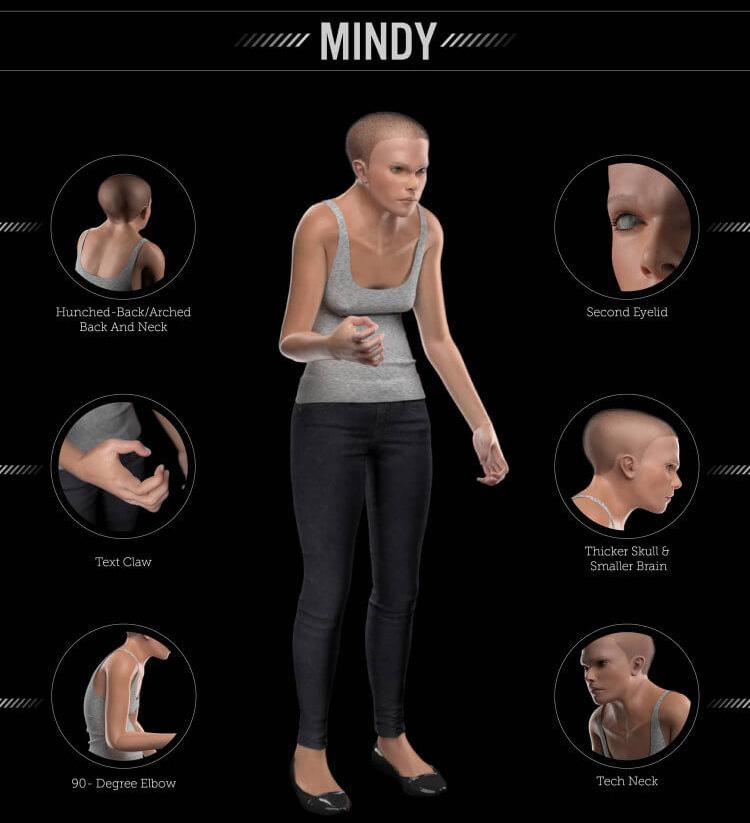
134 HOW
WE PRESERVE OUR HUMANNESS IS CRUCIAL TO HOW OUR FUTURE UNFOLDS.
So, the next question I asked to preserve our humanness was
Can we introduce a way for people constantly on their phones to take short breaks that benefit their body and brain?
Can this occur without forcing the confiscation of a phone and instead physicalize the interface?
● TollFreeForwarding.com. “From Text Claw to Tech Neck: How Technology Affects Our BodiesTollFreeForwarding.Com,” January 7, 2022. https://tollfreeforwarding.com/blog/from-text-claw-to-techneck-how-technology-affects-our-bodies/.
135
PART TWO: PRESERVING HUMANNESS FOR THE INDIVIDUAL PROBLEM
HOW WE PRESERVE OUR HUMANNESS IS CRUCIAL TO HOW OUR FUTURE UNFOLDS.
136
SUBSECTION Ⓑ
THE PROBLEM EXPERIMENT LEARNINGS
137
PART TWO: PRESERVING HUMANNESS FOR THE INDIVIDUAL EXPERIMENT
To explore this, I created the Human-break App, a micro-intervention designed to bring us back to our humanness by getting us back in touch with our bodies and physicality.

138
HOW WE PRESERVE OUR HUMANNESS IS CRUCIAL TO HOW OUR FUTURE UNFOLDS.

139 PART TWO: PRESERVING HUMANNESS FOR THE INDIVIDUAL EXPERIMENT
The main function of the app is to prompt phone users to take a screen-less, embodied break.
The app aims to tackle tech-neck syndrome in an easily adoptable manner by interrupting habits of doom-scrolling with notification-based reminders.
The reminders are scheduled and customized by the user, using the phone’s embedded accelerometer, to sense a lack of movement while the phone is in use.
Clicking on the banner notification that pops up takes the user to the Human Break App, where a haptic-based simulation prompts body movements designed to relieve “tech neck” and retrain posture.
140
HOW WE PRESERVE OUR HUMANNESS IS CRUCIAL TO HOW OUR FUTURE UNFOLDS.


141
EXPERIMENT
PART TWO: PRESERVING HUMANNESS FOR THE INDIVIDUAL
142
HOW WE PRESERVE OUR HUMANNESS IS CRUCIAL TO HOW OUR FUTURE UNFOLDS.
These short interactions utilize the physics of gravity to trigger the haptic feedback on phones so that your touch senses are activated.
Prompt:

Action:


143
PART TWO: PRESERVING HUMANNESS FOR THE INDIVIDUAL EXPERIMENT
Using the developer mode on the iPhone and XCode, I was able to upload and test a haptic-based sample code into a prototype app.


Then by tweaking a couple lines of the code, I was able to get a rough idea of how this app felt in real life.

144
HOW WE PRESERVE OUR HUMANNESS IS CRUCIAL TO HOW OUR FUTURE UNFOLDS.
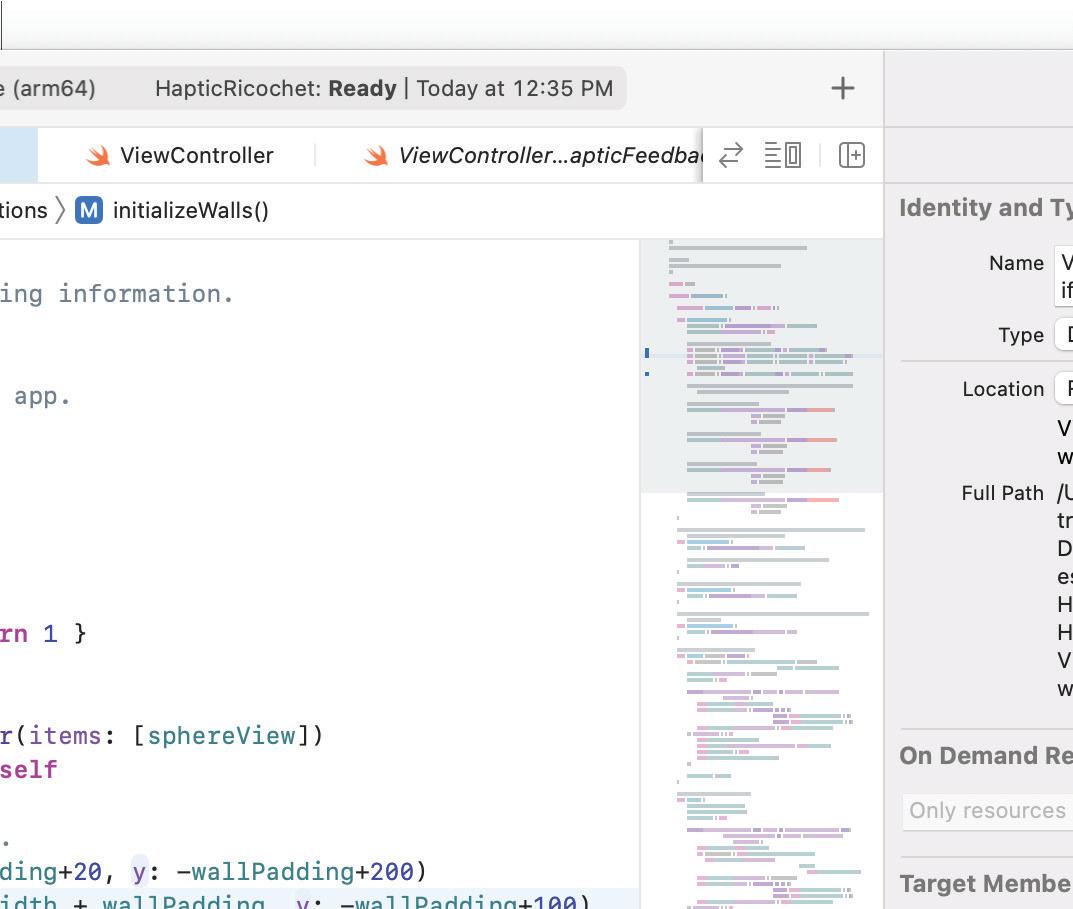

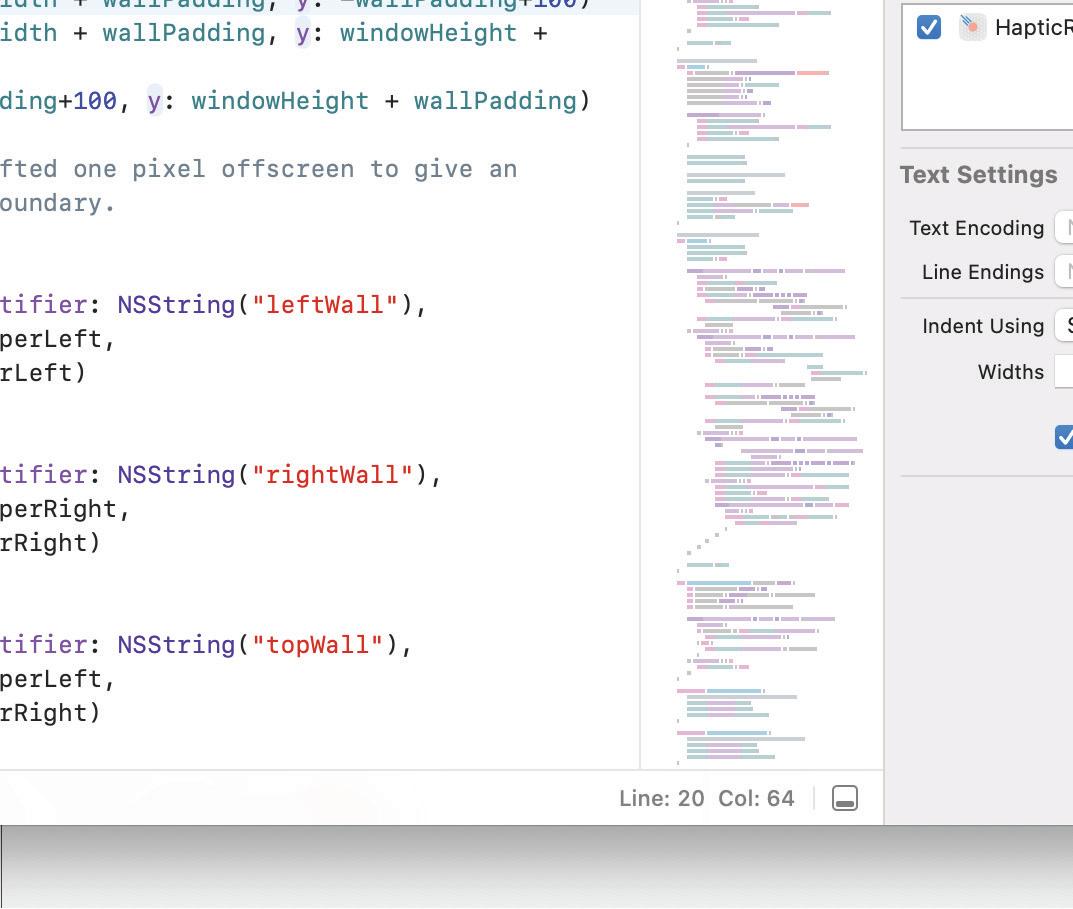
145 PART
EXPERIMENT
TWO: PRESERVING HUMANNESS FOR THE INDIVIDUAL
Then the haptic simulation introduces an embodied challenge, making the entire simulation screen-less.
This one prompts you to place the back of the phone to the back of your neck, and rock your upper body from side to side.
146
HOW WE PRESERVE OUR HUMANNESS IS CRUCIAL TO HOW OUR FUTURE UNFOLDS.


147
PART TWO: PRESERVING HUMANNESS FOR THE INDIVIDUAL EXPERIMENT
HOW WE PRESERVE OUR HUMANNESS IS CRUCIAL TO HOW OUR FUTURE UNFOLDS.

148148
PART TWO: PRESERVING HUMANNESS FOR THE INDIVIDUAL EXPERIMENT

149149
With this open and widened position, the neck and spine is lengthened which relieves the tightness in the cervical and thoracic spine.

This is especially important to counter the concave and hunched over position most people have when using their phones. ●

150
GUARDIAN GRAPHIC | SURGICAL TECHNOLOGY INTERNATIONAL OPTIMUM EXERCISE PHYSIOLOGY HOW WE PRESERVE OUR HUMANNESS IS CRUCIAL TO HOW OUR FUTURE UNFOLDS.

151
OPTIMUM EXERCISE PHYSIOLOGY
Schoenfeld, Amy. “Soothing Back Pain by Learning How to Sit Again.” The New York Times, May 11, 2013. https://www.nytimes.com/2013/05/12/business/soothing-back-pain-by-learning-how-to-sit-again. html?action=click&module=RelatedLinks&pgtype=Article. PART TWO: PRESERVING HUMANNESS FOR THE INDIVIDUAL EXPERIMENT
The side to side action activates your obliques and mobilizes the stiff trunk of our bodies.
●
HOW WE PRESERVE OUR HUMANNESS IS CRUCIAL TO HOW OUR FUTURE UNFOLDS.

152

153 ANATOMY STANDARD | BIOMECHANICS OF THE SPINE
PART TWO: PRESERVING HUMANNESS FOR THE INDIVIDUAL EXPERIMENT
● Raits, Janis Savlovskis Kristaps. “Biomechanics of the Spine: The ROM of the Spine,” n.d. https://www. anatomystandard.com/biomechanics/spine/rom-of-spine.html.
HOW WE PRESERVE OUR HUMANNESS IS CRUCIAL TO HOW OUR FUTURE UNFOLDS.
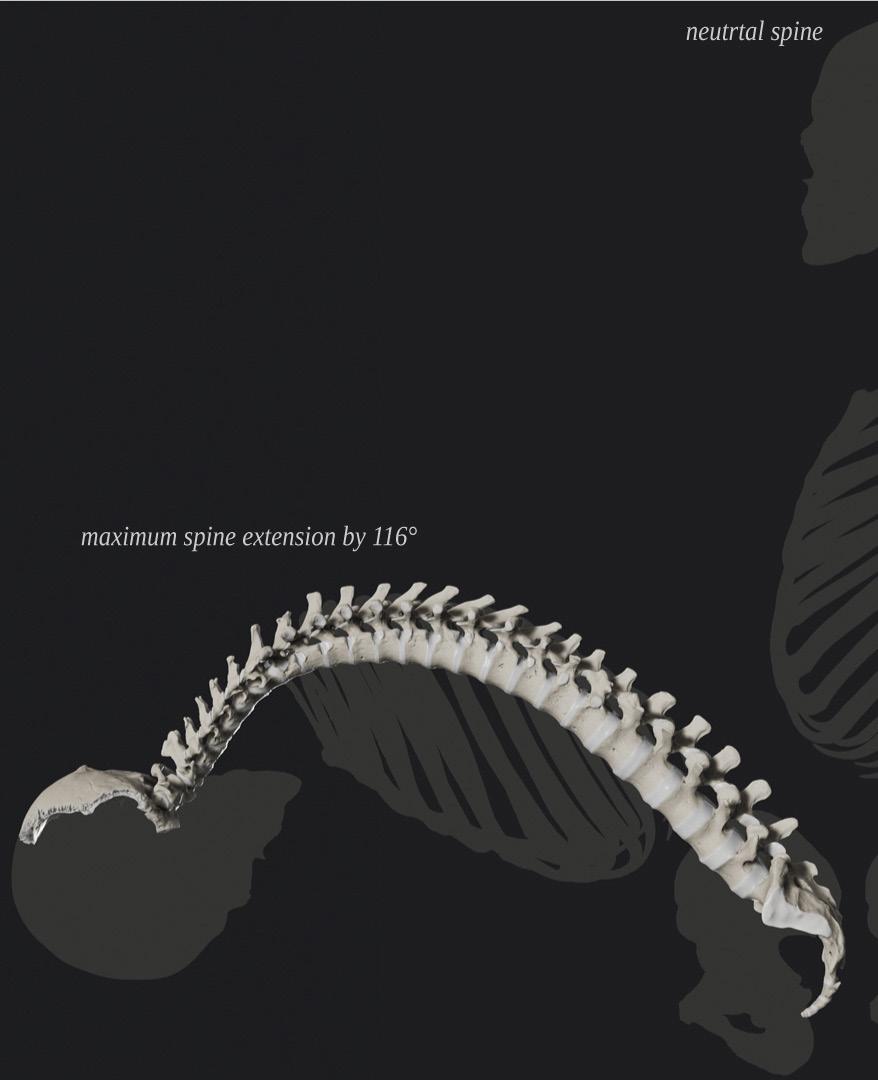
154
ANATOMY STANDARD | BIOMECHANICS OF THE SPINE
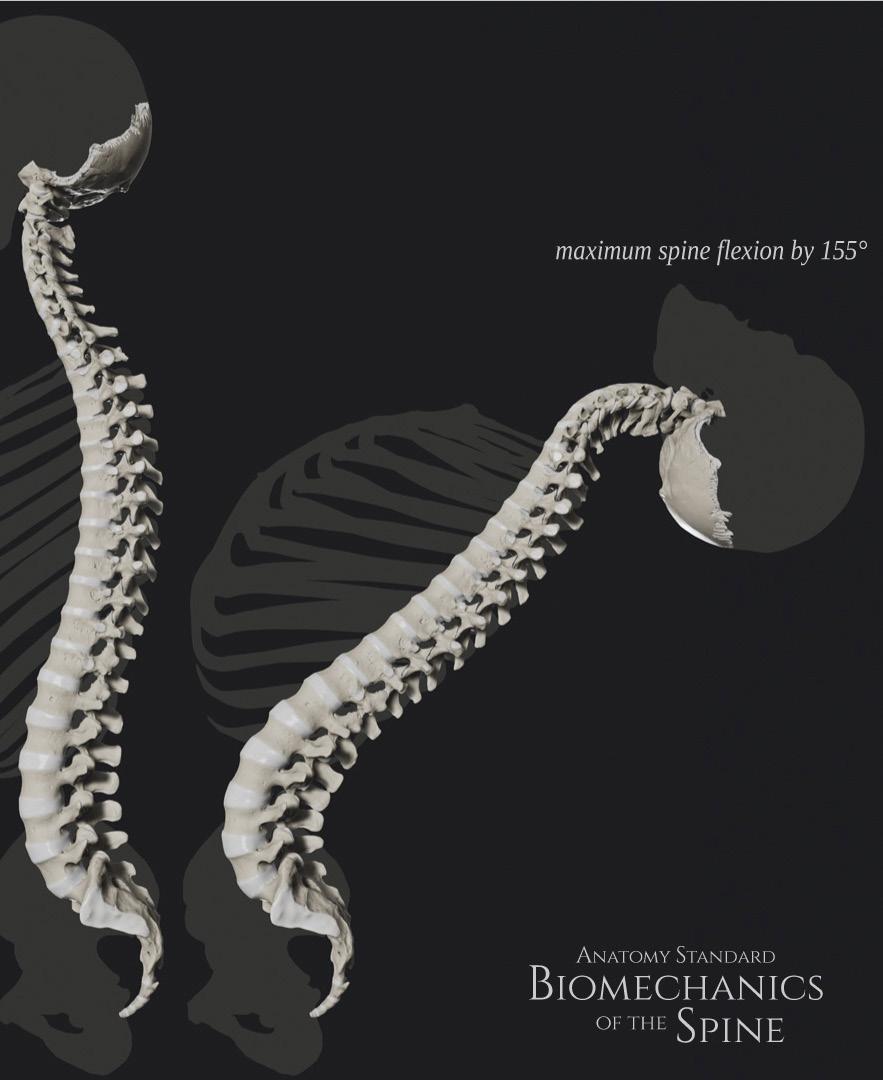
155
PART TWO: PRESERVING HUMANNESS FOR THE INDIVIDUAL EXPERIMENT
● Raits, “Biomechanics of the Spine: The ROM of the Spine”
● Cuddy, Amy. “Your Body Language May Shape Who You Are,” n.d. https://www.ted. com/talks/amy_cuddy_your_body_language_may_shape_who_you_are/c.
156
This position is also associated with a “high power pose”, ● in which psychological studies have shown that holding a high power pose before situations of high stakes or stress can increase confidence and self-assurance.
HOW WE PRESERVE OUR HUMANNESS IS CRUCIAL TO HOW OUR FUTURE UNFOLDS.

157 PART TWO: PRESERVING
THE INDIVIDUAL EXPERIMENT
HUMANNESS FOR
To develop deeper engagement and increase the user's awareness in how the usage of phones are in fact impacting their poster, it was important to provide a feedback loop to lay out observable outcomes.
158
The entire intervention is just 40 seconds, but its consistency is what makes a difference to the body.
HOW WE PRESERVE OUR HUMANNESS IS CRUCIAL TO HOW OUR FUTURE UNFOLDS.
If we provide users with a feedback loop that shows an observable outcome, then we will observe deeper engagement and an increase in awareness of how phones are impacting our postures.

159
PART TWO: PRESERVING HUMANNESS FOR THE INDIVIDUAL EXPERIMENT
HOW WE PRESERVE OUR HUMANNESS IS CRUCIAL TO HOW OUR FUTURE UNFOLDS.

160

161 EXPERIMENT
HOW WE PRESERVE OUR HUMANNESS IS CRUCIAL TO HOW OUR FUTURE UNFOLDS.

162
This is why the app also includes a posture analysis tool, which measures the severity of each posture angle and tracks its improvement through detailed progress indicators.

163
PART TWO: PRESERVING HUMANNESS FOR THE INDIVIDUAL EXPERIMENT
This posture-analysis tool uses computer vision and image recognition to assess the geometry angles and provide personalized recommendations.


164
HOW WE PRESERVE OUR HUMANNESS IS CRUCIAL TO HOW OUR FUTURE UNFOLDS.


165 PART TWO: PRESERVING HUMANNESS FOR THE INDIVIDUAL EXPERIMENT
HOW WE PRESERVE OUR HUMANNESS IS CRUCIAL TO HOW OUR FUTURE UNFOLDS.
166
SUBSECTION Ⓒ
THE PROBLEM EXPERIMENT LEARNINGS
167
PART TWO: PRESERVING HUMANNESS FOR THE INDIVIDUAL LEARNINGS
HOW WE PRESERVE OUR HUMANNESS IS CRUCIAL TO HOW OUR FUTURE UNFOLDS.

168
The more in touch we are with our bodies while using technology, the less likely we are to fall into the vicious cycles of dysregulation and physical degeneration.
169
PART TWO: PRESERVING HUMANNESS FOR THE INDIVIDUAL LEARNINGS
Our humanness is reinforced by our physicality.

170
We must ask the hard questions of when technology fails to consider our humanness and from there make adjustments that can re-incorporate this.
HOW WE PRESERVE OUR HUMANNESS IS CRUCIAL TO HOW OUR FUTURE UNFOLDS.
The Human Break App is one such adjustment intended to inspire more designs around physicalized interfaces.
Micro-interventions like these are plentiful.
And we should continue to develop products and services that aim to embrace the concept of re-assessing our relationship with technology and re-habituating how we use technology.
We cannot underestimate the power of small solutions like these.
We are too deeply entangled in a web of complex issues that micro-interventions are the way to patiently retrace our footsteps and undo some of these knots.
171
PART TWO: PRESERVING HUMANNESS FOR THE INDIVIDUAL LEARNINGS
HOW WE PRESERVE OUR HUMANNESS IS CRUCIAL TO HOW OUR FUTURE UNFOLDS.

172
When user testing the Human Break App, I noticed that the majority of my assigned testers leaned into the “community” feature of the application. This community feature was an icon placed in the menu bar, alluding to a leaderboard feature and the ability to connect with others doing the simulations of the Human Break App. It was reported that checking in on progress and interacting with friends and people around them would get these users more excited about continuing this micro-intervention in the long run.

173
PART TWO: PRESERVING HUMANNESS FOR THE INDIVIDUAL LEARNINGS

HOW WE PRESERVE OUR HUMANNESS IS CRUCIAL TO HOW OUR FUTURE UNFOLDS.
Humans are social beings, we crave connection and relationships even in the most solo activities.
Even though I designed the Human Break App as a proposal to preserve our humanness on an individual scale, there was a desire to shift this over to the collective and incorporate community.
This is why exploring what can be at stake where we integrate with technology on a collective level is a paramount next step.
175
PART TWO: PRESERVING HUMANNESS FOR THE INDIVIDUAL LEARNINGS
HOW WE PRESERVE OUR HUMANNESS IS CRUCIAL TO HOW OUR FUTURE UNFOLDS.

PART THREE

WHAT IS AT STAKE FOR THE COLLECTIVE
WHAT IS AT STAKE FOR THE COLLECTIVE PART THREE
HOW WE PRESERVE OUR HUMANNESS IS CRUCIAL TO HOW OUR FUTURE UNFOLDS.
178
Revealing what is at stake for the societal scale in the future where our bodies & tech meet
(A future lens was crucial in uncovering human behavior & perspectives - using the tools of “Retrospection” & “Storytelling”)
179 INDIVIDUAL SOCIETAL PROPOSAL
WHAT
IS AT STAKE
3 WHAT IS AT STAKE FOR THE COLLECTIVE PART THREE
HOW WE PRESERVE OUR HUMANNESS IS CRUCIAL TO HOW OUR FUTURE UNFOLDS.
180
SUBSECTION Ⓐ
THE PROBLEM EXPERIMENT LEARNINGS
181 PART THREE: WHAT IS AT STAKE FOR THE COLLECTIVE PROBLEM
We’ve explored how technology impacts our physical bodies, but what about its impact on our behavior and our emotions?

182
HOW WE PRESERVE OUR HUMANNESS IS CRUCIAL TO HOW OUR FUTURE UNFOLDS.
183
PART THREE: WHAT IS AT STAKE FOR THE COLLECTIVE PROBLEM
In this section, I explore how humanity’s fascination with augmenting our lives to make fantasy a reality actually has a dehumanizing side.
Our understanding of this augmented age is highly influenced by pop culture and science fiction stories.

184
HOW WE PRESERVE OUR HUMANNESS IS CRUCIAL TO HOW OUR FUTURE UNFOLDS.
Movies that illustrate cyborgs as the ultimate entanglement of machinery and organic human parts.

185 PART THREE: WHAT IS AT STAKE FOR THE COLLECTIVE PROBLEM
HOW WE PRESERVE OUR HUMANNESS IS CRUCIAL TO HOW OUR FUTURE UNFOLDS.


186
This is why we love superhero movies and science fiction stories.
When we think cyborgs, we think terminator. We think of barriers between our bodies and technology removed, and a new type of human species that is faster, stronger, smarter, and better.


187 PART THREE: WHAT IS AT STAKE FOR THE COLLECTIVE PROBLEM
I had the privilege of speaking to biomedical engineers and neuroscientists in the brain-tech convergence field, to learn more about the academic research behind understanding our brains and its potential to communicate with machines.
Dr Banu Onaral, a biomedical engineer with a neuroengineering focus and H.H. Sun Professor of Biomedical Engineering and Electrical Engineering at Drexel University in Philadelphia, shared that there is still so much we are unable to understand about the brain and the body, and this lack of understanding makes for speculations of uploading our consciousness or fears of machines taking control of our bodies impossible.
188
●
Feb 5th 2023 HOW WE PRESERVE OUR HUMANNESS IS CRUCIAL TO HOW OUR FUTURE UNFOLDS.
She further warns that ethicists who continue to conjure up fear around the research in brain-tech convergence actually do more harm than good for our society.
●
Interview with Dr Banu Onaral,
These depictions drive fear and could lead to stringent policing around research efforts.
While policy should be actively designed and executed, the fear-mongering used to enact tight regulations have led to detrimental funding “winters” in the science field.
Similar winters, also known as AI Winters, occurred in the 1970s and late 1980s, which led to a huge displacement of job security for experts who dedicate their life’s work to the field. ■
189
■ Ai.nl. “What Are the AI Winters?” Ai.Nl, May 21, 2022. https://www.ai.nl/knowledge-base/what-are-the-ai-winters/.
PART THREE: WHAT IS AT STAKE FOR THE COLLECTIVE PROBLEM
Futurists need to be careful in how they tell fictional speculations of certain technological advancements.
Science fiction, as a popular genre, has played a significant role in shaping our vision of the future. However, science fiction often reflects and reinforces certain cultural, social, and technological biases that can be problematic.

Its representations of "cyborg" populate the Western imaginary with hyper-masculine, hard bodies that are often ultra-muscular and over-sexualized bodies.
These representations are embedded in and imbued with whiteness, informed by heteronormativity and ablebodiedness, intertwined with gendering, racialization and sexualization. ●
190
HOW WE PRESERVE OUR HUMANNESS IS CRUCIAL TO HOW OUR FUTURE UNFOLDS.
On top of that, many of these narratives depict dystopian futures characterized by technological catastrophes, alien invasions, or post-apocalyptic scenarios, reinforcing a sense of fear and anxiety about the unknown.
These narratives often prioritize sensationalism and dramatic conflicts, overlooking the nuances and complexities of the real world. This is the exact issue Dr Banu Onaral referenced as problematic within the futuring field. ■
We end up building metaphorical walls that amplify these echo chambers, making it difficult to adopt a more-than-human perspective to reassess the systems that govern us.
This anthropocentric lens fails to capture the interconnectedness and interdependencies of our world, and perpetuates a narrow and limited perspective on the possibilities of the future.
● Dalibert, L. “Posthumanism and Somatechnologies : Exploring the Intimate Relations between Humans and Technologies.” PhD, University of Twente, 2014. https://doi.org/10.3990/1.9789036536516.
■ Interview with Dr Banu Onaral, Feb 5th 2023
191
Through a lens that centers on human exceptionalism, fictional narratives often portray humans as the dominant and central figures in the future, while other entities are marginalized or reduced to supporting roles.
PART THREE: WHAT IS AT STAKE FOR THE COLLECTIVE PROBLEM
In an interview with Dr Kerem Dündar, neuroscientist and founder of London School of Mind, shared that as technology changes our behavior, it also changes our minds.
“Our minds cannot think easily if they believe everything. We need to be asking more and more. We need to teach about asking. We need to handle the world by asking, not learning. Knowing is no longer important now." ▶
– DR KEREM DÜNDAR
Dr Dündar identifies a pivotal moment that we have most recently faced head on – the prevalence of generative AI with the public launch of ChatGPT, Bing AI Chat, and Google’s Bard and text-to-image AI generators like Dall-E and Midjourney. While students are given the gift of a chatbot that generates answers with a click of a button, academic institutions are faced with ethical considerations of whether these technologies should be banned.
Dr Banu Onaral also raised the issue that the information regurgitated by these AI chatbots follow auto regressive modeling. Due to the overwhelming amounts of bad data, AI chatbots end up being the biggest misinformation machine that people often mistake as truth.
192
The most important thing we need to do as a civilization is to train our minds for critical thinking and resiliency.
▶
Feb 6th 2023 HOW WE PRESERVE OUR HUMANNESS IS CRUCIAL TO HOW OUR FUTURE UNFOLDS.
Interview with Dr Kerem Dündar,

PART THREE: WHAT IS AT STAKE
THE COLLECTIVE PROBLEM
FOR
These interviews were crucial in shaping how I developed the experiment to reveal what was at stake for us on the societal scale. I chose a new unfamiliar mode of design, speculative fiction writing, and immersed myself in the creation of a world where augments remained a central theme in this future.
I wanted to ensure that I was designing a product that would prompt its audience to ask more questions, rather than feel gratified by proposed solutions.
It was imperative that my stories and the way I shared them with my audience would lead to more conversations and ruminations around complex societal topics of enhancement and technology.
194
We have yet to fully comprehend the potential unintended consequences of our rapidly developing human-enhancement innovations. And that makes for conversation around these topics difficult to conceptualize and discuss.
HOW WE PRESERVE OUR HUMANNESS IS CRUCIAL TO HOW OUR FUTURE UNFOLDS.
But by tapping into people’s emotions through fiction, we can utilize the power of storytelling to engage and prompt considerations for these complex topics.
How will our bodies look and feel in the future?
I wrote a number of short stories centering around this question, depicting the techno-infused world we could be headed towards.
I turned these stories into an ethnographic experiment to observe the conversations these stories would spark amongst my friends.
These speculated futures were designed to create discussion around difficult-to-access topics like “whose responsibility is it to protect us from the climate crisis?” and “what does it really mean to be human?”
195
PART THREE: WHAT IS AT STAKE FOR THE COLLECTIVE PROBLEM
HOW WE PRESERVE OUR HUMANNESS IS CRUCIAL TO HOW OUR FUTURE UNFOLDS.
196
SUBSECTION Ⓑ
THE PROBLEM EXPERIMENT LEARNINGS
197
PART THREE: WHAT IS AT STAKE FOR THE COLLECTIVE EXPERIMENT
198
HOW WE PRESERVE OUR HUMANNESS IS CRUCIAL TO HOW OUR FUTURE UNFOLDS.
I imagined a speculated world where augmentation is commonplace and has changed the way our bodies function and adapt to climate crises.
The stories revealed what was at stake with our current dependencies on wearable tech, as well as our wish for enhancement through bio-tech.
They centered around a body augmentation clinic called “Bio forming studio”.
199
PART THREE: WHAT IS AT STAKE FOR THE COLLECTIVE EXPERIMENT




200 HOW WE PRESERVE OUR HUMANNESS IS CRUCIAL TO HOW OUR FUTURE UNFOLDS.




201 PART THREE: WHAT IS AT STAKE FOR THE COLLECTIVE EXPERIMENT

202202 HOW WE PRESERVE OUR HUMANNESS
CRUCIAL
OUR
IS
TO HOW
FUTURE UNFOLDS.

203
203 PART THREE: WHAT IS AT STAKE FOR THE COLLECTIVE EXPERIMENT
The year is 2100.
Set 77 years into the future, in the year 2100, this dystopian world was written from the point of view
The story introduces two of her patrons each coming from different walks of life.
In this story, humanity was battling unforgiving temperatures and unexpected weather changes, unforgiving temperatures and unexpected weather changes, and humans were looking to push the limitations of their bodies for resiliency.
204
of a woman working at the front desk of “Bio-forming studio”.
HOW WE PRESERVE OUR HUMANNESS IS CRUCIAL TO HOW OUR FUTURE UNFOLDS.
Adapting to the climate crisis is prioritized for survival, therefore the body augments patrons sought were animal-inspired, like second skin and back ribbing to acclimate to the heat.

205
LOES VOEMAN, COMMUNITY OF SYMBIOSIS, 2021 PART THREE: WHAT IS AT STAKE FOR THE COLLECTIVE EXPERIMENT
It was my excursion into idyllic fantasies of our body’s capabilities within the context of our climate futures.

206
HOW WE PRESERVE OUR HUMANNESS IS CRUCIAL TO HOW OUR FUTURE UNFOLDS.
She is illustrated as a character battling emotional turmoil, set deep in a scarcity mindset to survive and relieve her discomfort.
Issues of child bearing, genetic engineering to fix any born-defects, and women’s biological role in humanity come up with this character’s development.
207
Chapter one introduces a pregnant woman, Caroline, who is faced with the tension of putting herself or the fetus first.
PART THREE: WHAT IS AT STAKE FOR THE COLLECTIVE EXPERIMENT
HOW WE PRESERVE OUR HUMANNESS IS CRUCIAL TO HOW OUR FUTURE UNFOLDS.

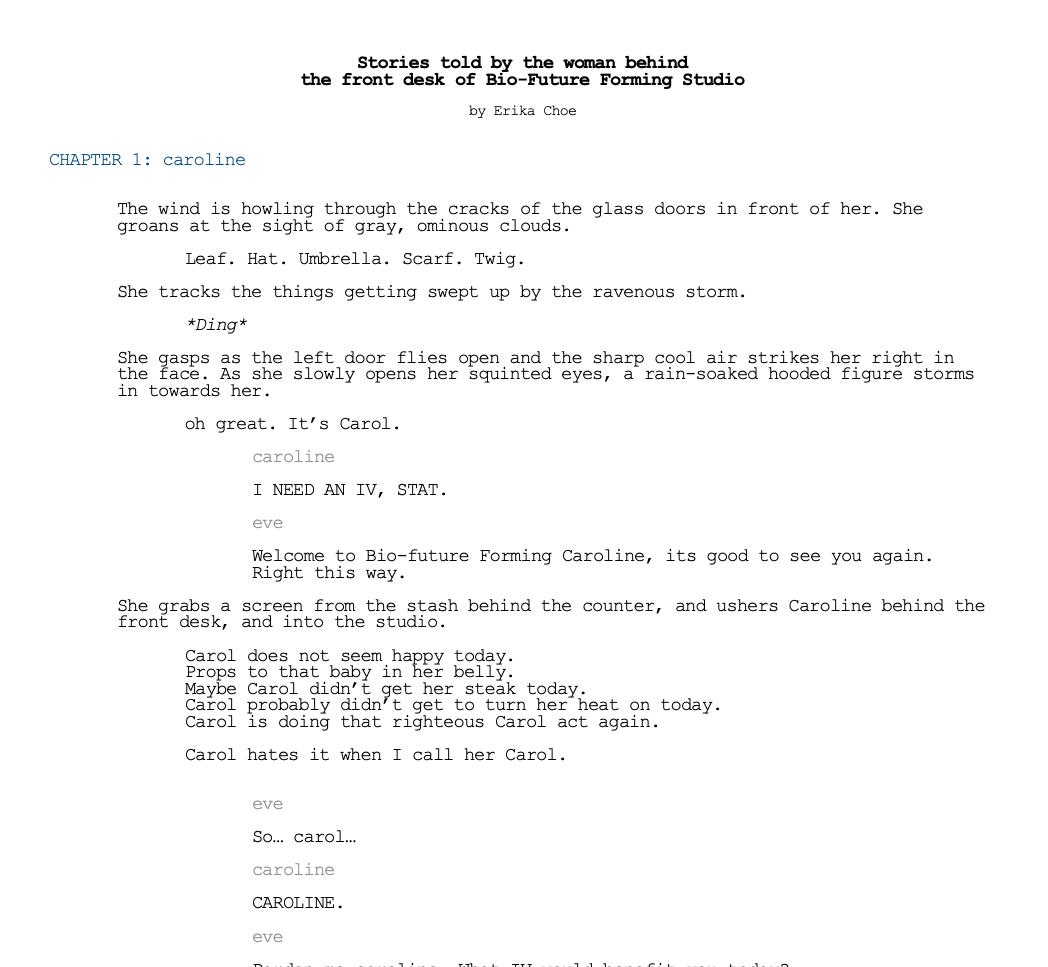
208

209 PART THREE: WHAT IS AT STAKE FOR THE COLLECTIVE EXPERIMENT
We learn through his transactions that a carbon credit policy has enabled those who control their personal carbon footprint to have more monetary ability than those who actively contribute to carbon emissions. Without a home, electricity or vehicles, climate refugees are able to receive the maximum amount of credits every day.
Adam’s strong economic standing empowered him to gather the like, and become the face of the ‘SelfResilient Movement’, a community of climate refugees collectively rising up the social ladder towards power.
210
Chapter two told the story of a climate refugee, Adam, who has achieved a high socio-economic standing due to a new system that the state has put in place to support those who have been displaced from their homes.
HOW WE PRESERVE OUR HUMANNESS IS CRUCIAL TO HOW OUR FUTURE UNFOLDS.
211
PART THREE: WHAT IS AT STAKE FOR THE COLLECTIVE EXPERIMENT
While this character explores a system that empowers the have-nots with limitless capacity to enact positive change, we observe that power and empathy do not go hand-in-hand.
HOW WE PRESERVE OUR HUMANNESS IS CRUCIAL TO HOW OUR FUTURE UNFOLDS.


212


213 PART THREE: WHAT IS AT STAKE FOR THE COLLECTIVE EXPERIMENT
HOW WE PRESERVE OUR HUMANNESS IS CRUCIAL TO HOW OUR FUTURE UNFOLDS.












214





PART THREE: WHAT IS AT STAKE FOR THE COLLECTIVE EXPERIMENT
I expanded on these short stories by flipping the narrator role over to Caroline and Adam in chapters three and four.
216
HOW WE PRESERVE OUR HUMANNESS IS CRUCIAL TO HOW OUR FUTURE UNFOLDS.
In chapter three, we learn more about Caroline’s background and what she sees, hears, feels, experiences first, discovering that she in fact plays the role of a surrogate mother, in a larger system that mimics a “baby farm”.
We learn about the intricacies of this surrogacy clinic, as well as how the rich or privileged have found loopholes around the carbon credit policy system.
217
PART THREE: WHAT IS AT STAKE FOR THE COLLECTIVE EXPERIMENT
HOW WE PRESERVE OUR HUMANNESS IS CRUCIAL TO HOW OUR FUTURE UNFOLDS.
218


219 PART THREE: WHAT IS AT STAKE FOR THE COLLECTIVE EXPERIMENT
HOW WE PRESERVE OUR HUMANNESS IS CRUCIAL TO HOW OUR FUTURE UNFOLDS.
220
Chapter four shares Adam’s point of view, where we learn about the bittersweet satisfaction he and his community of climate refugees are able to experience despite their conditions.
221
PART THREE: WHAT IS AT STAKE FOR THE COLLECTIVE EXPERIMENT
HOW WE PRESERVE OUR HUMANNESS IS CRUCIAL TO HOW OUR FUTURE UNFOLDS.
222


223 PART THREE: WHAT IS AT STAKE FOR THE COLLECTIVE EXPERIMENT

HOW WE PRESERVE OUR HUMANNESS IS CRUCIAL TO HOW OUR FUTURE UNFOLDS.
How the bodies look and feel in this future extends beyond what we can comprehend today, speculating a blend of biological capabilities from other species that makes for adapting to climate changes more efficiently.
We also learn about a tension between tech-augmented humans and bio-augmented humans, bringing up the question of how mainstream aesthetics of augmented humans will get redefined – a parallel to how social media has driven an aesthetic shift in what is considered beauty and desirable.
225
PART THREE: WHAT IS AT STAKE FOR THE COLLECTIVE EXPERIMENT
HOW WE PRESERVE OUR HUMANNESS IS CRUCIAL TO HOW OUR FUTURE UNFOLDS.
226
SUBSECTION Ⓒ
THE PROBLEM EXPERIMENT LEARNINGS
227
PART THREE: WHAT IS AT STAKE FOR THE COLLECTIVE LEARNINGS
I designed co-creation worksheets and used them as guideposts to facilitate intimate workshops with friends. I engaged with about 12 participants over the span of 4 different workshops, gathering their thoughts and feelings about this speculated future.
The goal was to activate a lively discussion on systemic factors at play when thinking about our future.

228
HOW WE PRESERVE OUR HUMANNESS IS CRUCIAL TO HOW OUR FUTURE UNFOLDS.
Collectively, participants were quick to imagine dystopian futures, leading to revelations about how the human species might evolve for the worse. This allows for room to utilize utopian thinking as a method to educate desire and generate hope.


229
PART THREE: WHAT IS AT STAKE FOR THE COLLECTIVE LEARNINGS
When tasked to imagine their version of a character in this world, most participants chose to create characters that lived in the fringes of this society.


230
230 HOW WE PRESERVE OUR HUMANNESS IS CRUCIAL TO HOW OUR FUTURE UNFOLDS.
These characters either rejected the hypertechnologized tendencies of this future, or played a role but had a hidden life that went against the system.



231
PART THREE: WHAT IS AT STAKE FOR THE COLLECTIVE LEARNINGS
The most fascinating thing was that every character had the intention of safekeeping items or materials that were “vintage” or reminiscent of the old ways. The desire for old products and the yearning to go back to old methods were almost unanimous, suggesting that nostalgia follows us however far we imagine our futures.
The results of these workshops point to clear design guidelines for future experiments.




232 HOW WE PRESERVE OUR HUMANNESS IS CRUCIAL TO HOW OUR FUTURE UNFOLDS.


233 PART THREE: WHAT IS AT STAKE FOR THE COLLECTIVE LEARNINGS
As participants embodied characters in this world, I noticed that 90% of them felt forced to adopt cutthroat attitudes and be out for themselves.
234
HOW WE PRESERVE OUR HUMANNESS IS CRUCIAL TO HOW OUR FUTURE UNFOLDS.
The stories placed the responsibility of augmenting the self in the hands of the individual, where changing the ways our bodies functioned to adapt for the climate crisis was an individual responsibility.
These bring up questions of who is held accountable for how we survive our climate crisis in the future?
What kinds of systems will be successful in driving community building and resilience?
What kinds of systems will lead to unforeseen consequences that might pull us further away as a society and aggravate stratification?
235
PART THREE: WHAT IS AT STAKE FOR THE COLLECTIVE LEARNINGS
It was the act of technologically enhancing the self that dehumanized this world.
One of the participants pointed out:
CO-CREATION WORKSHOP PARTICIPANT #1
This was why every listener of these stories felt uncomfortable, felt scared, felt concerned about its possibility, and ultimately fell into dystopian imaginations of this world.
It also explained why no matter how hard I tried to twist the systemic levers in this world, I was stuck in a narrative of power struggles and competitiveness.
236
“It is inherently wrong to place the responsibility of "survival" on the individual when the system should be doing all it can to support and undo the wrongdoings of global warming."
–
HOW WE PRESERVE OUR HUMANNESS IS CRUCIAL TO HOW OUR FUTURE UNFOLDS.
There was a collective concern that we would be acting out of survival.

This finding showed a parallel that we are already experiencing these survival states without realizing we are, the stories were a catalyst to bring these concerns to light.

The reason why we are able to project such concerns about “survival” is because our survival states have been re-activated through the way we’ve started to innovate on technology.


237
PART THREE: WHAT IS AT STAKE FOR THE COLLECTIVE LEARNINGS
238
HOW WE PRESERVE OUR HUMANNESS IS CRUCIAL TO HOW OUR FUTURE UNFOLDS.
When we started to break down what it really means to be human, there was a unanimous craving for connection and care as a community.
Another participant pointed out:
I knew that my next experiment had to shift this lens completely to accommodate for this learning.
239
“To be human, means that we are able to acknowledge that there is somebody outside of me who can feel something as a consequence of what I do."
– CO-CREATION WORKSHOP PARTICIPANT #2
PART THREE: WHAT IS AT STAKE FOR THE COLLECTIVE LEARNINGS
This experiment demonstrates the power that designers have to tell stories with optimistic or pessimistic lenses.
To envision a sustainable future, we need to redefine how we want to prosper and thrive as a society, which requires an ethic of care and a beacon of hope.
240
It calls for a paradigm shift from a fear-based approach to one that embraces interconnectedness, cooperation, and collaboration.
HOW WE PRESERVE OUR HUMANNESS IS CRUCIAL TO HOW OUR FUTURE UNFOLDS.

241 PART THREE: WHAT IS AT STAKE FOR THE COLLECTIVE LEARNINGS
HOW WE PRESERVE OUR HUMANNESS IS CRUCIAL TO HOW OUR FUTURE UNFOLDS.

PART FOUR

PRESERVING HUMANNESS FOR THE COLLECTIVE PRESERVING HUMANNESS FOR THE COLLECTIVE PART FOUR
HOW WE PRESERVE OUR HUMANNESS IS CRUCIAL TO HOW OUR FUTURE UNFOLDS.
244
WHAT IS AT STAKE
Proposing an alternative future that would preserve our humanness for our society
(A future lens was crucial in uncovering human behavior & perspectives - using the tools of “Retrospection” & “Storytelling”)
245 INDIVIDUAL
PROPOSAL
SOCIETAL
4 PRESERVING HUMANNESS FOR THE COLLECTIVE PART FOUR
HOW WE PRESERVE OUR HUMANNESS IS CRUCIAL TO HOW OUR FUTURE UNFOLDS.
246
SUBSECTION Ⓐ
THE PROBLEM EXPERIMENT LEARNINGS
247 PART FOUR: PRESERVING HUMANNESS FOR THE COLLECTIVE PROBLEM
Our humanness comes from being a part of a community.
To preserve our humanness on a societal scale, we need to shift our individualistic lenses and strive for more interdependent and holistic visions of the future.
The Bantu speaking people of South Africa say UBUNTU ● meaning “A person is a person through other people.” or “I am because we are.”

248
HOW WE PRESERVE OUR HUMANNESS IS CRUCIAL TO HOW OUR FUTURE UNFOLDS.
249 “A person is a person
– UBUNTU, A PHILOSOPHY OF THE BANTU SPEAKING PEOPLE OF AFRICA ● “Ubuntu (Philosophy) - New World Encyclopedia,” n.d. https://www. newworldencyclopedia.org/entry/Ubuntu_(philosophy). PART FOUR: PRESERVING HUMANNESS FOR THE COLLECTIVE PROBLEM
through other people."
From the science fiction writing experiment in PART THREE, it was clear that dystopian narratives are easy to imagine and develop.
Human perspectives are inherently limited, as they are shaped by our individual and collective experiences, cultural norms, and beliefs.
This limited point of view prioritizes human needs and desires over the well-being of the environment and other species, resulting in environmental degradation, social injustices, and inequality, ultimately leading to an unsustainable future. It is no wonder we can easily slip into “doomsday” mindsets when speculating about our futures.

250
It is important to critically examine the lens we carry forward in our modes of storytelling and strive for more inclusive, diverse, and holistic visions of the future that challenge traditional biases and promote a more equitable and sustainable worldview.
HOW WE PRESERVE OUR HUMANNESS IS CRUCIAL TO HOW OUR FUTURE UNFOLDS.
Currently, decisions are being made on our behalf, driven by varying motivations, such as prioritizing profits and capital. However, if we continue down this path, we may face catastrophic consequences.

In contrast, we have the potential to envision and create a different future, one that transcends the current paradigm. This invites us to reflect on what it means to be human and expand our understanding of our collective future.
It prompts us to consider whether we are making decisions for everyone in this future, as our actions have far-reaching impacts that transcend generations and affect strangers.
What if our future was guided by different principles? What if we shifted our technoprogressive transhumanist perspectives into Haraway’s posthumanist perspective?
251
Within the realms of shaping our technologized futures, it is crucial to reprogram our way of thinking and establish clear limits and guidelines.
PART FOUR: PRESERVING HUMANNESS FOR THE COLLECTIVE PROBLEM
It can provide a guiding philosophy for reshaping our systems and narratives to embrace alternative systems that model after the interdependence of species like mycelium.

Mycelial network exemplifies a model of co-existence, where different species collaborate and support each other for collective survival and growth. They form intricate networks of fungal threads that connect and communicate with diverse organisms in the ecosystem.
Drawing from their methods of coexistence, we can offer a shift in system design that prioritizes collective and community-oriented approaches, rather than individualistic and fear-based actions.
This involves recognizing and valuing the interconnectedness of all beings and ecosystems, and reimagining our relationships with the natural world beyond human-centric perspectives.
This approach emphasizes the importance of belonging to one another, and prioritizes the well-being of the collective over individualistic and self-serving actions.
252
This is where utopia can play a role in shaping these experiments.
HOW WE PRESERVE OUR HUMANNESS IS CRUCIAL TO HOW OUR FUTURE UNFOLDS.

253
“There ought to be recognition of precariousness as a shared condition of human life (indeed as a condition that links human and non-human animals)... Precariousness implies living socially, that is, the fact that one’s life is always in some sense in the hands of the other… I am already in the hands of the other when I try to take stock of who I am."
– JUDITH BUTLER ◆
PART FOUR: PRESERVING HUMANNESS FOR THE COLLECTIVE PROBLEM
◆ Are we human? Notes on an archaeology of design by Beatriz Colomina & Mark Wigley, page 124, Lars Müller Publishers
Utopia can serve as a powerful method to offer hopeful approaches in our modes of storytelling, moving beyond the limitations of dystopian narratives.
But we have to utilize this method with caution and accountability. Ruth Levitas, Emeritus Professor in the Department of Sociology at the University of Bristol, shares an important framework for approaching utopia as a method.
In her white paper Where this is no vision, the people perish: a utopian ethic for a transformed future, Levitas insists that “thinking of utopia as a method rather than a plan reveals that utopian speculation is always subject to critique and is always, therefore, provisional.” ◆
Utopia as a tool offers a vision of an ideal future where interconnectedness, cooperation, and collaboration are prioritized. This is more of what we need rather than continuing narratives of “it’s too late”.
254
“All utopias, whether explicit or implicit, have an embedded idea of what it means to be human, what is good for us and makes us happy."
HOW WE PRESERVE OUR HUMANNESS IS CRUCIAL TO HOW OUR FUTURE UNFOLDS.
– RUTH LEVITAS, 2017
“‘It’s too late’ means ‘I just want to be comfortable for as much of my life as possible, because I’m already comfortable,’” Philip Aiken, podcast host of Just to Save the World said. “It’s too late’ means ‘I don’t have to do anything, and the responsibility is off me, and I can continue existing however I want.’”
We see this movement from cynicism to optimism again in the climate crisis, where younger generations are rejecting the “dooms-day” ▶ attitude and adopting utopia as a method of empowering change.
It is difficult to navigate individual responsibility and the accountability of the state. While some consider an individual’s impact “useless” and an example of oil giants shifting blame, others are huge advocates for individual action that can lead to wider effects, like with the case of Greta Thunberg.
Dr. Sarah Jaquette Ray, author of “A Field Guide to Climate Anxiety”, encourages people to see themselves as part of a collective groundswell of environmental groups working around the world, to resist presenting the climate crisis as too massive or intractable which can cause people to go numb or check out.
Ray claims that “If the problem is so big and we’re so small, which is what the doom narrative is telling us, then we need to make the problem smaller and us bigger.”
◆ Geßner, Linda. “Where There Is No Vision, the People Perish: A Utopian Ethic for a Transformed Future | Essay by Ruth Levitas.” Centre for the Understanding of Sustainable Prosperity, February 13, 2022. https://cusp.ac.uk/themes/m/m1-5/.
▶ Buckley, Cara. “‘OK Doomer’ and the Climate Advocates Who Say It’s Not Too Late.” The New York Times, March 26, 2022. https://www.nytimes.com/2022/03/22/climate/climate-change-ok-doomer.html.
AUTHOR’S NOTE
255
PART FOUR: PRESERVING HUMANNESS FOR THE COLLECTIVE PROBLEM
While we continue to entangle ourselves with technologies that augment us, how do we preserve our humanness?
What if we tied people’s wish for enhancement with our collective responsibility towards our planet earth and our communities?
Can we meet our basic needs interdependently rather than independently?

What if augments were not for human optimization, but for corporeality and connection instead?
How do we prioritize our humanness over optimization and anchor us in being rather than in winning?
256
Not only is bringing to light our interconnectedness important, but covering the materiality of our embodied experiences in real life is more of what we need.
“If the pandemic showed us anything, its that life without skin does not make much sense."
HOW WE PRESERVE OUR HUMANNESS IS CRUCIAL TO HOW OUR FUTURE UNFOLDS.
– BYUNG CHUL HAN ◆
Byung Chul Han’s 2020 book The Disappearance of Rituals ● links the 2020 COVID-19 global pandemic’s disruption of daily rituals to an increase in depression.
The external transforms the internal, bringing about new conditions. External things and objects can be very effective in stabilizing consciousness, and since this is very difficult with information as the core of our reality, we need to recover the magic of the solid and tangible, not the disembodied and dematerialized. ■

◆ ArtReview. “Byung-Chul Han: How Objects Lost Their Magic,” n.d. https:// artreview.com/byung-chul-han-how-objects-lost-their-magic/.
● Han, Byung-Chul. The Disappearance of Rituals: A Topology of the Present. Polity, 2020.
◉ ArtReview. “Byung-Chul Han: ‘I Practise Philosophy as Art,’” n.d. https:// artreview.com/byung-chul-han-i-practise-philosophy-as-art/.
■ Han, Byung-Chul. “Philosopher Byung-Chul Han: Information Without Narrative Disrupts Democracy.” NOEMA, May 9, 2022. https://www. noemamag.com/all-that-is-solid-melts-into-information/.
257
“Rituals are architectures of time, structuring and stabilizing life, and they are on the wane. Rituals are to time as rooms are to an apartment."
– BYUNG CHUL HAN ◉
PART FOUR: PRESERVING HUMANNESS FOR THE COLLECTIVE PROBLEM
I chose to continue using the future to situate this experiment. This was intentional after observing the success of my previous experiment. Storytelling and role-playing proved to be an effective mode of experimentation for my audience to empathize and actively participate in these complex topics around our humanness.

I created the State of Being Apothecary as my final experiment to explore how we might preserve our humanness in an alternative future.
HOW WE PRESERVE OUR HUMANNESS IS CRUCIAL TO HOW OUR FUTURE UNFOLDS.
It was crucial that I designed this experiment around physical and communal experiences that reintroduced the warmth of human touch, care and attention within the context of relatable rituals.
I picked the environment of an apothecary to explore this transformative act, and curated its interior to blend the familiar vintage aesthetics of apothecaries with otherworldly elements of surprise.

259
PART FOUR: PRESERVING HUMANNESS FOR THE COLLECTIVE PROBLEM
HOW WE PRESERVE OUR HUMANNESS IS CRUCIAL TO HOW OUR FUTURE UNFOLDS.
260
SUBSECTION Ⓑ
THE PROBLEM EXPERIMENT
LEARNINGS
261 PART FOUR: PRESERVING
THE COLLECTIVE EXPERIMENT
HUMANNESS FOR
HOW WE PRESERVE OUR HUMANNESS IS CRUCIAL TO HOW OUR FUTURE UNFOLDS.





262
ALL PHOTOS BY WHITNEY BROWNE




263 PART
PRESERVING
THE COLLECTIVE EXPERIMENT
FOUR:
HUMANNESS FOR
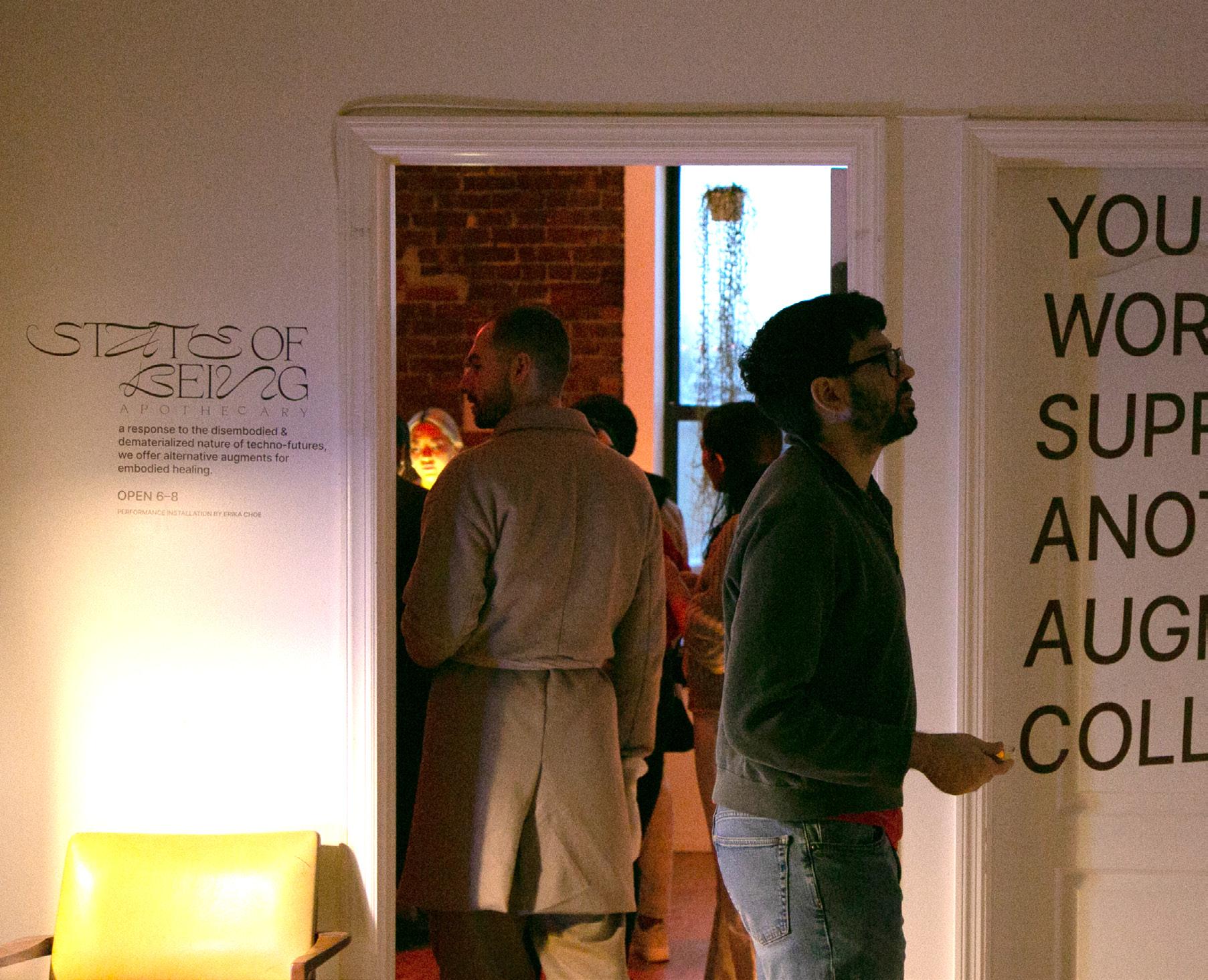
264
HOW WE PRESERVE OUR HUMANNESS IS CRUCIAL TO HOW OUR FUTURE UNFOLDS.
State of Being Apothecary was a performance installation that used magical realism as a response to the disembodied and dematerialized nature of our techno-futures.
It imagined a scenario where the focus of technological augmentation were presented through a post humanistic and anti-capitalist lens.
Challenging conventional norms of technological advancement, this experiment prompted its audience to question the dominant narratives of technological progress, inviting us to consider alternative futures where the well-being of our community and the environment takes precedence over profit-driven and competitive motives

265
PART FOUR: PRESERVING HUMANNESS FOR THE COLLECTIVE EXPERIMENT
HOW WE PRESERVE OUR HUMANNESS IS CRUCIAL TO HOW OUR FUTURE UNFOLDS.

266
Guests were first primed with large text wrapped and warped around the corner, mimicking the feeling of walking into a wormhole of a different dimension.
The experience journeyed through a walk-in appointment with the apothecary who offers a variety of alchemical remedies that are not what you would typically expect when you think of body healing.

267
PART FOUR: PRESERVING HUMANNESS FOR THE COLLECTIVE EXPERIMENT
HOW WE PRESERVE OUR HUMANNESS IS CRUCIAL TO HOW OUR FUTURE UNFOLDS.

PART FOUR: PRESERVING HUMANNESS FOR THE COLLECTIVE EXPERIMENT

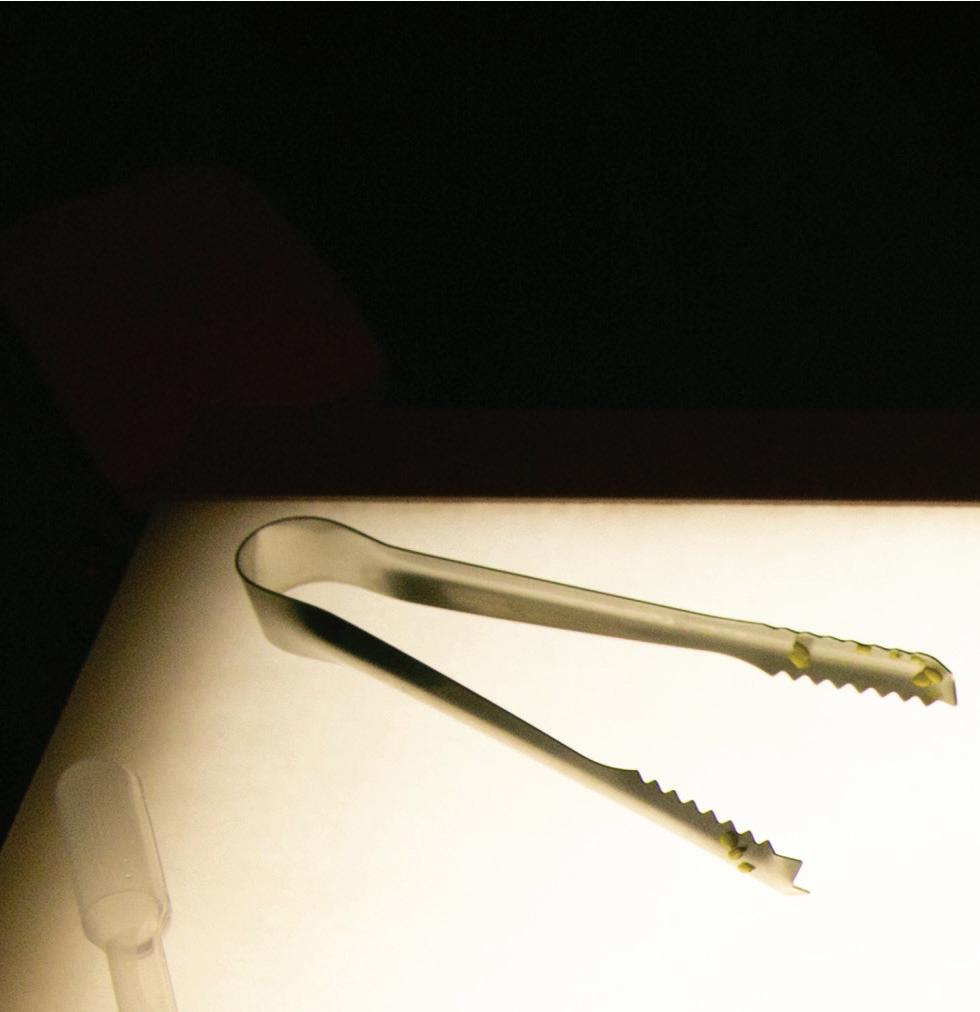


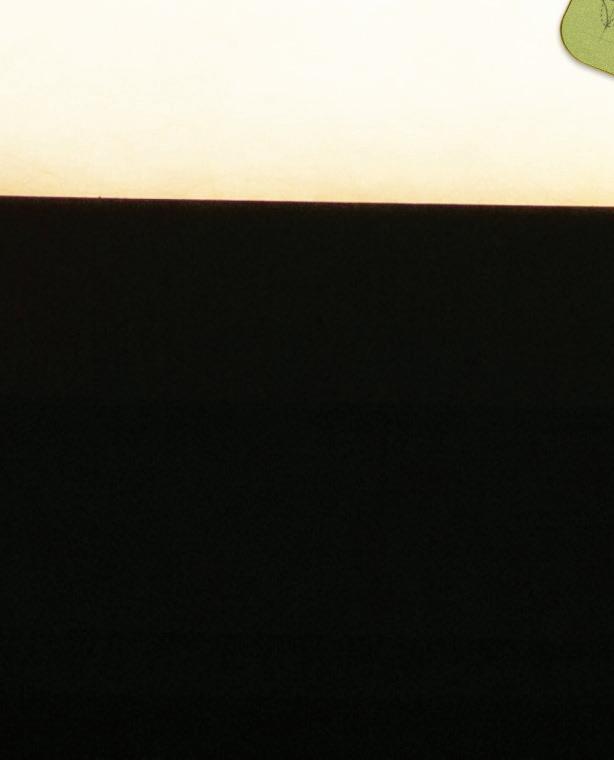


HOW WE PRESERVE OUR HUMANNESS IS CRUCIAL TO HOW OUR FUTURE UNFOLDS.






PART FOUR: PRESERVING HUMANNESS FOR THE COLLECTIVE EXPERIMENT
These were the alternate augments that offered transformation through ingestion and absorption.

HOW WE PRESERVE OUR HUMANNESS IS CRUCIAL TO HOW OUR FUTURE UNFOLDS.
I played the role of the apothecary that offered remedies which brought us together for one another.


PART FOUR: PRESERVING
COLLECTIVE EXPERIMENT
HUMANNESS FOR THE
HOW WE PRESERVE OUR HUMANNESS IS CRUCIAL TO HOW OUR FUTURE UNFOLDS.

274
PART FOUR: PRESERVING HUMANNESS FOR THE COLLECTIVE EXPERIMENT
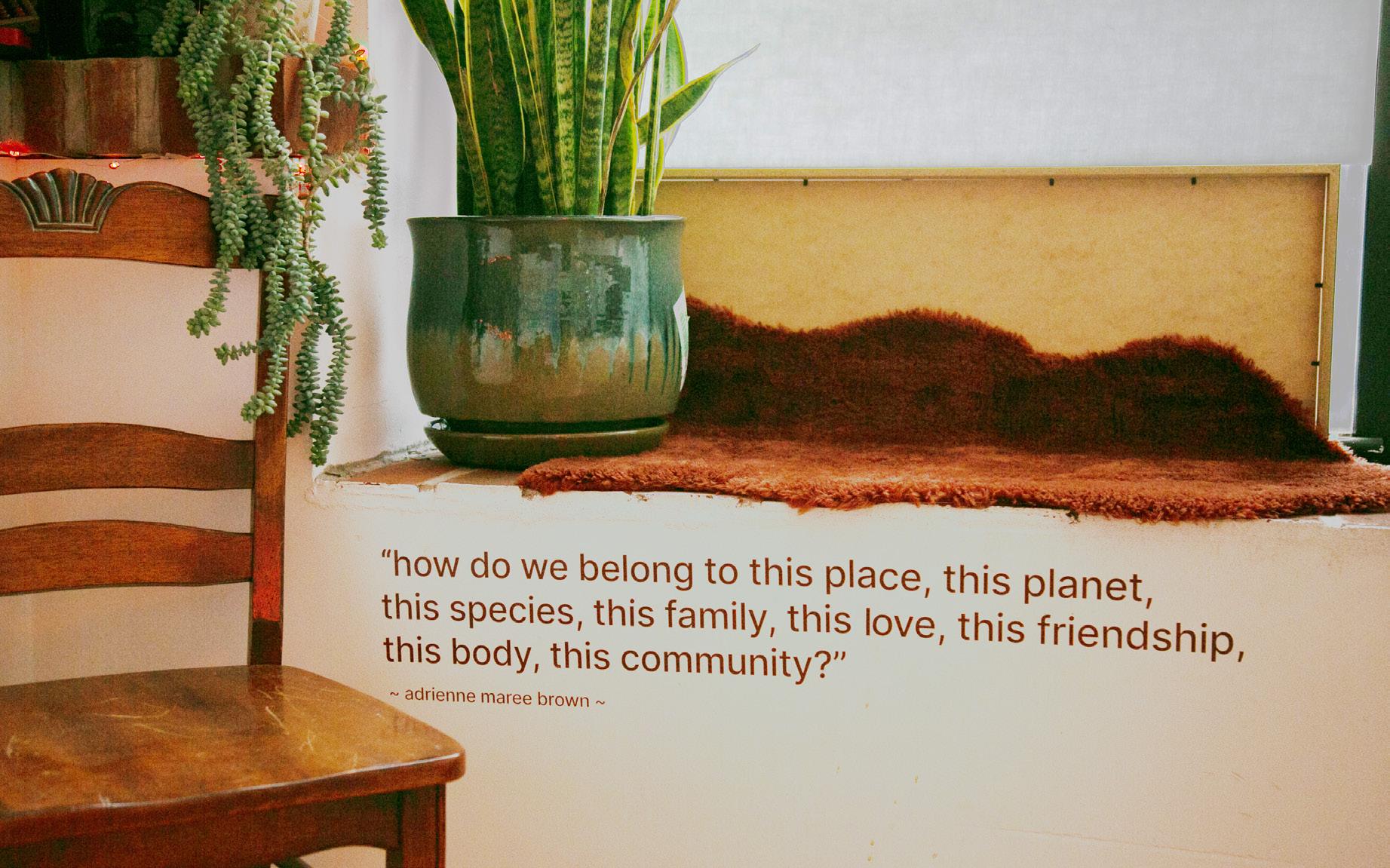
275

276
HOW WE PRESERVE OUR HUMANNESS IS CRUCIAL TO HOW OUR FUTURE UNFOLDS.
Beginning with an introspective reflection, guests were prompted to consider their present state of being.
They took a little time to fill out a diagnostic card where they selected statements that resonated with them like “I hesitate when making decisions” or “I struggle with interrupting others and find myself eager to respond”.

277
PART FOUR: PRESERVING HUMANNESS FOR THE COLLECTIVE EXPERIMENT
The apothecary assesses these cards and chooses an augment or two to offer from her deck of remedy cards.

These remedies presented a number of sensorial actions that tapped into wish fulfillment, some of which were edible and others were topical.

278
HOW WE PRESERVE OUR HUMANNESS IS CRUCIAL TO HOW OUR FUTURE UNFOLDS.
PART FOUR: PRESERVING HUMANNESS FOR THE COLLECTIVE EXPERIMENT

HOW WE PRESERVE OUR HUMANNESS IS CRUCIAL TO HOW OUR FUTURE UNFOLDS.


280


281
PART FOUR: PRESERVING HUMANNESS FOR THE COLLECTIVE EXPERIMENT
HOW WE PRESERVE OUR HUMANNESS IS CRUCIAL TO HOW OUR FUTURE UNFOLDS.

282

283
PART FOUR: PRESERVING HUMANNESS FOR THE COLLECTIVE EXPERIMENT
These remedies were served on petri dishes atop a glowing bar, designed to evoke the performance of treatments prepared in a futuristic lab.

284
HOW WE PRESERVE OUR HUMANNESS IS CRUCIAL TO HOW OUR FUTURE UNFOLDS.


285 PART FOUR: PRESERVING HUMANNESS FOR THE COLLECTIVE EXPERIMENT
HOW WE PRESERVE OUR HUMANNESS IS CRUCIAL TO HOW OUR FUTURE UNFOLDS.

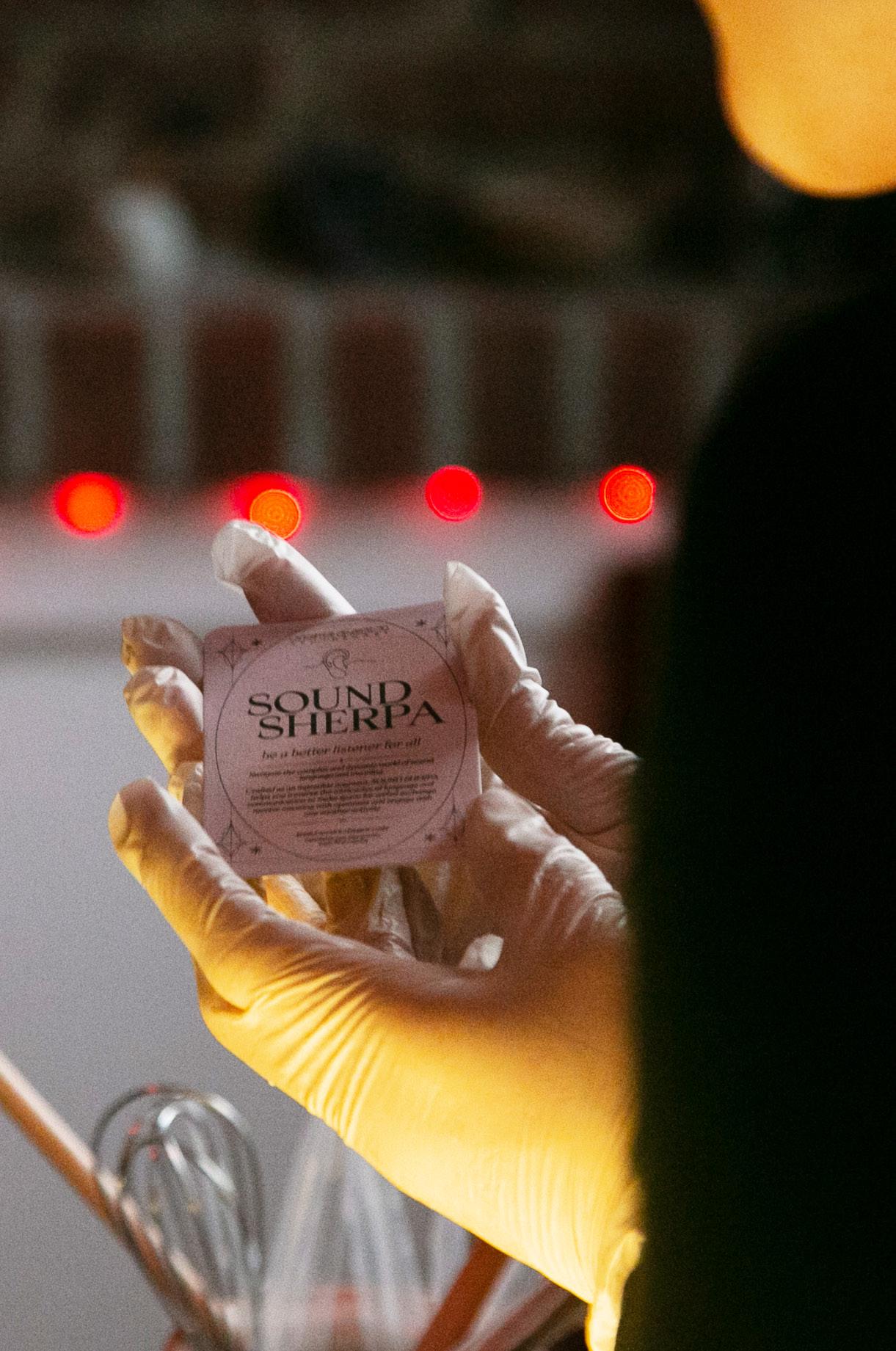
PART FOUR: PRESERVING HUMANNESS FOR THE COLLECTIVE EXPERIMENT

288 HOW WE PRESERVE OUR HUMANNESS IS CRUCIAL TO HOW OUR FUTURE UNFOLDS.
Sound Sherpa, which was a delicate jello semi-sphere that was injected with different colors to represent the intricacies of language and communication.

Its ingestion fulfilled the wish to be a better listener.
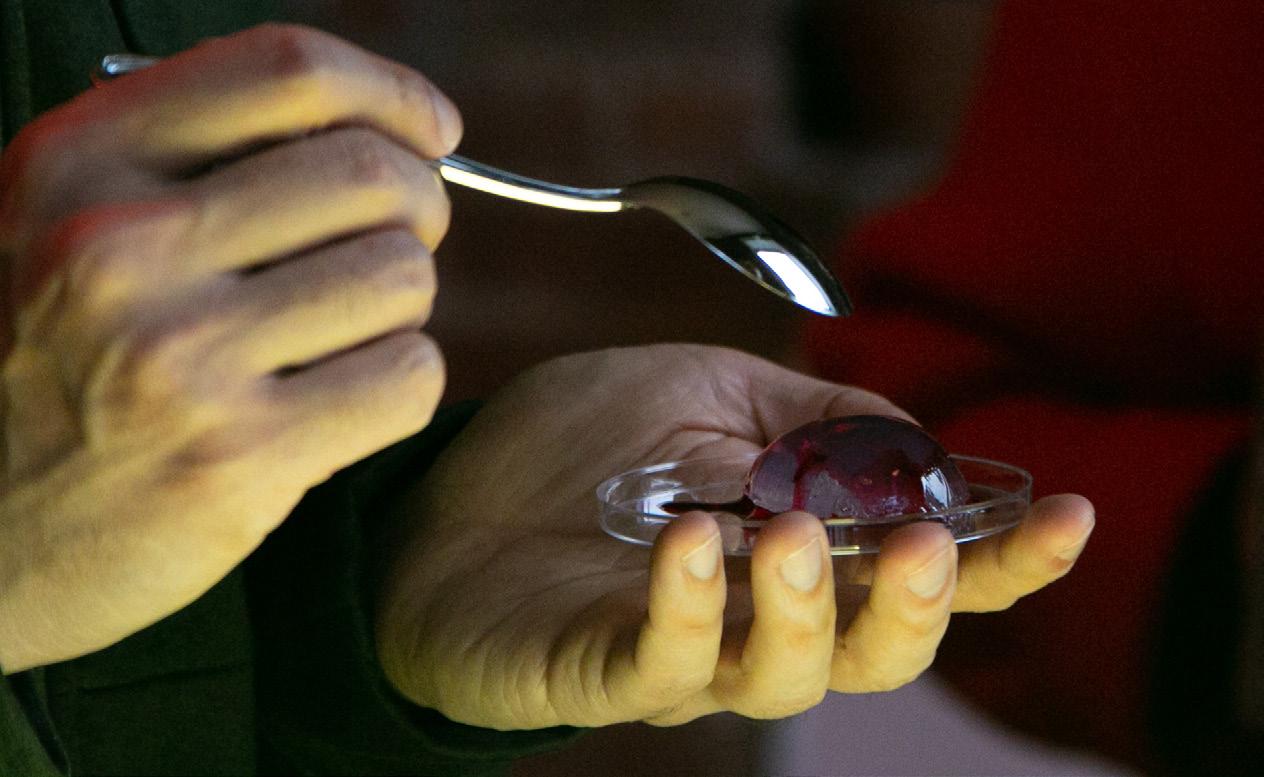
289
PART FOUR: PRESERVING HUMANNESS FOR THE COLLECTIVE EXPERIMENT
Vocal Valor was a sprinkling of pop rocks nested in a bed of cream, prompting the receiver to speak their truth confidently.

290
HOW WE PRESERVE OUR HUMANNESS IS CRUCIAL TO HOW OUR FUTURE UNFOLDS.

291
PART FOUR: PRESERVING HUMANNESS FOR THE COLLECTIVE EXPERIMENT
Soul sight, for recipients to see people for who they are rather than who we think they might be.


292
HOW WE PRESERVE OUR HUMANNESS IS CRUCIAL TO HOW OUR FUTURE UNFOLDS.


293 PART
PRESERVING
COLLECTIVE EXPERIMENT
FOUR:
HUMANNESS FOR THE
HOW WE PRESERVE OUR HUMANNESS IS CRUCIAL TO HOW OUR FUTURE UNFOLDS.


294
Second Brain, a delightful entanglement of translucent noodles drizzled with seasoning symbolizing the desire to better trust your gut.


PART FOUR: PRESERVING HUMANNESS FOR THE COLLECTIVE EXPERIMENT
The topical augments involved a more performative openness from the guests.

Lovers’ Reach was a personalized scented body butter that gets absorbed into the body through an intimate hand massage.

296
HOW WE PRESERVE OUR HUMANNESS IS CRUCIAL TO HOW OUR FUTURE UNFOLDS.


297 PART FOUR: PRESERVING HUMANNESS FOR THE COLLECTIVE EXPERIMENT
HOW WE PRESERVE OUR HUMANNESS IS CRUCIAL TO HOW OUR FUTURE UNFOLDS.
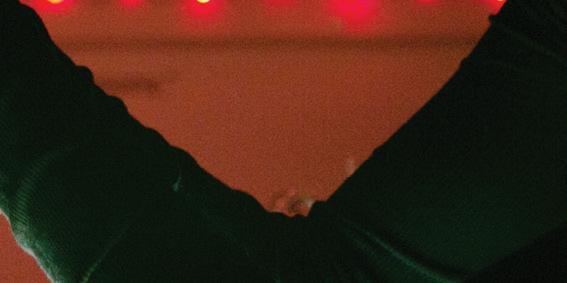



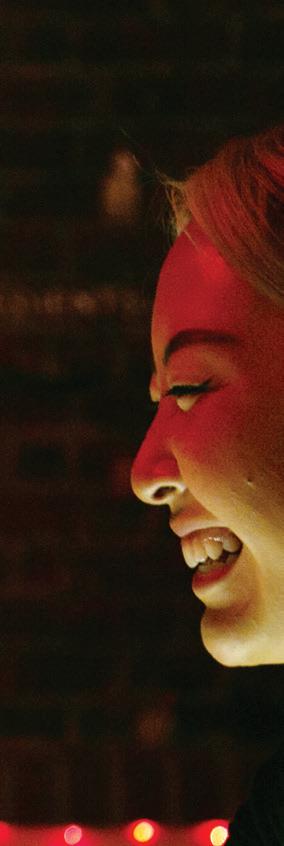



298
For the Vagal Toner remedy, recipients were prompted to run ice popsicles from the back of their ears down their necks to invigorate their vagus nerve - the longest cranial nerve responsible for taking us from fight or flight to rest and digest.



299
PART FOUR: PRESERVING HUMANNESS FOR THE COLLECTIVE EXPERIMENT
O2 Alchemy, which were lava rocks infused with personalized essential oils, asked recipients to engage with palm inhalation to oxygenate and rejuvenate their blood.

300
HOW WE PRESERVE OUR HUMANNESS IS CRUCIAL TO HOW OUR FUTURE UNFOLDS.
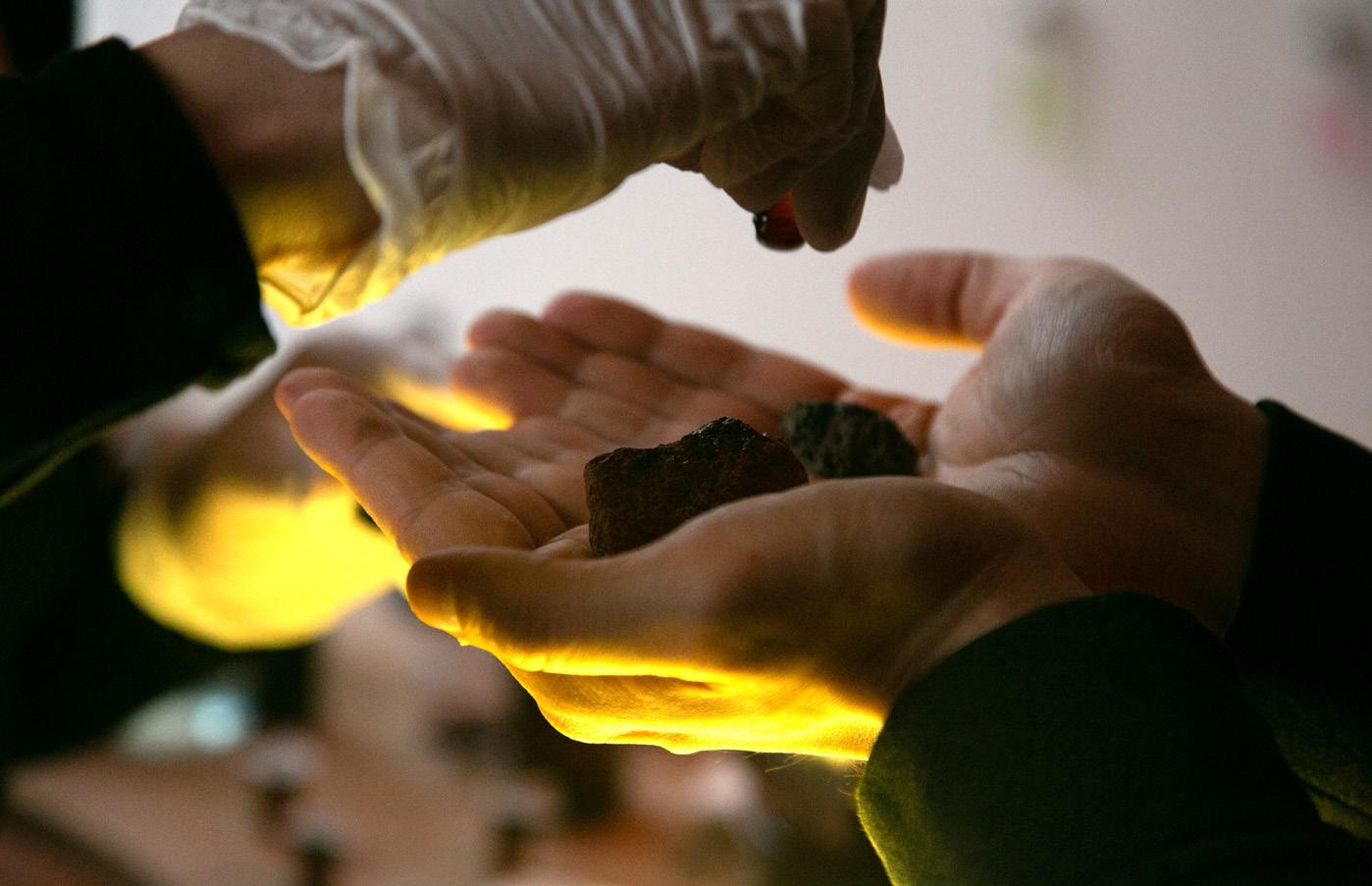
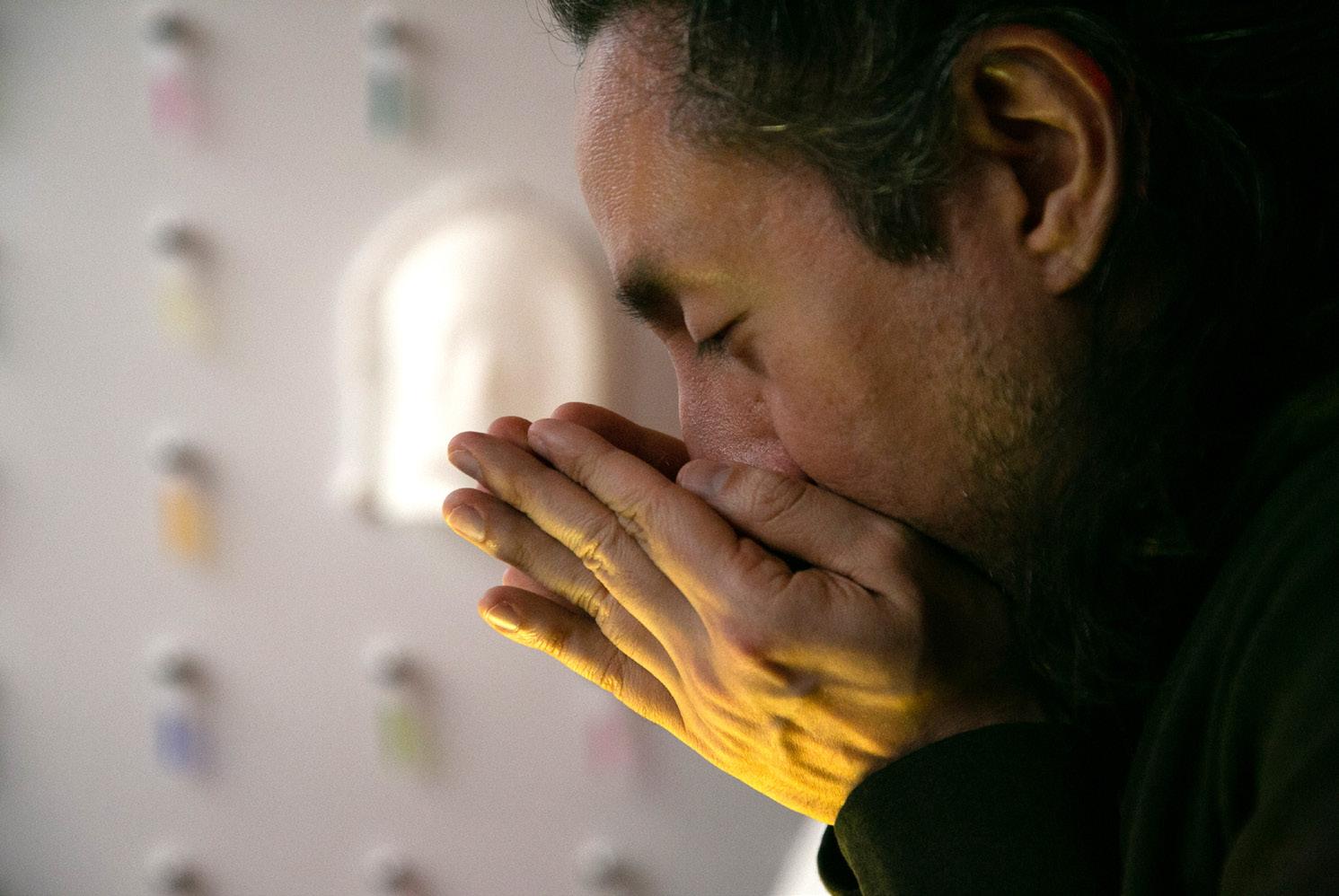
301
PART FOUR: PRESERVING HUMANNESS FOR THE COLLECTIVE EXPERIMENT
HOW WE PRESERVE OUR HUMANNESS IS CRUCIAL TO HOW OUR FUTURE UNFOLDS.



302
Spatial sensorium was a water-activated mask applied to symbolize a transformed and heightened proprioception when peeled off.
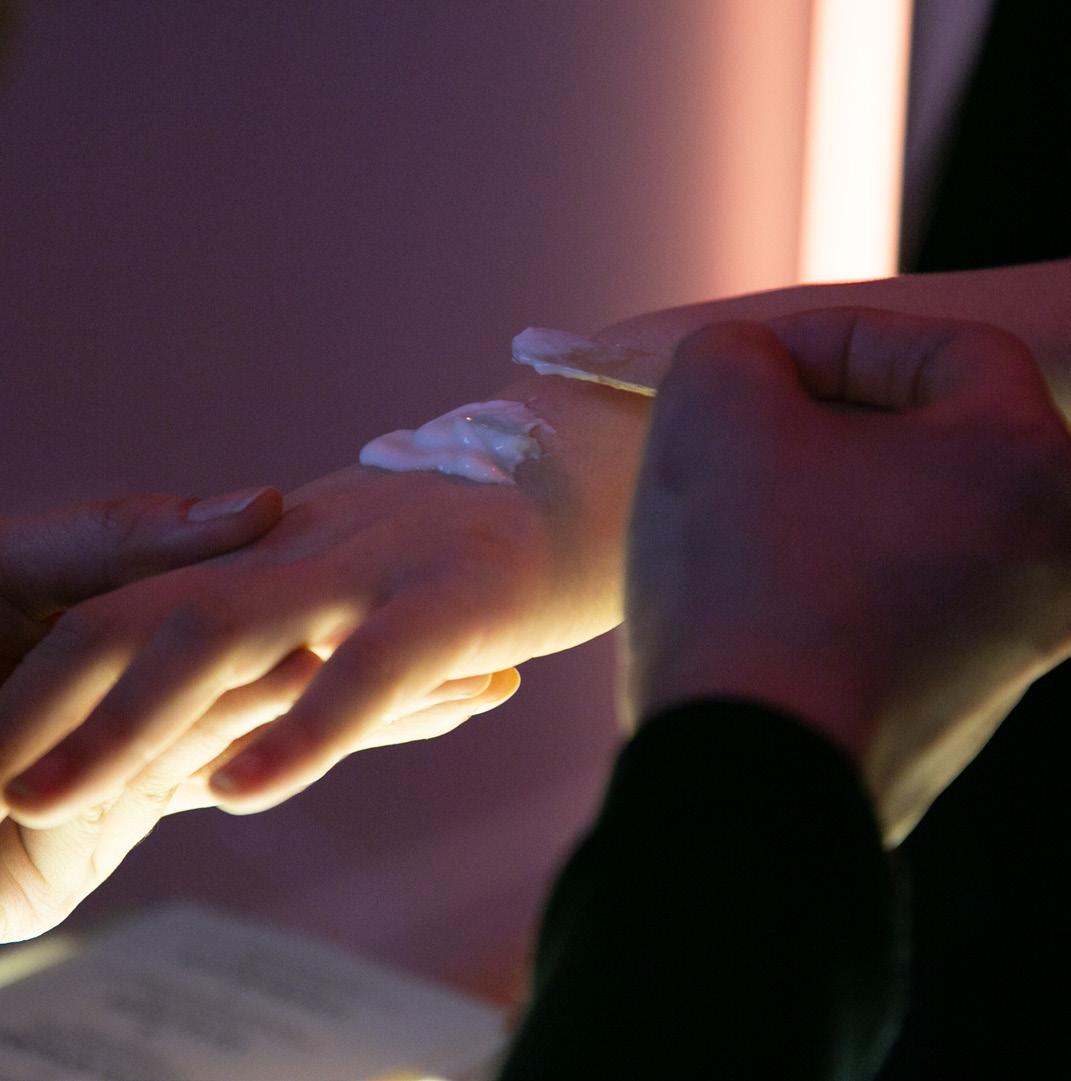

303
PART FOUR: PRESERVING HUMANNESS FOR THE COLLECTIVE EXPERIMENT
The performative act of receiving these remedies roleplays a transformative experience where participants leave feeling more in touch with their embodied lives, more in touch with what is around them, and more collectively connected.

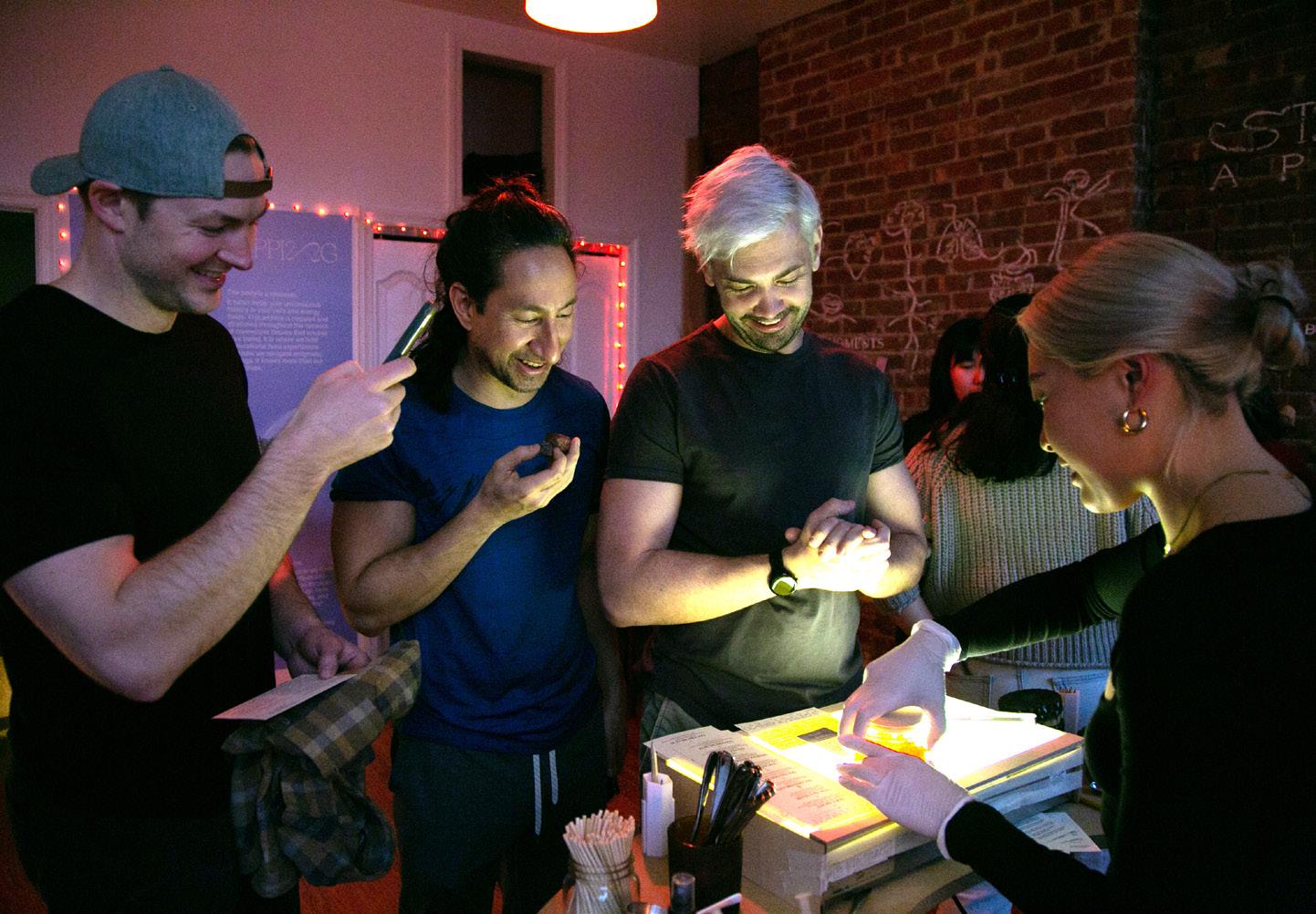
304
HOW WE PRESERVE OUR HUMANNESS IS CRUCIAL TO HOW OUR FUTURE UNFOLDS.


PART FOUR: PRESERVING HUMANNESS FOR THE COLLECTIVE EXPERIMENT
HOW WE PRESERVE OUR HUMANNESS IS CRUCIAL TO HOW OUR FUTURE UNFOLDS.


306
Rather than creating a whole bunch of hyper augmented individuals, we need to offer people the ability to be better with and for their communities.

307
This experiment made it clear that instead of enhancing our bodies, we need remedies that make us more meta-cognitive and empathetic for those around us.
PART FOUR: PRESERVING HUMANNESS FOR THE COLLECTIVE EXPERIMENT
HOW WE PRESERVE OUR HUMANNESS IS CRUCIAL TO HOW OUR FUTURE UNFOLDS.
308
SUBSECTION Ⓒ
THE PROBLEM EXPERIMENT
LEARNINGS
309 PART FOUR: PRESERVING HUMANNESS FOR THE COLLECTIVE LEARNINGS
Why do we crave drive-through transformation?
What habits have contributed to our obsession with onestop-shop solutions?
Where technology has become second-nature to our lives, how do we recover the magic of solid and tangible things that ground us in our state of being, so we no longer crave immediate gratification?
What is truly needed for successful reprioritization of our societal values towards our interconnectedness?
310
At the same time, the performance installation raised a larger issue that remains in this narrative –
HOW WE PRESERVE OUR HUMANNESS IS CRUCIAL TO HOW OUR FUTURE UNFOLDS.
These are some of the questions I’d like to explore in the future. I believe my research on this topic has only scraped the surface with what we can propose to inspire a shift in our behaviors to preserve our humanness.

311
PART FOUR: PRESERVING HUMANNESS FOR THE COLLECTIVE LEARNINGS
ALL PHOTOS BY WHITNEY BROWNE
312
313

CLOSING THOUGHTS

“If my nightmare is a culture inhabited by posthumans who regard their bodies as fashion accessories rather than the ground of being, my dream is a version of the posthuman that embraces the possibilities of information technologies without being seduced by fantasies of unlimited power and disembodied immortality, that recognizes and celebrates finitude as a condition of human being, and that understands human life is embedded in a material world of great complexity, one on which we depend for our continued survival. ◆

316
–
KATHERINE
HAYLES, HOW WE BECAME POSTHUMAN: VIRTUAL BODIES IN CYBERNETICS, LITERATURE, AND INFORMATICS
PRESERVING HUMANNESS WHERE BODIES & TECHNOLOGY MEET
◆ Hayles, N. Katherine. How We Became Posthuman: Virtual Bodies in Cybernetics, Literature, and Informatics. University of Chicago Press, 1999.
We live in a time that desperately needs rethinking and re-questioning of what shapes our lives. To preserve our humanness, we need to get comfortable in the uncomfortable, ask the hard questions that surface, and lean into the complexity and interconnectedness of issues within this technological hyperobject.

I round off my design experiments with personal thoughts that I collected for myself throughout the course of this thesis.
The first is a short excerpt of vows I wrote to myself as I work on developing my practice moving forward.
The second is a reminder of our magnificent body, that holds so much and is able to do so much. In this age where disembodied immortality is romanticized, I hope to do the opposite with my work.
Third, I share some changes I’ve started to make with my choice of words and prioritization of key terms. This list will continue to grow and change, but it is a starting point for shifting and protesting some of the inherent systems I’ve been conditioned into. I hope it inspires my readers to do the same.
Lastly, I hand over the final words to my editor, Olivia Howard, who has been my rock and guiding star throughout this book writing process.
317
CLOSING THOUGHTS
Instead of simplifying, Instead of an immediate reaction
Instead of trying to find solutions, Instead of slipping into dooms-day mentality,

PRESERVING HUMANNESS WHERE BODIES & TECHNOLOGY MEET
I vow to immerse myself in the complexity that makes things around us so beautifully interconnected.

I vow to give myself the space and grace to take as much time as I might need contemplating a thought.
I vow to dig deeper into the multi-faceted issues at hand – unravel small knots if I can – but more importantly – provide care, comfort and open doors to other avenues, rather than try to eliminate or resolve.
I vow to trust in the education of hope and desire to bring us closer to finding the little things that can steer us away from fearful futures.
CLOSING THOUGHTS



PRESERVING HUMANNESS WHERE BODIES & TECHNOLOGY MEET
THE BODY IS A HISTORIAN.
It tucks away your unconscious history in your cells and energy fields. This archive is mapped and stretched throughout the network of connective tissues that encase your being.

It is where we hold generational lived experiences and how we navigate enigmatic feelings.
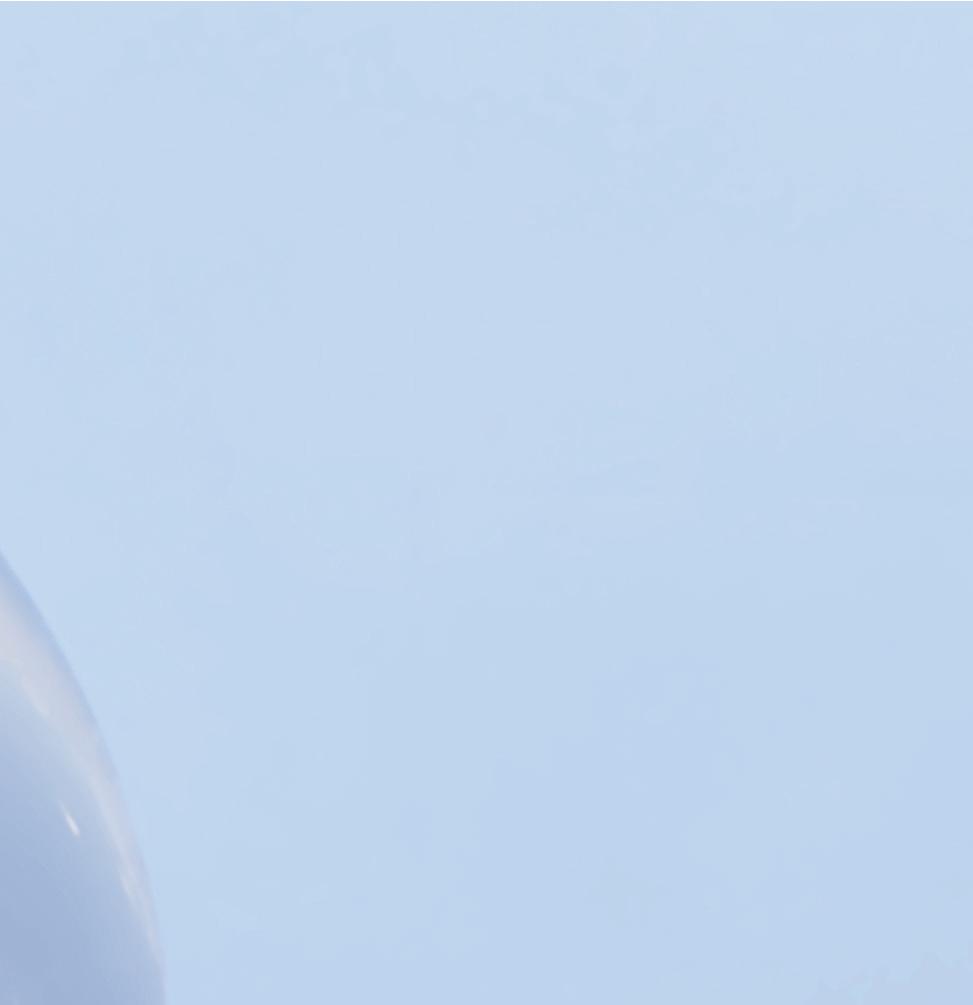
It knows more than our brain does.

CLOSING
THOUGHTS
THE BODY IS A MIRROR.
It reflects where you’ve been and what you’re ready to release. It talks to you constantly, cries out to you for healing and care, and trusts you in providing a lush future.
It responds to those around you, gesturing how you need to grow and what you need to heal. It bears the truths that we know.
It honors our promises to ourselves.



PRESERVING HUMANNESS WHERE BODIES & TECHNOLOGY MEET
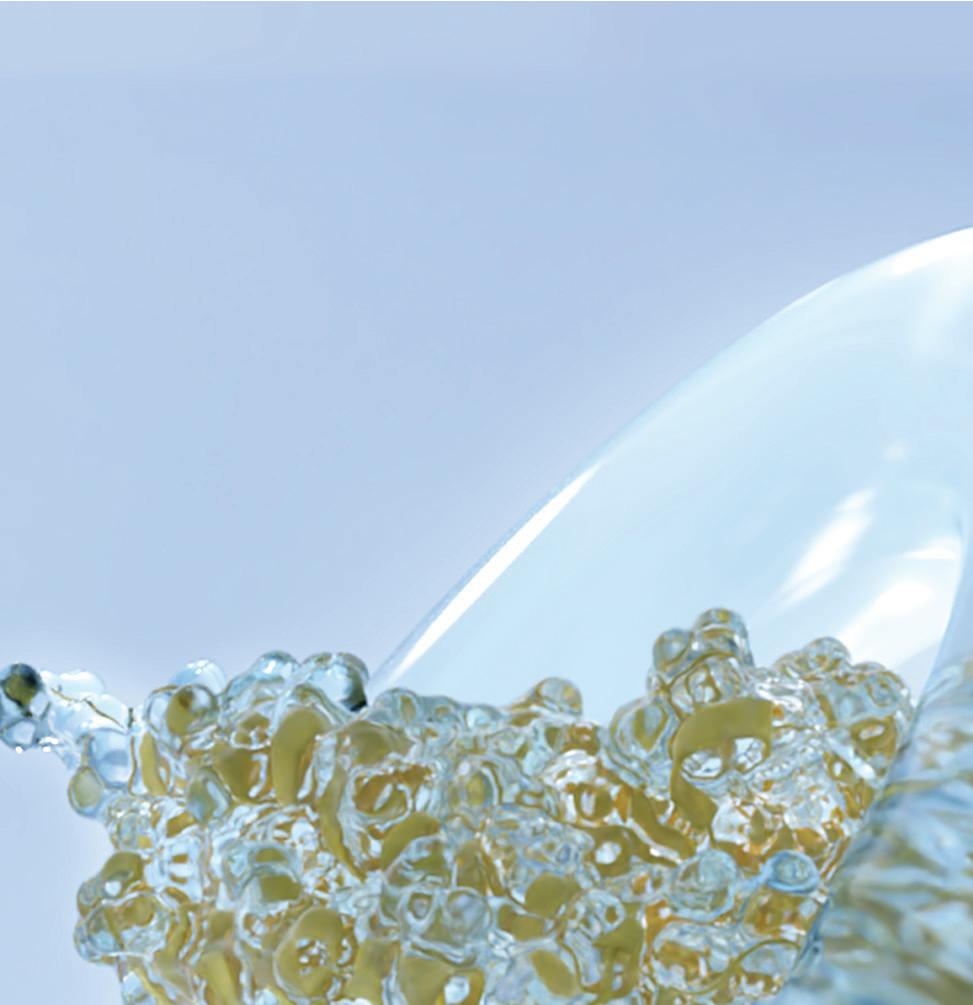


CLOSING THOUGHTS
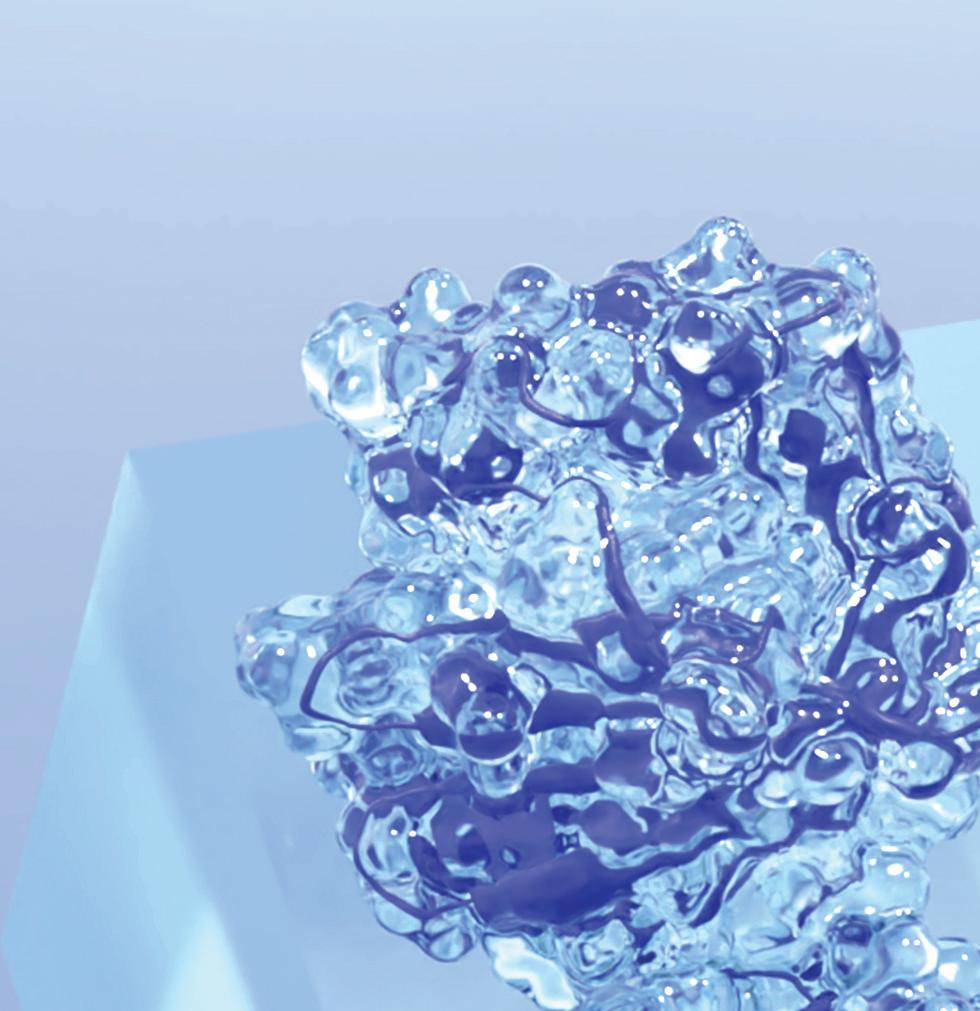


PRESERVING HUMANNESS WHERE BODIES & TECHNOLOGY MEET
THE BODY IS YOUR HOME.

It is the one faithful home we have in this lifetime. Where flesh and bone meet, it carries you through peaks and valleys, a refuge here to stay. It relates, reassures, and regenerates.

Our body is what makes us interdependent, connected with one another through our corporeality. Our body is what makes us human.

CLOSING THOUGHTS
INDIVIDUAL

FUTURE THINKING RECYCLE
OUT WITH THE OLD, IN WITH THE NEW FREEDOM (THATCHER/ INDIV)
PRESERVING HUMANNESS WHERE BODIES & TECHNOLOGY MEET
COLLECTIVE EMBRACING ANCESTRALITY AND FUTURALITY REGENERATIVE
MAINTENANCE & PRESERVATION

JUSTICE
(COLLECTIVE RESPONSIBILITY)
327 CLOSING THOUGHTS

AFTERWARD
 BY OLIVIA HOWARD
BY OLIVIA HOWARD

PRESERVING HUMANNESS WHERE BODIES & TECHNOLOGY MEET
Working with Erika on Preserving Humanness: Where Bodies and Technology Meet has been an illuminating and deeply insightful process. As a creative myself, it never ceases to amaze me the power that art has in shaping our experiences and impacting change. Through this process, I was regularly reminded of Julia Cameron’s wisdom in The Artist's Way:
“People frequently believe the creative life is grounded in fantasy. The more difficult truth is that creativity is grounded in reality, in particular, the focused, the well-observed or specifically imagined.”
Art, whether through design, movement, acting, or otherwise, is more often than not, the solution to the complex issues we face as humans today. It’s also the arts that are, more often than not, the first that are disregarded, defunded, and minimized.
Needless to say, it was a breath of fresh air to work with Erika on a project that sits at the intersection of art and technology. A project that understands that the most realistic problems require the most creative solutions. A project that is humanness, embodied.
May we all have the courage to move forward in creativity and hope, as we navigate this ever-changing world.
With gratitude, Olivia
331
AFTERWARD BY OLIVIA HOWARD

REFERENCES

Ai.nl. “What Are the AI Winters?” Ai.Nl, May 21, 2022. https:// www.ai.nl/knowledge-base/what-are-the-ai-winters/.
“Anthropocene,” n.d. https://education.nationalgeographic.org/resource/anthropocene/.
Banja, John D. “The Disability Movement’s Critique of Rehabilitation’s Medical Model: A Rebuttal.” AMA Journal of Ethics, June 1, 2015. https://doi.org/10.1001/journalofethics.2015.17.6.msoc1-1506.
Binkley, Charles E., Michael S. Politz, and Brian D. Green. “Who, If Not the FDA, Should Regulate Implantable Brain-Computer Interface Devices?” AMA Journal of Ethics 23, no. 9 (September 1, 2021): E745-749. https://doi.org/10.v1001/amajethics.2021.745.
Bonneuil, Christophe. The Shock of the Anthropocene: The Earth, History and Us. Verso Books, 2016.
Buckley, Cara. “‘OK Doomer’ and the Climate Advocates Who Say It’s Not Too Late.” The New York Times, March 26, 2022. https://www.nytimes. com/2022/03/22/climate/climate-change-ok-doomer.html.
ArtReview. “Byung-Chul Han: How Objects Lost Their Magic,” n.d. https:// artreview.com/byung-chul-han-how-objects-lost-their-magic/.
ArtReview. “Byung-Chul Han: ‘I Practise Philosophy as Art,’” n.d. https:// artreview.com/byung-chul-han-i-practise-philosophy-as-art/.
Centre, Ethics. “Ethics Explainer: Post-Humanism.” THE ETHICS CENTRE, April 2, 2023. https://ethics.org.au/ethics-explainer-post-humanism/.
Ciurria, Mich. “Transhumanism Is Eugenics for Educated White Liberals.” BIOPOLITICAL PHILOSOPHY, January 19, 2023. https://biopoliticalphilosophy. com/2023/01/19/transhumanism-is-eugenics-for-educated-white-liberals/.
Chwb. “Vagus Nerve: Its Function and the Benefits of Stimulating It.” The Center for Health and Wellbeing, May 27, 2022. https:// chwbonline.com/vagus-nerve-function-benefits-stimulating/.
Colomina, Beatriz, and Mark Wigley. Are We Human?: Notes on an Archaeology of Design. Lars Müller Publishers, 2016.
Conti, Maurice. “The Incredible Inventions of Intuitive AI,” n.d. https://www.ted. com/talks/maurice_conti_the_incredible_inventions_of_intuitive_ai?language=en.
Cuddy, Amy. “Your Body Language May Shape Who You Are,” n.d. https://www. ted.com/talks/amy_cuddy_your_body_language_may_shape_who_you_are/c.
Dalibert, Lucie. “Posthumanism and Somatechnologies : Exploring the Intimate Relations between Humans and Technologies,” 2014. https://doi.org/10.3990/1.9789036536516.
334
PRESERVING HUMANNESS WHERE BODIES & TECHNOLOGY MEET
Damasio, Antonio R., Thomas J. Grabowski, Antoine Bechara, Hanna Damasio, Laura L. Boles Ponto, Josef Parvizi, and Richard D. Hichwa. “Subcortical and Cortical Brain Activity during the Feeling of Self-Generated Emotions.” Nature Neuroscience 3, no. 10 (October 1, 2000): 1049–56. https://doi.org/10.1038/79871.
Darling, Kate. The New Breed: What Our History with Animals Reveals about Our Future with Robots. Henry Holt and Company, 2021.
David, Daniela Leite, Cosimo Giannini, Francesco Chiarelli, and Angelika Mohn. “Text Neck Syndrome in Children and Adolescents.” International Journal of Environmental Research and Public Health 18, no. 4 (February 7, 2021): 1565. https://doi.org/10.3390/ijerph18041565.
Adrienne Maree Brown - Awe. Liberation. Pleasure. “Distinguished and Singing – Adrienne Maree Brown,” March 26, 2021. https:// adriennemareebrown.net/2021/03/26/distinguished-and-singing/.
Groiss, Stefan Jun, Lars Wojtecki, Martin Südmeyer, and Alfons Schnitzler. “Review: Deep Brain Stimulation in Parkinson’s Disease.” Therapeutic Advances in Neurological Disorders 2, no. 6 (September 18, 2009): 379–91. https://doi.org/10.1177/1756285609339382.
“Experiment: Activate Your Sympathetic Nervous System,” n.d. https:// backyardbrains.com/experiments/Sympathetic_Nervous_System.
Fanjul, Sergio C., and El País. “Byung-Chul Han: ‘The Smartphone Is a Tool of Domination. It Acts like a Rosary.’” EL PAÍS English, October 15, 2021. https://english.elpais.com/usa/2021-10-15/byung-chul-han-thesmartphone-is-a-tool-of-domination-it-acts-like-a-rosary.html.
Flayton, Leigh, and Leigh Flayton. “How to Prevent ‘Tech Neck’” NewYork-Presbyterian, February 9, 2023. https://healthmatters.nyp.org/how-to-prevent-tech-neck/.
Futter, Michael. “Variety.” Variety, June 15, 2018. https://variety.com/2018/ gaming/features/state-of-mind-philosophy-1202847303/.
Geßner, Linda. “Where There Is No Vision, the People Perish: A Utopian Ethic for a Transformed Future | Essay by Ruth Levitas.” Centre for the Understanding of Sustainable Prosperity, February 13, 2022. https://cusp.ac.uk/themes/m/m1-5/.
Grady, Denise. “About the Idea That You’re Growing Horns From Looking Down at Your Phone ….” The New York Times, June 24, 2019. https://www. nytimes.com/2019/06/20/health/horns-cellphones-bones.html.
Han, Byung-Chul. “Philosopher Byung-Chul Han: Information Without Narrative Disrupts Democracy.” NOEMA, May 9, 2022. https://www. noemamag.com/all-that-is-solid-melts-into-information/.
———. The Disappearance of Rituals: A Topology of the Present. Polity, 2020.
335
REFERENCES
Haraway, Donna. Simians, Cyborgs, and Women. Routledge EBooks, 2013. https://doi.org/10.4324/9780203873106.
Hayles, N. Katherine. How We Became Posthuman: Virtual Bodies in Cybernetics, Literature, and Informatics. University of Chicago Press, 1999.
Hern, Alex. “Amazon Staff Listen to Customers’ Alexa Recordings, Report Says.” The Guardian, April 11, 2019. https://www.theguardian.com/technology/2019/ apr/11/amazon-staff-listen-to-customers-alexa-recordings-report-says.
Hestbæk, Lise, Charlotte Leboeuf-Yde, Kirsten Ohm Kyvik, and Claus Manniche. “The Course of Low Back Pain From Adolescence to Adulthood.” Spine 31, no. 4 (February 15, 2006): 468–72. https://doi.org/10.1097/01.brs.0000199958.04073.d9.
Howarth, Josh. “Alarming Average Screen Time Statistics (2023).” Exploding Topics (blog), January 13, 2023. https://explodingtopics. com/blog/screen-time-stats#:~:text=The%20latest%20figures%20 suggest%20the,on%20an%20internet%2Dconnected%20screen.
https://kurzweilai.net/. “We’ll Be Uploading Our Entire Minds to Computers by 2045 and Our Bodies Will Be Replaced by Machines within 90 Years, Google Expert Claims « Kurzweil,” n.d. https://www.kurzweilai.net/daily-mail-wellbe-uploading-our-entire-minds-to-computers-by-2045-and-our-bodieswill-be-replaced-by-machines-within-90-years-google-expert-claims.
Huff, Cynthia, and Margaretta Jolly. Engaging Donna Haraway: Lives in the Natureculture Web. Taylor & Francis, 2022.
Hutson, Matthew. “Prenatal Screening for Autism Is an Ethical Dilemma - Proto.Life.” Proto.Life, April 10, 2023. https://proto.life/2023/04/prenatalscreening-for-autism-is-an-ethical-dilemma/?utm_source=proto.life&utm_ campaign=42647359a9-EMAIL_CAMPAIGN_2023_04_05_09_39&utm_ medium=email&utm_term=0_-42647359a9-%5BLIST_EMAIL_ID%5D.
Khatchadourian, Raffi. “The Philosopher of Doomsday.” The New Yorker, November 16, 2015. https://www.newyorker.com/magazine/2015/11/23/ doomsday-invention-artificial-intelligence-nick-bostrom.
“Inner Cosmos – The Evolution of Depression Treatment,” n.d. https://innercosmos.io/.
Jungmann, Manuela, Shervin Vencatachellum, Dimitri M.L. Van Ryckeghem, and Claus Vögele. “Effects of Cold Stimulation on Cardiac-Vagal Activation in Healthy Participants: Randomized Controlled Trial.” JMIR Formative Research 2, no. 2 (October 9, 2018): e10257. https://doi.org/10.2196/10257.
LaBarre, Suzanne. “From Blind Optimism to Sober Responsibility: How Design Has Changed since the First Innovation by Design Awards.” Fast Company, March 12, 2021. https://www.fastcompany.com/90612231/from-blind-optimism-to-soberresponsibility-how-design-has-changed-since-the-first-innovation-by-design-awards.
336
PRESERVING HUMANNESS WHERE BODIES & TECHNOLOGY MEET
The Academy for Systems Change. “Leverage Points: Places to Intervene in a System - The Donella Meadows Project,” April 5, 2012. https://donellameadows. org/archives/leverage-points-places-to-intervene-in-a-system/.
Lopez, Kat. “Can We Compare Robots to Animals and Build Diverse Relationships With Them? — LDV Capital.” LDV Capital, June 7, 2022. https://www.ldv.co/blog/kate-darlingcan-we-compare-robots-to-animals-and-build-diverse-relationships-with-them.
Los Angeles Review of Books. “Making Kin: An Interview with Donna Haraway,” December 6, 2019. https://lareviewofbooks.org/ article/making-kin-an-interview-with-donna-haraway/.
Malchiodi, Cathy, PhD. “Understanding Fight, Flight, Freeze, and the Feign Response.” Psychology Today, June 15, 2021. https://www.psychologytoday.com/us/blog/artsand-health/202106/understanding-fight-flight-freeze-and-the-feign-response.
Malyk, Maria. “Facebook Data Privacy Scandal: Here's What You Need To Know.” Www.Easyllama.Com, February 22, 2023. https:// www.easyllama.com/blog/facebook-data-privacy-scandal/.
Meadows, Donella H. Thinking in Systems: A Primer. Chelsea Green Publishing, 2008.
Meis, Morgan. “Timothy Morton’s Hyper-Pandemic.” The New Yorker, June 8, 2021. https://www.newyorker.com/culture/ persons-of-interest/timothy-mortons-hyper-pandemic.
Pew Research Center: Internet, Science & Tech. “Mobile Fact Sheet,” May 11, 2023. https://www.pewresearch.org/internet/fact-sheet/mobile/.
Moody, Rebecca, and Rebecca Moody. “Screen Time Statistics: Average Screen Time in US vs. the Rest of the World.” Comparitech, March 15, 2023. https://www.comparitech.com/tv-streaming/screen-time-statistics/.
Morris, Chris. “Massive Data Leak Exposes 700 Million LinkedIn Users’ Information.” Fortune, June 30, 2021. https://fortune.com/2021/06/30/linkedindata-theft-700-million-users-personal-information-cybersecurity/.
Mullins, Aimee. “Changing My Legs - and My Mindset,” n.d. https://www. ted.com/talks/aimee_mullins_changing_my_legs_and_my_mindset.
Murakami, Haruki. 1Q84. Turtleback, 2013.
O’Gieblyn, Meghan. “God in the Machine: My Strange Journey into Transhumanism.” The Guardian, November 28, 2017. https://www.theguardian.com/technology/2017/ apr/18/god-in-the-machine-my-strange-journey-into-transhumanism.
HISTORY. “Oscar Pistorius Becomes the First Amputee Runner to Compete at the Olympics,” August 3, 2021. https://www.history.com/this-day-in-history/oscarpistorius-becomes-the-first-amputee-runner-to-compete-at-the-olympics.
Play Studio. “Neuralink.” Neuralink, n.d. https://neuralink.com/.
337
REFERENCES
Porges, Stephen W., and Senta A. Furman. “The Early Development of the Autonomic Nervous System Provides a Neural Platform for Social Behaviour: A Polyvagal Perspective.” Infant and Child Development 20, no. 1 (January 1, 2011): 106–18. https://doi.org/10.1002/icd.688.
Raits, Janis Savlovskis Kristaps. “Biomechanics of the Spine: The ROM of the Spine,” n.d. https://www.anatomystandard.com/biomechanics/spine/rom-of-spine.html.
Robertson, Adi. “Testing the CTRL-Labs Wristband That Lets You Control Computers with Your Mind.” The Verge, June 6, 2018. https://www.theverge.com/2018/6/6/17433516/ctrl-labsbrain-computer-interface-armband-hands-on-preview.
Rodriguez, Salvador. “Facebook Agrees to Acquire Brain-Computing Start-up CTRL-Labs.” CNBC, September 24, 2019. https://www.cnbc.com/2019/09/23/ facebook-announces-acquisition-of-brain-computing-start-up-ctrl-labs.html.
Rosahl, Steffen K. “Neuroprosthetics and Neuroenhancement: Can We Draw a Line?” AMA Journal of Ethics 9, no. 2 (February 1, 2007): 132–39. https://doi.org/10.1001/virtualmentor.2007.9.2.msoc2-0702.
Rugo, Daniele. “Posthuman.” Oxford Research Encyclopedia of Literature, July 30, 2020. https://doi.org/10.1093/acrefore/9780190201098.013.1136.
Sacasas, L. M. “The Questions Concerning Technology.” By L. M. Sacasas, June 5, 2021. https://theconvivialsociety.substack. com/p/the-questions-concerning-technology#details.
Sagan, Carl, and Ann Druyan. The Demon-Haunted World: Science as a Candle in the Dark. Ballantine Books, 1996.
Schoenfeld, Amy. “Soothing Back Pain by Learning How to Sit Again.” The New York Times, May 11, 2013. https://www.nytimes. com/2013/05/12/business/soothing-back-pain-by-learning-how-to-sitagain.html?action=click&module=RelatedLinks&pgtype=Article.
Seu, Mindy. Cyberfeminism Index. Inventory Press, 2023.
Shih, Jerry J., Dean J. Krusienski, and Johnathan R. Wolpaw. “BrainComputer Interfaces in Medicine.” Mayo Clinic Proceedings 87, no. 3 (March 1, 2012): 268–79. https://doi.org/10.1016/j.mayocp.2011.12.008.
Stone, Linda. “Just Breathe: Building the Case for Email Apnea.” HuffPost (blog), November 17, 2011. https://www.huffpost. com/entry/just-breathe-building-the_b_85651.
https://utswmed.org/medblog/tech-neck-pain-treatments/.
SPACE10. “The Augmented Human: How Technology Began to Merge With the Body
338
“‘Tech Neck’ Epidemic: How to Treat the Rise in Chronic Neck Pain | Back and Spine | Orthopaedics and Rehab | UT Southwestern Medical Center,” n.d.
PRESERVING HUMANNESS WHERE BODIES & TECHNOLOGY MEET
The Economist. “Wearable Devices Are Connecting Health Care to Daily Life.” The Economist, May 11, 2022. https://www.economist.com/technologyquarterly/2022/05/02/wearable-devices-are-connecting-health-care-to-daily-life. Synchron. “The Technology,” June 10, 2022. https://synchron.com/technology.
Times, New York. “Transcript: Ezra Klein Interviews L.M. Sacasas.” The New York Times, August 3, 2021. https://www.nytimes.com/2021/08/03/ podcasts/transcript-ezra-klein-interviews-lm-sacasas.html.
TollFreeForwarding.com. “From Text Claw to Tech Neck: How Technology Affects Our Bodies - TollFreeForwarding.Com,” January 7, 2022. https://tollfreeforwarding. com/blog/from-text-claw-to-tech-neck-how-technology-affects-our-bodies/.
Torres, Émile P. “Understanding "Longtermism": Why This Suddenly Influential Philosophy Is so Toxic.” Salon, August 20, 2022. https://www.salon.com/2022/08/20/understandinglongtermism-why-this-suddenly-influential-philosophy-is-so/.
Turpin, Etienne. Architecture in the Anthropocene: Encounters Among Design, Deep Time, Science and Philosophy. Open Humanities Press EBooks, 2013. https://doi.org/10.3998/ohp.12527215.0001.001.
Twenge, Jean M., and W. Keith Campbell. “Associations between Screen Time and Lower Psychological Well-Being among Children and Adolescents: Evidence from a Population-Based Study.” Preventive Medicine Reports 12 (December 1, 2018): 271–83. https://doi.org/10.1016/j.pmedr.2018.10.003.
“Ubuntu (Philosophy) - New World Encyclopedia,” n.d. https://www. newworldencyclopedia.org/entry/Ubuntu_(philosophy).
Vora, Ellen, MD. “Some Causes of Anxiety Are Physical. Here’s How to Recognize Them.” Washington Post, December 21, 2022. https://www. washingtonpost.com/wellness/2022/12/21/anxiety-body-responses/.
Walters, Helen. “Fake It ’til You Become It: Amy Cuddy’s Power Poses, Visualized,” n.d. https://blog.ted.com/fake-it-til-you-become-it-amy-cuddys-power-poses-visualized/. Wikipedia contributors. “Cogito, Ergo Sum.” Wikipedia, February 27, 2023. https:// en.wikipedia.org/wiki/Cogito,_ergo_sum#:~:text=The%20Latin%20cogito%2C%20 ergo%20sum,of%20Ren%C3%A9%20Descartes's%20philosophy.
———. “Damasio’s Theory of Consciousness.” Wikipedia, April 16, 2023. https://en.wikipedia.org/wiki/Damasio%27s_theory_of_consciousness.
Zahid, Jasmine. “A Defense of ‘The Case for Conserving Disability.’” AMA Journal of Ethics, April 1, 2016. https://doi.org/10.1001/journalofethics.2016.18.4.nlit2-1604.
339 | SPACE10,” January 26, 2023.
https://space10.com/project/the-augmented-human/.
REFERENCES
340
341

ACKNOWLEDGEMENTS

344
... to Olivia Howard for your exhaustive dedication and guidance in shaping these narratives. This book is as much yours as it is mine.
... to Starling Childs for your unwavering love, support and patience with me. I couldn’t have gotten here without you.
... to Zoe Galle for your willingness to share, exchange and marinate in our fertile conversations.
... to HK Dunston for your generosity with time, advice and mentorship throughout this process.
... to Corey McClelland, Charvi Shrimali, Jaemin Cho, Sarah Hackett, Kaylan Tran, Cathy Tung, Monica Albornoz, and the rest of my PeaPoD family for pushing me to reach further than I ever thought I could.
... to Pierre Alexandre de Looz for watering the roots of this work and believing in me.
... to Alexia Cohen for encouraging me to explore methodologies I was unfamiliar with.
... to Lizzy Zevallos and Whitney Browne for being there for me through and through as I worked out the intricacies of my design experiments.
... to Emily Kwok, Lauren McClelland, Gillian Ertel, Rufus de Rham, Quincy Childs, Mia Finley, Margarita Zulueta, Joseph Rauch, Jake Eisner for giving your time, attention and committment to help me through workshopping ideas and concepts throughout the year.
... to the SVA PoD staff and faculty, Allan Chochinov, Krissi Xenakis, Kristine Mudd, Bill Cromie, Megan Ford, Suma Reddy, Carly Ayres, Sinclair Smith, Emilie Baltz, and more for expanding my scope and helping me trust the process.
... to Dr Banu Onaral, Dr Kerem Dündar, Dr Hasan Ayaz, Martin Ross, Evie Cheung, and Eden Lew for being willing to talk with me, share your knowledge and allow me to learn from your expertise.
... to my parents and sister for supporting me in this journey and cheering me on.
... to Mindy Seu for inspiring me and sparking the genesis of this work.
... to Marko Manriquez, Kristina Lee, Elspeth Walker, Julia Knoll, Dominique Nurse for creating and maintaining an incredible space for magic to occur in the SVA studios.
345
THANK YOU...
346
... and to you for reading and going on this journey with me.
347
 BY ERIKA CHOE
Copyright 2023 by Erika Choe
BY ERIKA CHOE
Copyright 2023 by Erika Choe



















































































































































































































































































































































 BY OLIVIA HOWARD
BY OLIVIA HOWARD




